Paul van Yperen's Blog, page 249
December 23, 2018
The Black Pirate (1926)
The Black Pirate (Albert Parker, 1926) is a silent pirate adventure on the Southern seas, full of impressive stunts and shot entirely in two-tone Technicolor. Douglas Fairbanks stars as the son of a duke, who vows revenge on bloodthirsty pirates responsible for his father's death. He infiltrates their band and becomes 'The Black Pirate'. But his plans for revenge become complicated when he meets his first captive - a beautiful Spanish princess, played by Billie Dove. The pace never slows down, and the film is pure fun.
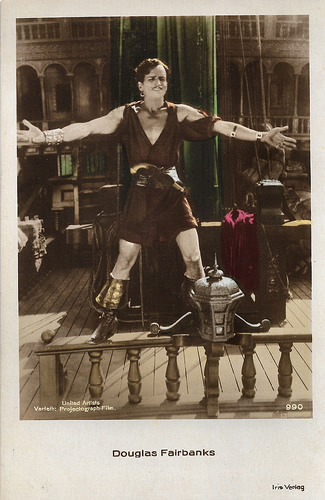
Austrian postcard by Iris Verlag, no. 990. Photo: United Artists / Projectograph-Film. Publicity still of Douglas Fairbanks in The Black Pirate (Albert Parker, 1926).
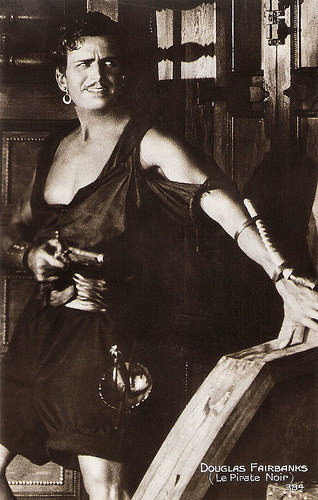
French postcard by Cinémagazine-Edition, Paris, no. 384. Photo: United Artists / Projectograph-Film. Publicity still of Douglas Fairbanks in The Black Pirate (Albert Parker, 1926).
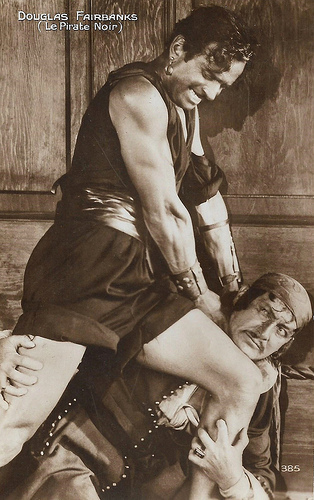
French postcard by Editions Cinémagazine, no. 385. Photo: United Artists. Publicity still of Douglas Fairbanks in The Black Pirate (Albert Parker, 1926).
Dead men tell no tales!
The Black Pirate (Albert Parker, 1926) begins with the looting of a ship already captured and badly mauled, by a band of bloodthirsty pirates. After relieving the ship and crew of valuables, the pirates bind the captives, blow up the gunpowder on board, and sink the ship. "Dead men tell no tales!" While the pirates celebrate, two survivors wash up on an island, the old Duke of Arnoldo and his son Michel ( Douglas Fairbanks ). Before dying, the old man gives his signet ring to his son, which Michel later uses to prove his identity. The young man buries his father, vowing vengeance: "My father I solemnly vow".
The nasty pirate captain (Anders Randolf) and and his lieutenant (Sam De Grasse) bring some crew to the other side of the same island to bury some of their plunder in an underwater cave. They then plan to murder the other pirates: "Dead men tell no tales." But first, Michel appears as the 'Black Pirate', who offers to join their company and fight their best man to prove his worth. After much fighting, the Black Pirate kills the captain.
The pirate lieutenant sneers, and says there is more to being a pirate than sword tricks. To further prove his worth, the Black Pirate says he will capture the next ship of prey single-handed, which he does. He then uses his wits to prevent the pirates from blowing up the ship along with the crew and passengers, suggesting that they hold the ship for ransom.
When a beautiful woman ( Billie Dove ) is discovered on board, the pirate lieutenant claims her. In love at first sight, the Black Pirate finds a way to temporarily save her from this fate by presenting her as a 'princess' and urging the crew to use her as a hostage to ensure their ransom will be paid, as long as she remains "spotless and unharmed".
The pirates cheer the Black Pirate, and want to name him captain. The pirate lieutenant jeers but consents to wait to see if the ransom is paid by noon the next day. However, he secretly has a confederate destroy the ransom ship later that night to ensure it will not return. Then, when the Black Pirate is caught trying to release the woman, the Pirate Lieutenant exposes him as a traitor and the pirates force him to walk the plank.
At noon the next day, with the ransom ship having failed to show, the pirate lieutenant goes to the woman to claim his prize. But just then, the Black Pirate, who with the help of the sympathetic one-armed pirate MacTavish (Donald Crisp) had survived being sent overboard, returns leading troops to stop the pirates. After a long fight, the pirates are routed. In the end, the Black Pirate is revealed to be a Duke, and the 'Princess' he loves a real noble Lady. Even MacTavish is moved to tears of joy by the happy ending.
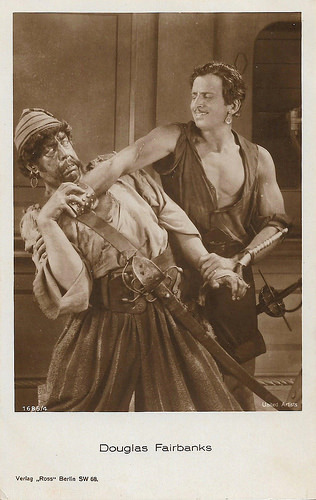
German postcard by Ross Verlag, no. 1686/1, 1927-1928. Photo: United Artists. Publicity still of Douglas Fairbanks in The Black Pirate (Albert Parker, 1926).
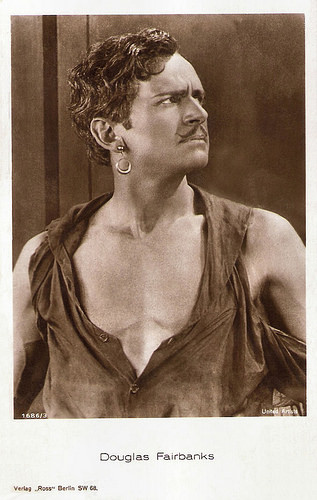
German postcard by Ross-Verlag, no. 1686/3, 1927-1928. Photo: United Artists. Publicity still for The Black Pirate (Albert Parker, 1926).
Walk the plank
The Black Pirate (Albert Parker, 1926) is a fast-moving, exciting and thrilling Swashbuckler and one of Douglas Fairbanks ' greatest films. It has all the classic ingredients of a pirate adventure: swordplay, torture, murder, robbery, kidnapping, romance with a princess, and even walking the plank. The stunts are still amazing today. Ron Oliver at IMDb : "Can any other swashbuckler top the flair or élan of the sequence where Doug captures a merchantman single-handed, climbing up the forecastle & sliding down the slit sails on his dagger, light as any sprite?" Fairbanks was already 43 when he performed this extraordinary stunt.
In addition, Fairbanks himself is the screenwriter of this rollicking adventure, using the pseudonym Elton Thomas. His scenario offers plenty of action – pirate raids, duels, even underwater photography The underwater swim by the seamen who arrived by longboat to help Fairbanks' character defeat the pirates, is an amazing scene, beautifully shot and daringly choreographed. United Artists Pictures offered a big budget and Fairbanks and his director Albert Parker used it for wonderful stunts and impeccable production values, such as appropriate ship shots and miniature sets.
Fairbanks felt that a pirate film had to be shown in colour. So The Black Pirate was filmed by Henry Sharp in two-tone Technicolor. This experimental colour system had been introduced in the feature Toll of the Sea (1922), and The Black Pirate was the third film to be produced in the process. Two-tone Technicolor reproduces a limited but pleasing range of colours. In the restored version, the bright red colour of blood is almost shocking to see, and the colours work well in the sweeping shots of the ocean and the ships at sea.
The sword-play in the film is dynamic and exciting and would influence many future Swashbuckler films. According to film historian Rudy Behlmer on the commentary track with the Kino DVD, Fred Cavens, the fencing master hired by Fairbanks became a staple of the industry. He later worked on such films as Captain Blood (Michael Curtiz, 1935) and The Adventures of Robin Hood (Michael Curtiz, William Keighley, 1938, both starring Errol Flynn .
The charismatic and athletic Fairbanks gives a bravura performance in the film, but the supporting cast also does a good job. Anders Randolf is an appropriately sinister villain. Truly hissable, he comes close to stealing the show in places. Sam de Grasse is also fine as the cunning lieutenant who chafes under The Black Pirate's leadership. Donald Crisp is funny as the salty old pirate who befriends Fairbanks. But Billie Dove plays a fairly typical damsel in distress type as the Princess. Her role is limited to looking pretty and swooning at the right moments.
Reportedly Douglas Fairbanks ' wife, Mary Pickford forbade her husband from kissing another woman, including any actress in his films. The final scene of The Black Pirate called for Fairbanks to kiss the Princess. So Mary was suitably costumed and facing away from the camera, she performed the final embrace herself as a stand-in for Billie Dove .
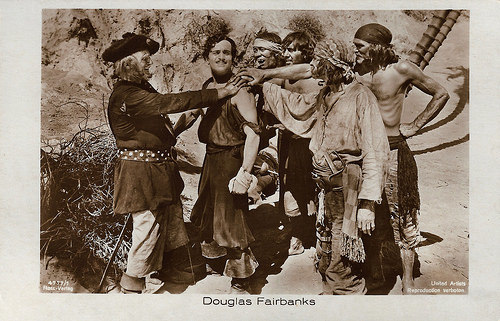
German postcard by Ross Verlag, no. 4777/1, 1929-1930. Photo: United Artists. Publicity still of Douglas Fairbanks in The Black Pirate (Albert Parker, 1926).
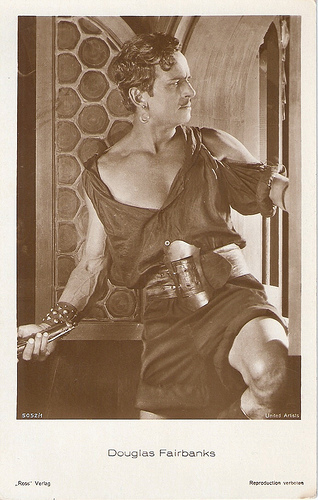
German postcard by Ross Verlag, no. 5052/1, 1930-1931. Photo: United Artists. Publicity still for The Black Pirate (Albert Parker, 1926).
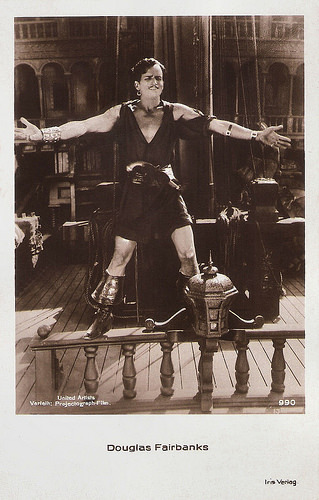
Austrian postcard by Iris Verlag, no. 990. Photo: United Artists / Projectograph-Film. Publicity still for The Black Pirate (Albert Parker, 1926).
Sources: Wikipedia and IMDb.

Austrian postcard by Iris Verlag, no. 990. Photo: United Artists / Projectograph-Film. Publicity still of Douglas Fairbanks in The Black Pirate (Albert Parker, 1926).

French postcard by Cinémagazine-Edition, Paris, no. 384. Photo: United Artists / Projectograph-Film. Publicity still of Douglas Fairbanks in The Black Pirate (Albert Parker, 1926).

French postcard by Editions Cinémagazine, no. 385. Photo: United Artists. Publicity still of Douglas Fairbanks in The Black Pirate (Albert Parker, 1926).
Dead men tell no tales!
The Black Pirate (Albert Parker, 1926) begins with the looting of a ship already captured and badly mauled, by a band of bloodthirsty pirates. After relieving the ship and crew of valuables, the pirates bind the captives, blow up the gunpowder on board, and sink the ship. "Dead men tell no tales!" While the pirates celebrate, two survivors wash up on an island, the old Duke of Arnoldo and his son Michel ( Douglas Fairbanks ). Before dying, the old man gives his signet ring to his son, which Michel later uses to prove his identity. The young man buries his father, vowing vengeance: "My father I solemnly vow".
The nasty pirate captain (Anders Randolf) and and his lieutenant (Sam De Grasse) bring some crew to the other side of the same island to bury some of their plunder in an underwater cave. They then plan to murder the other pirates: "Dead men tell no tales." But first, Michel appears as the 'Black Pirate', who offers to join their company and fight their best man to prove his worth. After much fighting, the Black Pirate kills the captain.
The pirate lieutenant sneers, and says there is more to being a pirate than sword tricks. To further prove his worth, the Black Pirate says he will capture the next ship of prey single-handed, which he does. He then uses his wits to prevent the pirates from blowing up the ship along with the crew and passengers, suggesting that they hold the ship for ransom.
When a beautiful woman ( Billie Dove ) is discovered on board, the pirate lieutenant claims her. In love at first sight, the Black Pirate finds a way to temporarily save her from this fate by presenting her as a 'princess' and urging the crew to use her as a hostage to ensure their ransom will be paid, as long as she remains "spotless and unharmed".
The pirates cheer the Black Pirate, and want to name him captain. The pirate lieutenant jeers but consents to wait to see if the ransom is paid by noon the next day. However, he secretly has a confederate destroy the ransom ship later that night to ensure it will not return. Then, when the Black Pirate is caught trying to release the woman, the Pirate Lieutenant exposes him as a traitor and the pirates force him to walk the plank.
At noon the next day, with the ransom ship having failed to show, the pirate lieutenant goes to the woman to claim his prize. But just then, the Black Pirate, who with the help of the sympathetic one-armed pirate MacTavish (Donald Crisp) had survived being sent overboard, returns leading troops to stop the pirates. After a long fight, the pirates are routed. In the end, the Black Pirate is revealed to be a Duke, and the 'Princess' he loves a real noble Lady. Even MacTavish is moved to tears of joy by the happy ending.

German postcard by Ross Verlag, no. 1686/1, 1927-1928. Photo: United Artists. Publicity still of Douglas Fairbanks in The Black Pirate (Albert Parker, 1926).

German postcard by Ross-Verlag, no. 1686/3, 1927-1928. Photo: United Artists. Publicity still for The Black Pirate (Albert Parker, 1926).
Walk the plank
The Black Pirate (Albert Parker, 1926) is a fast-moving, exciting and thrilling Swashbuckler and one of Douglas Fairbanks ' greatest films. It has all the classic ingredients of a pirate adventure: swordplay, torture, murder, robbery, kidnapping, romance with a princess, and even walking the plank. The stunts are still amazing today. Ron Oliver at IMDb : "Can any other swashbuckler top the flair or élan of the sequence where Doug captures a merchantman single-handed, climbing up the forecastle & sliding down the slit sails on his dagger, light as any sprite?" Fairbanks was already 43 when he performed this extraordinary stunt.
In addition, Fairbanks himself is the screenwriter of this rollicking adventure, using the pseudonym Elton Thomas. His scenario offers plenty of action – pirate raids, duels, even underwater photography The underwater swim by the seamen who arrived by longboat to help Fairbanks' character defeat the pirates, is an amazing scene, beautifully shot and daringly choreographed. United Artists Pictures offered a big budget and Fairbanks and his director Albert Parker used it for wonderful stunts and impeccable production values, such as appropriate ship shots and miniature sets.
Fairbanks felt that a pirate film had to be shown in colour. So The Black Pirate was filmed by Henry Sharp in two-tone Technicolor. This experimental colour system had been introduced in the feature Toll of the Sea (1922), and The Black Pirate was the third film to be produced in the process. Two-tone Technicolor reproduces a limited but pleasing range of colours. In the restored version, the bright red colour of blood is almost shocking to see, and the colours work well in the sweeping shots of the ocean and the ships at sea.
The sword-play in the film is dynamic and exciting and would influence many future Swashbuckler films. According to film historian Rudy Behlmer on the commentary track with the Kino DVD, Fred Cavens, the fencing master hired by Fairbanks became a staple of the industry. He later worked on such films as Captain Blood (Michael Curtiz, 1935) and The Adventures of Robin Hood (Michael Curtiz, William Keighley, 1938, both starring Errol Flynn .
The charismatic and athletic Fairbanks gives a bravura performance in the film, but the supporting cast also does a good job. Anders Randolf is an appropriately sinister villain. Truly hissable, he comes close to stealing the show in places. Sam de Grasse is also fine as the cunning lieutenant who chafes under The Black Pirate's leadership. Donald Crisp is funny as the salty old pirate who befriends Fairbanks. But Billie Dove plays a fairly typical damsel in distress type as the Princess. Her role is limited to looking pretty and swooning at the right moments.
Reportedly Douglas Fairbanks ' wife, Mary Pickford forbade her husband from kissing another woman, including any actress in his films. The final scene of The Black Pirate called for Fairbanks to kiss the Princess. So Mary was suitably costumed and facing away from the camera, she performed the final embrace herself as a stand-in for Billie Dove .

German postcard by Ross Verlag, no. 4777/1, 1929-1930. Photo: United Artists. Publicity still of Douglas Fairbanks in The Black Pirate (Albert Parker, 1926).

German postcard by Ross Verlag, no. 5052/1, 1930-1931. Photo: United Artists. Publicity still for The Black Pirate (Albert Parker, 1926).

Austrian postcard by Iris Verlag, no. 990. Photo: United Artists / Projectograph-Film. Publicity still for The Black Pirate (Albert Parker, 1926).
Sources: Wikipedia and IMDb.
Published on December 23, 2018 22:00
December 22, 2018
What Carla Bosch found in the attic
Some time ago our friend, collector Carla Bosch, decided to undertake an expedition to her attic and to inspect some boxes. Carla: "In one of those boxes I found 16 cards I forgot all about. I cannot remember when and where I bought them. They are rather large black and white cards, about 18 x 12 cm. On the back are the names of famous actresses in a language I know must be East European: Romy Schneiderova, Sophia Lorenova, Marilyn Monroeova, Brigitte Bardotova. Male actors, on the other hand, keep their name: Gérard Philipe, Tony Curtis, Jack Lemmon, Clark Gable. When I put some of the words through ‘Google Translate’, I found they were Czech cards. The Germans have a nice word for something you find, often unexpectedly, in your attic: Dachbodenfund. This is my Dachbodenfund.
If a Thousand Clarinets
Carla: "There are four cards of the movie Kdyby tisic klarinetu. “If a Thousand Clarinets” (English title) is a Czechoslovak movie released in 1965. It is a fantasy musical film about a mysterious statue of the composer Johann Sebastian Bach that changes guns into musical instruments. The news spreads and a television station decides to make a documentary film about the subject. My guess is that it must be something like how music can change people. And, more particular, how soldiers change when they are not holding guns, but music instruments instead... But that is just a wild guess.
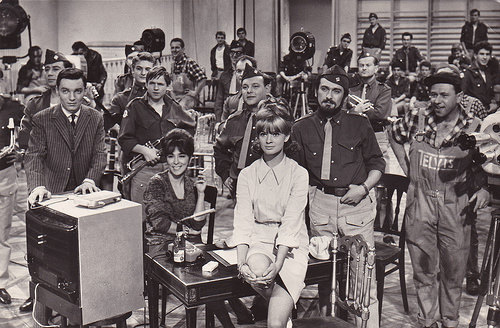
Czech postcard by Pressfoto, Praha (Prague). Photo: publicity still for Kdyby tisic klarinetu/If a Thousand Clarinets (Ján Rohác, Vladimír Svitácek, 1965) with at left Karel Gott and Jana Brejchova in white. Collection: Carla Bosch.
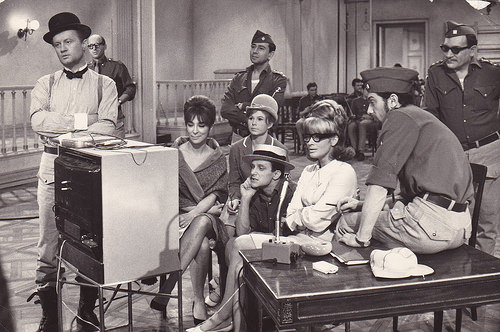
Czech postcard by Pressfoto, Praha (Prague). Photo: publicity still for Kdyby tisic klarinetu/If a Thousand Clarinets (Ján Rohác, Vladimír Svitácek, 1965). Collection: Carla Bosch.
I suspect that on these two cards are the film crew making the documentary. With Jana Brejchova , Waldemar Matuska, Hana Hegerova, Eva Pilarova, Karel Gott , Jiri Suchy, and Jiri Slitr. They are all watching a television. In the public are soldiers who are holding music instruments.
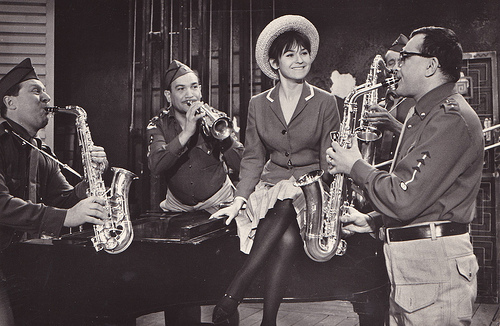
Czech postcard by Pressfoto, Praha (Prague). Photo: publicity still for Kdyby tisic klarinetu/If a Thousand Clarinets (Ján Rohác, Vladimír Svitácek, 1965) with Pavlina Filipovska. Collection: Carla Bosch.
Czech actress Pavlina Filipovska plays the role of landlady of a pension. In this picture she sits on a piano and four 'soldiers' are playing the saxophone.
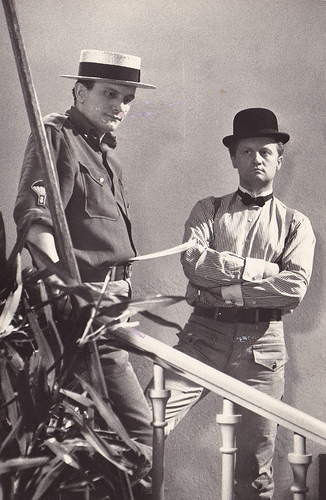
Czech postcard by Pressfoto, Praha (Prague). Photo: publicity still for Kdyby tisic klarinetu/If a Thousand Clarinets (Ján Rohác, Vladimír Svitácek, 1965) with Jiri Suchy and Jiri Slitr. Collection: Carla Bosch.
The fourth card is with Jiri Suchy and Jiri Slitr, both Czech actors. I read that Jiri Suchy was responsible for the story and Jiri Slitr composed the music. They also play a role in the movie; they are both paratroopers. In this picture they have cast off their military uniform and wear civilian clothes with cool hats.
I don’t know the Czech language. When I used Google Translate, I doubted Google’s translation skills. And as there was not much published about this movie in English, I had to make guesses. I did understand, however, that the film received some enthusiastic reviews. Although the subject, provide soldiers with music instruments and take away their guns, seems rather corny, it apparently touched a (musical?) string.
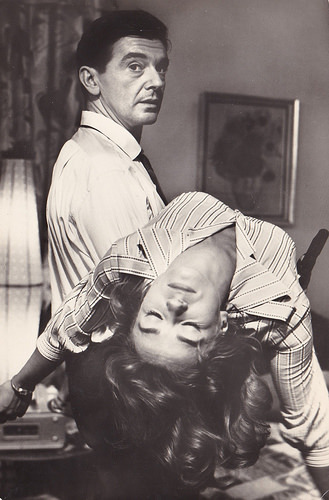
Czech postcard by Pressfoto, Praha (Prague). Photo: publicity still for Egy ember, aki nincs/Key to the Murder (Viktor Gertler, 1964). Collection: Carla Bosch.
There is one card of the movie Klic k Vrazde. In English Key to the Murder. Immediately my imagination ran wild in connection with this card: a murderer with a dead woman in his arms…. On the run and thinking where to hide the body. I tried to look up this movie on the internet, but I found there was not much to look up.
It is a Hungarian movie with Miklos Gabor and Eva Vass, who are both on the card, in the leading roles. Miklos Gabor was married to Éva Ruttkai and later to Eva Vass. I cannot find the marriage dates, because that might have provided a juicy gossip. So I think it is safe to conclude that Miklos murdered Eva and is looking around with an uncertain look on his face where to hide her. Maybe he did not kill her on purpose. Perhaps there are Czech readers or experts of Czech cinema who can comment on or clarify this mysterious picture?
The difficult postcards
I started to describe the 'difficult' postcards. It took a lot of time to find nothing. I think I must have bought these cards because of the more famous movie stars:
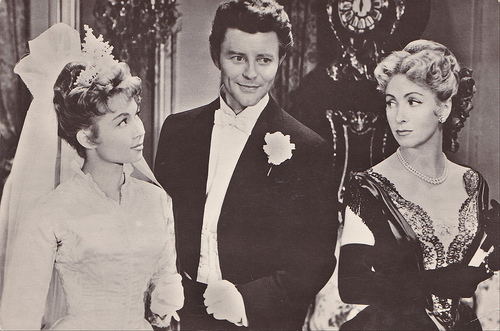
Czech postcard by Pressfoto, Praha (Prague). Photo: Dany Carrel , Gérard Philipe and Danielle Darrieux in the Émile Zola adaptation Pot Bouille/Lovers of Paris (Julien Duvivier, 1957) Collection: Carla Bosch.
For example Dany Carrelova , Gérard Philipe and Danielle Darrieuxova in the movie Pod Poklickou. I cannot help mentioning those names in Czech, because they look and sound rather funny. They have been given a Czech twist.
The movie’s original name is French: Pot-Bouille. It was released in 1957, based on Emile Zola’s novel of the same name. The English title is “Lovers of Paris”. Dany Carrel is in love with Gérard Philipe , but Gerard only has eyes for Danielle Darrieux who is too haughty to notice him. In the end Dany is married to someone else, but is Gerard’s mistress. Danielle is widowed and suddenly sees Gerard as a man who has possibilities. I know this summary is simplistic and does not do the movie justice, but perhaps we now understand the look on the faces in the picture.
The next two cards are with world-famous film stars: Romy Schneiderova and Sophia Lorenova . They are two of the leading stars in Boccaccio, the original title being Boccaccio ’70. There are two other leading ladies in this movie: Anita Ekberg(ova) and Marisa Solinas(ova), but I don’t have a card of them, at least, not a Czech one that belongs to this series.
Boccaccio '70 is a collection of four different movies directed by four different directors. Each story describes a different aspect of love and morality. Giovanni Boccaccio did something similar in his 'Decameron' but that was in the 14th century and is a frame story consisting of 100 tales.
Boccaccio ‘70 was released in 1962 (and has 4 tales).
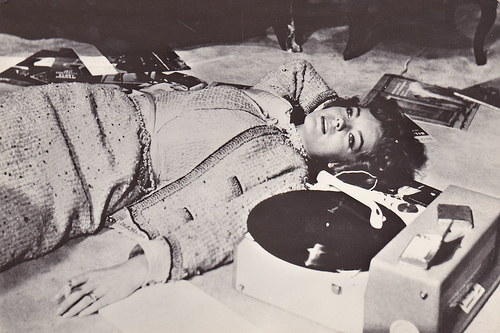
Czech postcard by Pressfoto, Praha (Prague). Photo: publicity still for in the episode Il lavoro/The Job by Luchino Visconti, part of the episodefilm Boccaccio '70 (1962). Collection: Carla Bosch.
The first card with Romy Schneider is the story Il lavoro about a woman who finds out that her husband visits prostitutes. The pair is financially dependent on her father who stops his financial support after he gets wind of his son-in-law’s escapades. Romy decides to take matters in her own hand and to become an independent woman by earning her own money. She will neither be dependent on her father or her husband!
The card shows Romy lying on the floor next to a record player with a cigarette in her hand. Perhaps she ponders on how to make her husband pay for his infidelity, how to win him back, and how to be a strong financially independent woman at the same time. I don’t know whether the end is satisfactory in that respect, because she humiliates her husband and makes him cringe like a worm and she makes it clear to him she is more sensual and sexually attractive than the callgirls he pays. So far for being an independent working girl, she did save her marriage.

Czech postcard by Pressfoto, Praha (Prague). Photo: publicity still for Boccaccio '70 (Vittorio De Sica a.o., 1962) with Sophia Loren . Collection: Carla Bosch.
The second card with Sophia Loren is the story La riffa about a lottery. Sophia works in a fairground attraction and is the grand prize in a lottery. The man who has the winning lottery ticket is allowed to spend the night with Sophia. A great deal of the film is about the efforts of the horny visitors to the fairground to obtain the winning ticket. Sophia, however, falls in love with a handsome young visitor to the carnival. When a nerdy, shy man is the winner of the night with Sophia, they pretend to spend the night together and let everybody think they did it. The nerdy man is considered a hero, and Sophia escapes with the man she fell in love with. Hmm…
About the card: we see Sophia on a bed with a man in front of her. We only see the man’s back; he is balding. Sophia looks at something else than the man and has her mouth open. Perhaps this is the scene in which Sophia and the winner spend the night and have to pretend: Sophia screams and they both make the bed move.… I do not have the faintest idea. It is a very nice card with Sophia Loren, however.
A new ‘mixed’ society of old money and nouveau riche
Two cards are of the movie Gepard, Czech for Il Gattopardo/The Leopard, an Italian movie with Alain Delon , Claudia Cardinalova , and Burt Lancaster released in 1963. Burt Lancaster plays the role of Prince of Salina, Alain Delon his nephew, and Claudia Cardinale is the mayor’s daughter. The movie is about a rapidly changing society and a fading past. Lancaster plays an aristocratic elegant nobleman enjoying the wealth and privileges that are inherent to his title and name, symbolising the ‘old world’. The mayor on the other hand has become rich by land speculation, representing the nouveau riche, ‘the new world’.
Alain Delon , heir to the old world, falls for Claudia Cardinale , heiress to the new world. Burt reluctantly agrees to a marriage between Alain and Claudia. The film ends with a spectacular ball, a scene that lasts for 45 minutes. Burt realises he is becoming a relic from the past. Had he been born two decades later, he might have married Claudia himself.
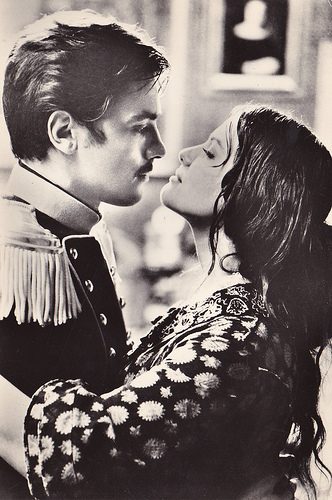
Czech postcard by Pressfoto, Praha (Prague). Photo: publicity still for Il Gattopardo/The Leopard (Luchino Visconti, 1963) with Alain Delon and Claudia Cardinale . Collection: Carla Bosch.
On this card we see Alain Delon and Claudia Cardinale , the couple that will start a new ‘mixed’ society of old money and nouveau riche.
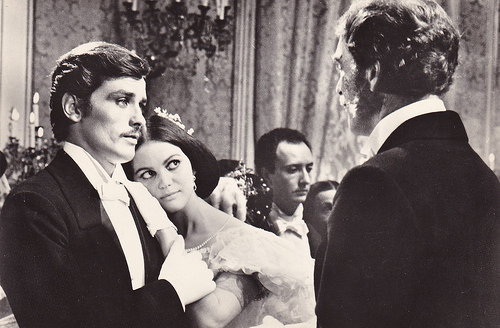
Czech postcard by Pressfoto, Praha (Prague). Photo: publicity still for Il Gattopardo/The Leopard (Luchino Visconti, 1963) with Alain Delon , Claudia Cardinale and Burt Lancaster . Collection: Carla Bosch.
I guess this picture is of the ball scene. We see the young couple looking at old Burt. Alain is looking serious, Claudia is hanging on his shoulder and looks coyly at Burt. With the old and new world in mind, the picture conveys quite a different meaning.
Brigitte Bardotova
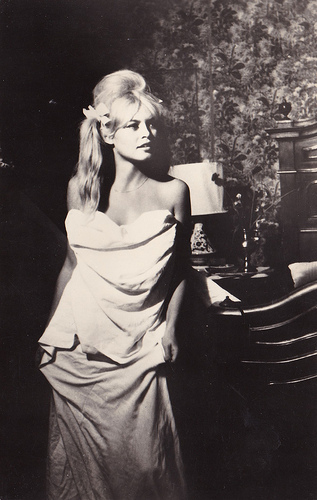
Czech postcard by Pressfoto, Praha (Prague). Photo: publicity still for Vie privée/A Very Private Affair (Louis Malle, 1962). Collection: Carla Bosch.
And now Brigitte Bardotova in Soukromy Zivot or Vie Privée, released in 1962. Brigitte Bardot plays a girl who lives in Switzerland with her widowed mother. She is infatuated with Marcello Mastroianni who is married to a friend of hers, unfortunately. There is some unclarity on the different sites that discuss this movie. Some say Marcello is married to her friend, others say he is her mother’s ex-lover. Perhaps he is both. Anyway, Brigitte has had it in Switzerland and moves to Paris where she becomes a famous movie star and model. She experiences the negative aspects of such a career: she does not have a private life and is regarded as public property.
She returns to Switzerland where she finds Marcello divorced, fortunately. They start an affair, but the fans and paparazzi claim her again. She trusts Marcello to protect her from the intrusive press that hounds her. But Marcello, a film director himself, seems more interested in a play he is directing. Brigitte becomes depressed and withdraws from public life. It could have been the story of Brigitte Bardot herself, the actress and model! Brigitte was 28 when she played the leading role in A Very Private Affair, but she apparently had great foresight. The film was not a great success. Yet, rather interesting as we look at it through new eyes perhaps? I don’t know what to make of the postcard. We see Brigitte wrapped in a bed sheet. The bed is behind her. She looks lovely in that sheet.
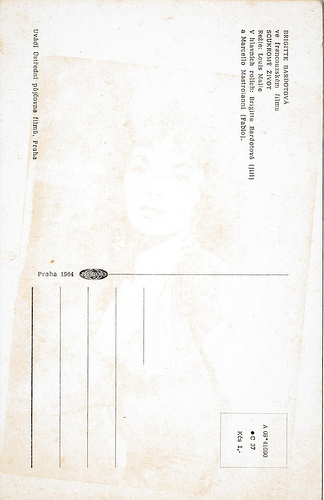
The postcard’s back is interesting too: if you look closely, you can see an image of…. Gina Lollobrigida !
The cards were probably stored close together, nearly glued together so that Gina left an imprint on Brigitte’s back. Unfortunately the card with Lollobrigida was not in the package I bought.
Well, nobody’s perfect
There are three cards of the movie Nekdo To Rad Horke, or Some Like It Hot, released in 1959.
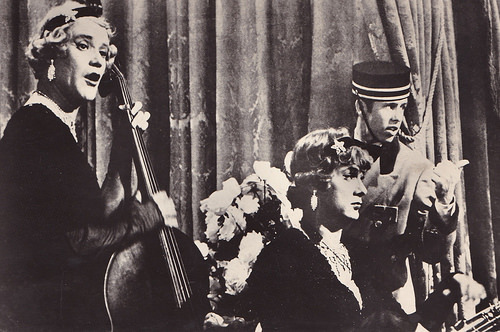
Czech postcard by Pressfoto, Praha (Prague). Photo: publicity still for Some Like it Hot (Billy Wilder, 1959) with Jack Lemmon and Tony Curtis. Collection: Carla Bosch.
The first card is with Jack Lemmon and Tony Curtis, two musicians who are on the run after they have witnessed a murder. They dress up as women and join a female jazz-band. In this picture they are playing a bass (Jack Lemmon), and a saxophone (Tony Curtis). Tony is in love with Marilyn, but cannot tell her he is a man, so instead he tries to become best friends with her.
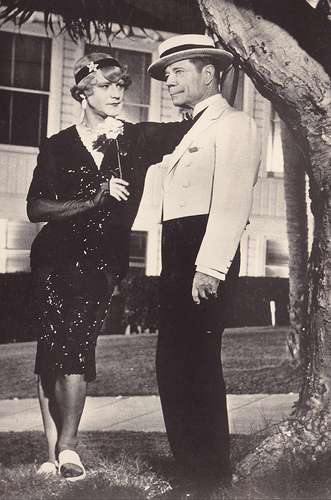
Czech postcard by Pressfoto, Praha (Prague). Photo: publicity still for Some Like it Hot (Billy Wilder, 1959). Collection: Carla Bosch.
The second card is with Jack Lemmon and Joe E. Brown. Joe is a millionaire and in love with Jack Lemmon. Jack cannot tell either he is a man, so he goes through with it, but eventually has to confess to Joe he is a man when Joe asks to marry him. Joe is in love and won’t be deterred: “Well, nobody’s perfect”.
The topics of homosexuality and men wearing drag costumes and make-up were taboo in those days. But times have changed. It is considered to be one of the best films and comedies of all times.
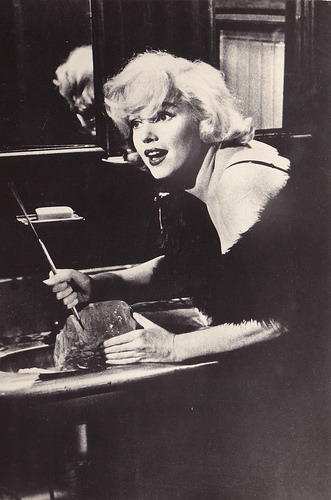
Czech postcard by Pressfoto, Praha (Prague). Photo: publicity still for Some Like it Hot (Billy Wilder, 1959) with Marilyn Monroe . Collection: Carla Bosch.
The third card is with Marilyn cutting up something. Honestly, I saw the movie twice, but I cannot for the life of me remember what Marilyn is cutting. I have to watch it a third time. (It's ice, ed.)
Then there is one card of the film Mustangove, or The Misfits. Released in 1961, with, of course Marilyn Monroeova .
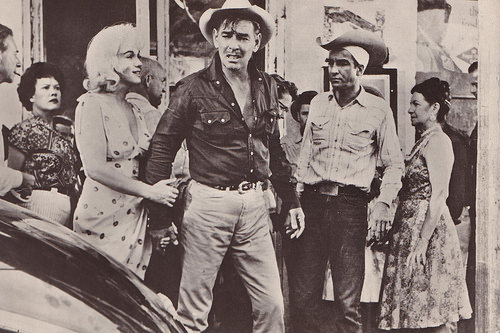
Czech postcard by Pressfoto, Praha (Prague). Photo: publicity still for The Misfits (John Huston, 1961). Collection: Carla Bosch.
In the picture we see Marilyn Monroe , Clark Gable and Montgomery Clift. For Marilyn Monroe and Clark Gable The Misfits would be the last completed movie they made.
Marilyn had a troubled childhood and spent most of it in foster homes and an orphanage. As a child, she often claimed that Clark Gable was her father. Her marriage to Arthur Miller, writer of The Misfits was ending when the film was shot. She was addicted to drugs and alcohol and even had to be hospitalised for two weeks to detox.
Twelve days after the film was completed, Gable died of a heart attack. His widow was pregnant at the time and gave birth to a son after his death. It was rumoured she blamed Marilyn for Clark’s death, because of all the stress Marilyn’s behaviour brought, but I doubt this is true as Marilyn was present at the baby’s christening four months later. Perhaps she meant he was fed up with the whole crew, not just Marilyn…
Montgomery Clift was in a car accident five years earlier. He had extensive plastic surgery on the left side of his face. After that he only wanted the right side of his face to be photographed. Then this must be a rare picture of his left side that was immobile after the crash and many operations. (His film career after the crash was referred to as “The longest suicide in Hollywood history”.)
But those glasses they are holding...
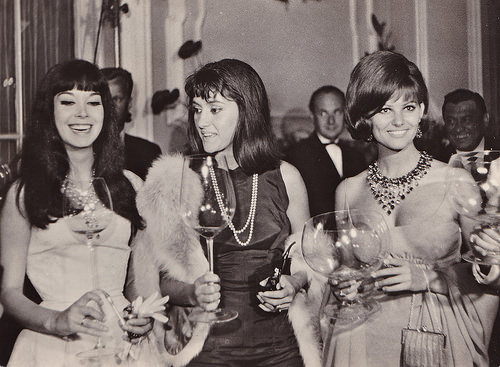
Czech postcard by Pressfoto, Praha (Prague). Collection: Carla Bosch.
The last card is titled 'Mezinarodni Filmovy Festival V Karlovych Varrech', or 'The Karlovy Vary International Film Festival'. This is a Czech film festival held every year in Karlovy Vary. I am ashamed to say I have never heard of it. It apparently is one of the oldest film festivals in the world and a major event in Central and Eastern Europe.
And I am even more ashamed when I see the actresses: Elisa Montes, Piqueras A. Herrera, and Claudia Cardinale . The festival welcomed some famous names. I wonder why their names are without a Czech twist this time. They are all three lovely actresses. No doubt about that. But those glasses they are holding: they are huge! I don’t know whether they are average glasses in the Czech Republic. The glasses held by Montes and Herrera are glasses for white wine, the one in Cardinale’s hand is for red wine, and there is someone on the right, outside the picture, who is also holding a red wine glass. If I have to guess, each glass can contain a full bottle of wine. No wonder they are all laughing.
All the cards were printed in 1964. I have the impression they are part of one series, but I have no idea whether they were printed for a certain occasion (perhaps the Karlovy Vary film festival) or they were just printed at the same time by accident. I do have the idea there must be more cards that belong to this series.
The cards with Marilyn Monroe must have been the reason why I bought them. I may not have thought so at the time, but I now realise they are really beautiful cards. All of them.
It might be worth another expedition to the Dachboden."
Please, do another expedition , Carla. Thank you very much for sharing this Dachbodenfund with us!
If a Thousand Clarinets
Carla: "There are four cards of the movie Kdyby tisic klarinetu. “If a Thousand Clarinets” (English title) is a Czechoslovak movie released in 1965. It is a fantasy musical film about a mysterious statue of the composer Johann Sebastian Bach that changes guns into musical instruments. The news spreads and a television station decides to make a documentary film about the subject. My guess is that it must be something like how music can change people. And, more particular, how soldiers change when they are not holding guns, but music instruments instead... But that is just a wild guess.

Czech postcard by Pressfoto, Praha (Prague). Photo: publicity still for Kdyby tisic klarinetu/If a Thousand Clarinets (Ján Rohác, Vladimír Svitácek, 1965) with at left Karel Gott and Jana Brejchova in white. Collection: Carla Bosch.

Czech postcard by Pressfoto, Praha (Prague). Photo: publicity still for Kdyby tisic klarinetu/If a Thousand Clarinets (Ján Rohác, Vladimír Svitácek, 1965). Collection: Carla Bosch.
I suspect that on these two cards are the film crew making the documentary. With Jana Brejchova , Waldemar Matuska, Hana Hegerova, Eva Pilarova, Karel Gott , Jiri Suchy, and Jiri Slitr. They are all watching a television. In the public are soldiers who are holding music instruments.

Czech postcard by Pressfoto, Praha (Prague). Photo: publicity still for Kdyby tisic klarinetu/If a Thousand Clarinets (Ján Rohác, Vladimír Svitácek, 1965) with Pavlina Filipovska. Collection: Carla Bosch.
Czech actress Pavlina Filipovska plays the role of landlady of a pension. In this picture she sits on a piano and four 'soldiers' are playing the saxophone.

Czech postcard by Pressfoto, Praha (Prague). Photo: publicity still for Kdyby tisic klarinetu/If a Thousand Clarinets (Ján Rohác, Vladimír Svitácek, 1965) with Jiri Suchy and Jiri Slitr. Collection: Carla Bosch.
The fourth card is with Jiri Suchy and Jiri Slitr, both Czech actors. I read that Jiri Suchy was responsible for the story and Jiri Slitr composed the music. They also play a role in the movie; they are both paratroopers. In this picture they have cast off their military uniform and wear civilian clothes with cool hats.
I don’t know the Czech language. When I used Google Translate, I doubted Google’s translation skills. And as there was not much published about this movie in English, I had to make guesses. I did understand, however, that the film received some enthusiastic reviews. Although the subject, provide soldiers with music instruments and take away their guns, seems rather corny, it apparently touched a (musical?) string.

Czech postcard by Pressfoto, Praha (Prague). Photo: publicity still for Egy ember, aki nincs/Key to the Murder (Viktor Gertler, 1964). Collection: Carla Bosch.
There is one card of the movie Klic k Vrazde. In English Key to the Murder. Immediately my imagination ran wild in connection with this card: a murderer with a dead woman in his arms…. On the run and thinking where to hide the body. I tried to look up this movie on the internet, but I found there was not much to look up.
It is a Hungarian movie with Miklos Gabor and Eva Vass, who are both on the card, in the leading roles. Miklos Gabor was married to Éva Ruttkai and later to Eva Vass. I cannot find the marriage dates, because that might have provided a juicy gossip. So I think it is safe to conclude that Miklos murdered Eva and is looking around with an uncertain look on his face where to hide her. Maybe he did not kill her on purpose. Perhaps there are Czech readers or experts of Czech cinema who can comment on or clarify this mysterious picture?
The difficult postcards
I started to describe the 'difficult' postcards. It took a lot of time to find nothing. I think I must have bought these cards because of the more famous movie stars:

Czech postcard by Pressfoto, Praha (Prague). Photo: Dany Carrel , Gérard Philipe and Danielle Darrieux in the Émile Zola adaptation Pot Bouille/Lovers of Paris (Julien Duvivier, 1957) Collection: Carla Bosch.
For example Dany Carrelova , Gérard Philipe and Danielle Darrieuxova in the movie Pod Poklickou. I cannot help mentioning those names in Czech, because they look and sound rather funny. They have been given a Czech twist.
The movie’s original name is French: Pot-Bouille. It was released in 1957, based on Emile Zola’s novel of the same name. The English title is “Lovers of Paris”. Dany Carrel is in love with Gérard Philipe , but Gerard only has eyes for Danielle Darrieux who is too haughty to notice him. In the end Dany is married to someone else, but is Gerard’s mistress. Danielle is widowed and suddenly sees Gerard as a man who has possibilities. I know this summary is simplistic and does not do the movie justice, but perhaps we now understand the look on the faces in the picture.
The next two cards are with world-famous film stars: Romy Schneiderova and Sophia Lorenova . They are two of the leading stars in Boccaccio, the original title being Boccaccio ’70. There are two other leading ladies in this movie: Anita Ekberg(ova) and Marisa Solinas(ova), but I don’t have a card of them, at least, not a Czech one that belongs to this series.
Boccaccio '70 is a collection of four different movies directed by four different directors. Each story describes a different aspect of love and morality. Giovanni Boccaccio did something similar in his 'Decameron' but that was in the 14th century and is a frame story consisting of 100 tales.
Boccaccio ‘70 was released in 1962 (and has 4 tales).

Czech postcard by Pressfoto, Praha (Prague). Photo: publicity still for in the episode Il lavoro/The Job by Luchino Visconti, part of the episodefilm Boccaccio '70 (1962). Collection: Carla Bosch.
The first card with Romy Schneider is the story Il lavoro about a woman who finds out that her husband visits prostitutes. The pair is financially dependent on her father who stops his financial support after he gets wind of his son-in-law’s escapades. Romy decides to take matters in her own hand and to become an independent woman by earning her own money. She will neither be dependent on her father or her husband!
The card shows Romy lying on the floor next to a record player with a cigarette in her hand. Perhaps she ponders on how to make her husband pay for his infidelity, how to win him back, and how to be a strong financially independent woman at the same time. I don’t know whether the end is satisfactory in that respect, because she humiliates her husband and makes him cringe like a worm and she makes it clear to him she is more sensual and sexually attractive than the callgirls he pays. So far for being an independent working girl, she did save her marriage.

Czech postcard by Pressfoto, Praha (Prague). Photo: publicity still for Boccaccio '70 (Vittorio De Sica a.o., 1962) with Sophia Loren . Collection: Carla Bosch.
The second card with Sophia Loren is the story La riffa about a lottery. Sophia works in a fairground attraction and is the grand prize in a lottery. The man who has the winning lottery ticket is allowed to spend the night with Sophia. A great deal of the film is about the efforts of the horny visitors to the fairground to obtain the winning ticket. Sophia, however, falls in love with a handsome young visitor to the carnival. When a nerdy, shy man is the winner of the night with Sophia, they pretend to spend the night together and let everybody think they did it. The nerdy man is considered a hero, and Sophia escapes with the man she fell in love with. Hmm…
About the card: we see Sophia on a bed with a man in front of her. We only see the man’s back; he is balding. Sophia looks at something else than the man and has her mouth open. Perhaps this is the scene in which Sophia and the winner spend the night and have to pretend: Sophia screams and they both make the bed move.… I do not have the faintest idea. It is a very nice card with Sophia Loren, however.
A new ‘mixed’ society of old money and nouveau riche
Two cards are of the movie Gepard, Czech for Il Gattopardo/The Leopard, an Italian movie with Alain Delon , Claudia Cardinalova , and Burt Lancaster released in 1963. Burt Lancaster plays the role of Prince of Salina, Alain Delon his nephew, and Claudia Cardinale is the mayor’s daughter. The movie is about a rapidly changing society and a fading past. Lancaster plays an aristocratic elegant nobleman enjoying the wealth and privileges that are inherent to his title and name, symbolising the ‘old world’. The mayor on the other hand has become rich by land speculation, representing the nouveau riche, ‘the new world’.
Alain Delon , heir to the old world, falls for Claudia Cardinale , heiress to the new world. Burt reluctantly agrees to a marriage between Alain and Claudia. The film ends with a spectacular ball, a scene that lasts for 45 minutes. Burt realises he is becoming a relic from the past. Had he been born two decades later, he might have married Claudia himself.

Czech postcard by Pressfoto, Praha (Prague). Photo: publicity still for Il Gattopardo/The Leopard (Luchino Visconti, 1963) with Alain Delon and Claudia Cardinale . Collection: Carla Bosch.
On this card we see Alain Delon and Claudia Cardinale , the couple that will start a new ‘mixed’ society of old money and nouveau riche.

Czech postcard by Pressfoto, Praha (Prague). Photo: publicity still for Il Gattopardo/The Leopard (Luchino Visconti, 1963) with Alain Delon , Claudia Cardinale and Burt Lancaster . Collection: Carla Bosch.
I guess this picture is of the ball scene. We see the young couple looking at old Burt. Alain is looking serious, Claudia is hanging on his shoulder and looks coyly at Burt. With the old and new world in mind, the picture conveys quite a different meaning.
Brigitte Bardotova

Czech postcard by Pressfoto, Praha (Prague). Photo: publicity still for Vie privée/A Very Private Affair (Louis Malle, 1962). Collection: Carla Bosch.
And now Brigitte Bardotova in Soukromy Zivot or Vie Privée, released in 1962. Brigitte Bardot plays a girl who lives in Switzerland with her widowed mother. She is infatuated with Marcello Mastroianni who is married to a friend of hers, unfortunately. There is some unclarity on the different sites that discuss this movie. Some say Marcello is married to her friend, others say he is her mother’s ex-lover. Perhaps he is both. Anyway, Brigitte has had it in Switzerland and moves to Paris where she becomes a famous movie star and model. She experiences the negative aspects of such a career: she does not have a private life and is regarded as public property.
She returns to Switzerland where she finds Marcello divorced, fortunately. They start an affair, but the fans and paparazzi claim her again. She trusts Marcello to protect her from the intrusive press that hounds her. But Marcello, a film director himself, seems more interested in a play he is directing. Brigitte becomes depressed and withdraws from public life. It could have been the story of Brigitte Bardot herself, the actress and model! Brigitte was 28 when she played the leading role in A Very Private Affair, but she apparently had great foresight. The film was not a great success. Yet, rather interesting as we look at it through new eyes perhaps? I don’t know what to make of the postcard. We see Brigitte wrapped in a bed sheet. The bed is behind her. She looks lovely in that sheet.

The postcard’s back is interesting too: if you look closely, you can see an image of…. Gina Lollobrigida !
The cards were probably stored close together, nearly glued together so that Gina left an imprint on Brigitte’s back. Unfortunately the card with Lollobrigida was not in the package I bought.
Well, nobody’s perfect
There are three cards of the movie Nekdo To Rad Horke, or Some Like It Hot, released in 1959.

Czech postcard by Pressfoto, Praha (Prague). Photo: publicity still for Some Like it Hot (Billy Wilder, 1959) with Jack Lemmon and Tony Curtis. Collection: Carla Bosch.
The first card is with Jack Lemmon and Tony Curtis, two musicians who are on the run after they have witnessed a murder. They dress up as women and join a female jazz-band. In this picture they are playing a bass (Jack Lemmon), and a saxophone (Tony Curtis). Tony is in love with Marilyn, but cannot tell her he is a man, so instead he tries to become best friends with her.

Czech postcard by Pressfoto, Praha (Prague). Photo: publicity still for Some Like it Hot (Billy Wilder, 1959). Collection: Carla Bosch.
The second card is with Jack Lemmon and Joe E. Brown. Joe is a millionaire and in love with Jack Lemmon. Jack cannot tell either he is a man, so he goes through with it, but eventually has to confess to Joe he is a man when Joe asks to marry him. Joe is in love and won’t be deterred: “Well, nobody’s perfect”.
The topics of homosexuality and men wearing drag costumes and make-up were taboo in those days. But times have changed. It is considered to be one of the best films and comedies of all times.

Czech postcard by Pressfoto, Praha (Prague). Photo: publicity still for Some Like it Hot (Billy Wilder, 1959) with Marilyn Monroe . Collection: Carla Bosch.
The third card is with Marilyn cutting up something. Honestly, I saw the movie twice, but I cannot for the life of me remember what Marilyn is cutting. I have to watch it a third time. (It's ice, ed.)
Then there is one card of the film Mustangove, or The Misfits. Released in 1961, with, of course Marilyn Monroeova .

Czech postcard by Pressfoto, Praha (Prague). Photo: publicity still for The Misfits (John Huston, 1961). Collection: Carla Bosch.
In the picture we see Marilyn Monroe , Clark Gable and Montgomery Clift. For Marilyn Monroe and Clark Gable The Misfits would be the last completed movie they made.
Marilyn had a troubled childhood and spent most of it in foster homes and an orphanage. As a child, she often claimed that Clark Gable was her father. Her marriage to Arthur Miller, writer of The Misfits was ending when the film was shot. She was addicted to drugs and alcohol and even had to be hospitalised for two weeks to detox.
Twelve days after the film was completed, Gable died of a heart attack. His widow was pregnant at the time and gave birth to a son after his death. It was rumoured she blamed Marilyn for Clark’s death, because of all the stress Marilyn’s behaviour brought, but I doubt this is true as Marilyn was present at the baby’s christening four months later. Perhaps she meant he was fed up with the whole crew, not just Marilyn…
Montgomery Clift was in a car accident five years earlier. He had extensive plastic surgery on the left side of his face. After that he only wanted the right side of his face to be photographed. Then this must be a rare picture of his left side that was immobile after the crash and many operations. (His film career after the crash was referred to as “The longest suicide in Hollywood history”.)
But those glasses they are holding...

Czech postcard by Pressfoto, Praha (Prague). Collection: Carla Bosch.
The last card is titled 'Mezinarodni Filmovy Festival V Karlovych Varrech', or 'The Karlovy Vary International Film Festival'. This is a Czech film festival held every year in Karlovy Vary. I am ashamed to say I have never heard of it. It apparently is one of the oldest film festivals in the world and a major event in Central and Eastern Europe.
And I am even more ashamed when I see the actresses: Elisa Montes, Piqueras A. Herrera, and Claudia Cardinale . The festival welcomed some famous names. I wonder why their names are without a Czech twist this time. They are all three lovely actresses. No doubt about that. But those glasses they are holding: they are huge! I don’t know whether they are average glasses in the Czech Republic. The glasses held by Montes and Herrera are glasses for white wine, the one in Cardinale’s hand is for red wine, and there is someone on the right, outside the picture, who is also holding a red wine glass. If I have to guess, each glass can contain a full bottle of wine. No wonder they are all laughing.
All the cards were printed in 1964. I have the impression they are part of one series, but I have no idea whether they were printed for a certain occasion (perhaps the Karlovy Vary film festival) or they were just printed at the same time by accident. I do have the idea there must be more cards that belong to this series.
The cards with Marilyn Monroe must have been the reason why I bought them. I may not have thought so at the time, but I now realise they are really beautiful cards. All of them.
It might be worth another expedition to the Dachboden."
Please, do another expedition , Carla. Thank you very much for sharing this Dachbodenfund with us!
Published on December 22, 2018 22:00
December 21, 2018
Photo by Fox Film
During the silent era, Fox Film Corporation was a multimillion-dollar empire controlling a large portion of the exhibition, distribution, and production of film facilities. Fox Film was founded in 1915 by William Fox, a Hungarian-American motion picture executive with enormous entrepreneurial drive and vision. He made film stars of William Farnum, Theda Bara and Janet Gaynor, earned millions with the Westerns of Tom Mix and Buck Jones, and produced the silent classics What Price Glory (Raoul Walsh, 1926), Seventh Heaven (1927), and Sunrise (1927). He also founded the Fox West Coast Theatres chain. Although he lost control of his enterprise in 1930, his name lives on in 20th Century Fox, which was founded in 1935.
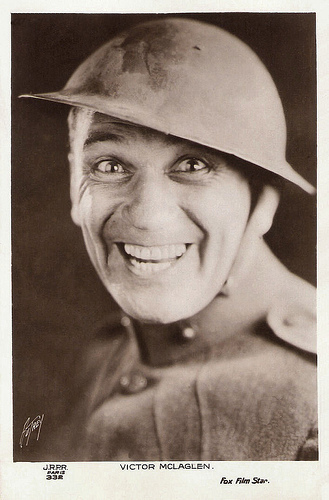
Victor McLaglen . French postcard by J.R.P.R., Paris, no. 332. Photo: Max Munn Autrey / Fox. Publicity still for What Price Glory (Raoul Walsh, 1926).
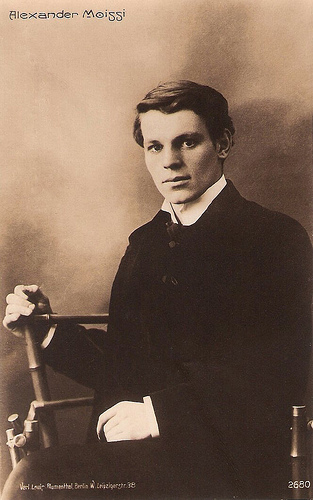
Alexander Moissi . German postcard by Verlag Louis Blumenthal, Berlin, no. 2680.
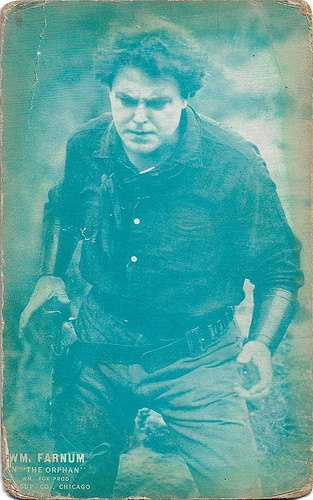
American postcard by Sup. Co., Chicago. Photo: William Fox Productions. Publicity still of William Farnum in The Orphan (J. Gordon Edwards, 1920).
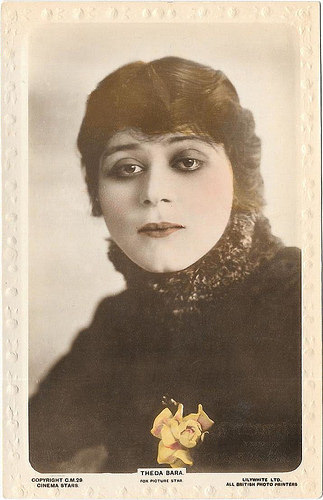
Theda Bara. British postcard in the Lilywhite Photographic series. Photo: William Fox. Collection: Didier Hanson. Bara made more than 40 films between 1914 and 1926, but most were lost in the 1937 Fox vault fire.
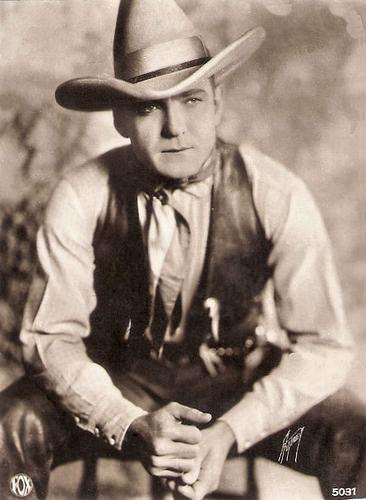
Buck Jones. French postcard, no. 5031. Photo: Max Munn Autrey / Fox. With his famed horse Silver, Jones would make more than 160 films credits.
Transforming unknown Theodosia Goodman into film vamp Theda Bara
William Fox was born as Vilmos Fuchs (Fuchs is German for Fox) in 1879 in Tolcsva, Austria-Hungary (now Hungary). His Jewish family immigrated to the United States when William was nine months old and settled in New York City. Wilhelm never finished grammar school and worked as a newsboy and in the fur and garment industry as a youth. In 1900, he started his own fur company, which he sold in 1904 to purchase his first 146-seat nickelodeon in Brooklyn. Always more of an entrepreneur than a showman, he concentrated on acquiring and building cinemas. Fox personally oversaw the construction of many Fox Theatres in American cities including Atlanta, Detroit, Oakland, San Francisco and San Diego. He introduced organ accompaniment to the silent films shown in his cinemas and pioneered in designing theatres for the comfort of the patrons.
Like other industry pioneers, Fox moved into production and distribution to ensure a flow of product for his growing theatre chain. He founded Box Office Attractions, a film production/distribution company active from 1913 till 1914, when it was replaced by the William Fox Vaudeville Co. One of his first releases was the German film Die Augen des Ole Brandis/The Eyes of Ole Brandis (Stellan Rye, 1913) with Alexander Moissi and Paul Wegener . Fox became one of the most powerful of the independent exhibitors and distributors. In 1913, he led their fight against the Motion Picture Patents Company, an attempted monopoly of the industry by Thomas Edison and other film pioneers. The fight ended when the Supreme Court ruled in Fox's favour.
Beginning in 1914, New Jersey-based Fox bought films outright from the Balboa Amusement Producing Company in Long Beach, California, for distribution to his own theatres and then for rental to other theatres across the country. Examples are the short film dramas The Unexpected (1914) and The Rat (1914), both with Belle Bennett and Henry King. He formed the Fox Film Corporation on 1 February 1915 via the merger of his established production and distribution companies. The company's first film studio was leased in Fort Lee, New Jersey, where many other early film studios were based at the beginning of the 20th century.
In 1916, Fox moved his modest production operation to Hollywood, opening a studio on the corner of Sunset and Western. That began a period of tremendous growth for Fox, spurred by its two recent star discoveries, William Farnum and Theda Bara. William Farnum, celebrated on stage as the original Ben-Hur, became one of the highest paid stars in Hollywood. He received from William Fox $10,000 weekly for making such films as the action adventure Samson (Edgar Lewis, 1915). Through an adroit use of publicity, Fox transformed the unknown Theodosia Goodman from Cincinnati into the exotic film vamp Theda Bara. Publicists sent out press releases for her first film, A Fool There Was (Frank Powell, 1915), that Theda was the daughter of an artist and an Arabian princess, and that ‘Theda Bara’ was an anagram for ‘Arab Death’ - a far cry from her humble Jewish upbringing in Cincinnati. The following years, she starred in such exotic pictures as Salome (J. Gordon Edwards, 1918) and The Siren's Song (J. Gordon Edwards, 1919).
Under long-time production chief Winfield Sheehan, the studio turned out a winning combination of A-class star vehicles, like the Farnum and Bara films, alongside popular two-reel (50 minutes long) Westerns starring Tom Mix and Buck Jones. Mix was signed by Fox Films in 1917 and remained with them until 1928, averaging five or so films a year. A series of Westerns starring Mix grossed almost $1 million per film for Fox. His popularity eclipsed all other great cowboy stars of the silent era and he earned - and spent - millions. His early Fox Westerns include Durand of the Bad Lands (Richard Stanton, 1917), with Dustin Farnum – William’s brother, Western Blood (Lynn Reynolds, 1918), and The Coming of the Law (Arthur Rosson, 1919).
In the latter film, Buck Jones had a bit role. Producer William Fox put Jones under contract and decided to use him as a backup to Tom Mix. This led to his first leading role in The Last Straw (Denison Clift, Charles Swickard, 1920). Fox promoted Jones as a new Western star. He quickly climbed to the upper ranks of Western stardom, playing a more dignified, less gaudy hero than Mix in such Westerns as Straight from the Shoulder (Bernard J. Durning, 1921) and Against All Odds (Edmund Mortimer, 1924). With his famed horse Silver, Jones became one of the most successful and popular actors in the genre, and at one point he was receiving more fan mail than any actor in the world.
Fox Film reached a peak in the late silent era when its roster of staff directors included Raoul Walsh, Frank Borzage, John Ford, Howard Hawks, and F.W. Murnau. Winfield Sheehan tended to be a hands-off executive, so these directors enjoyed considerable control of their projects, which included such masterworks as What Price Glory (Raoul Walsh, 1926) with Victor McLaglen and Dolores del Rio , Seventh Heaven (Frank Borzage, 1927) with Janet Gaynor and Charles Farrell , and Sunrise (F.W. Murnau, 1927). Fox also produced solid genre work like Three Bad Men (John Ford, 1926) featuring George O'Brien and Lou Tellegen , Paid to Love (Howard Hawks, 1927) with George O’Brien and Virginia Valli, and A Girl in Every Port (Howard Hawks, 1928) with Victor McLaglen and Louise Brooks . Most of these films contained a musical score and sound effects, as Fox in 1926 and 1927 was vying with Warner Bros. to crack the sound barrier via its Movietone sound-on-film system.
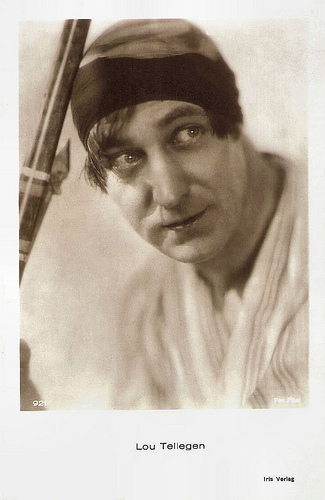
Lou Tellegen . Austrian postcard by Iris Verlag, no. 921. Photo: Fox Film.
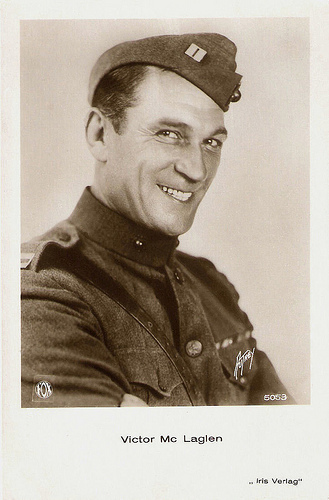
Victor McLaglen . Austrian postcard by Iris Verlag, no. 5053. Photo: Max Munn Autrey / Fox. Publicity still for What Price Glory? (Raoul Walsh, 1926).
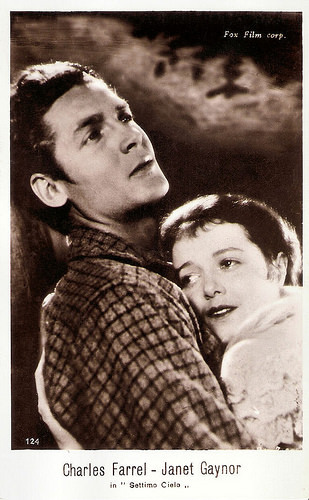
Charles Farrell and Janet Gaynor . Italian postcard offered by Cioccolata Lurati, no. 124. Photo: Fox. Publicity still for Seventh Heaven (Frank Borzage, 1927).
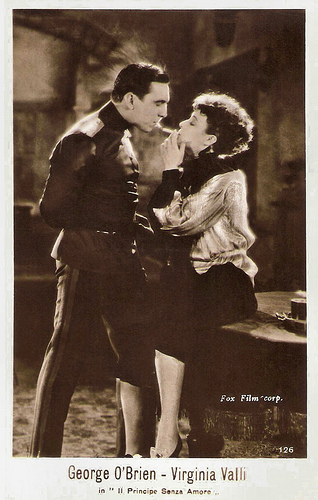
George O'Brien and Virginia Valli. Italian postcard by G.B. Falci, Milano, no. 126. Photo: Fox Film Corp. Publicity still for Paid to Love (1927).
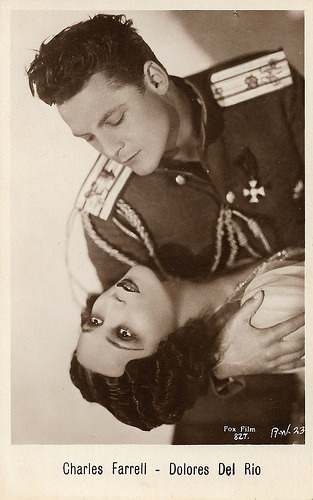
Charles Farrell and Dolores del Rio . Italian postcard by G.B. Falci, Milano, no. 827. Photo: Max Munn Autrey / Fox Film. Publicity still for The Red Dance (Raoul Walsh, 1928).
William Fox's growing list of woes
In 1925–1926, Fox purchased the rights to the work of Freeman Harrison Owens, the U.S. rights to the Tri-Ergon system invented by three German inventors, and the work of Theodore Case to create the Fox Movietone sound-on-film system, introduced in 1927 with the release of Sunrise (F.W. Murnau, 1927), starring George O'Brien and Janet Gaynor . The 1927 news series Movietone News was in fact the first commercially successful sound film. Sound-on-film systems such as Movietone and RCA Photophone soon became the standard, and competing sound-on-disc technologies, such as Warner Bros.' Vitaphone, fell into disuse. From 1928 to 1963, Fox Movietone News was one of the major newsreel series in the U.S.
In 1928 Fox completed construction on its new studio in Westwood (West Hollywood), dubbed ‘Movietone City’, and also began experimenting with widescreen and 70mm pictures like The Big Trail (Raoul Walsh, 1930), a spectacular Western starring John Wayne in his first significant leading role. The film flopped, weakening the market for A-class Westerns and relegating Wayne to a decade of B-Western roles. Ron Oliver at IMDb : “With very good acting and excellent production values, it lives up to its reputation as the talkies' first epic Western. John Wayne, pulled from obscurity for his first important movie role, looks impossibly young, but he immediately impresses with the natural charm & masculine authority he brings to the hero's role; he quietly dominates the film with the attributes which would someday make him a huge star.”
The flop added to William Fox's growing list of woes. In 1927, Marcus Loew, head of rival studio Metro-Goldwyn-Mayer, died, and control of MGM passed to his long-time associate, Nicholas Schenck. Fox saw an opportunity to expand his empire, and in 1929, with Schenck's assent, bought the Loew family's holdings in MGM. However, MGM studio bosses Louis B. Mayer and Irving Thalberg were outraged, since, despite their high posts in MGM, they were not shareholders. Mayer used his political connections to persuade the Justice Department to sue Fox for violating federal antitrust law. Because of the expense of converting 1,100 theatres to sound equipment, Fox’s empire crumbled. During this time, in the middle of 1929, Fox was badly hurt in an automobile accident. By the time he recovered, the stock market crash in the fall of 1929 had virtually wiped out his fortune, ending any chance of the Loews-Fox merger going through even if the Justice Department had given its blessing.
Fox lost control of the Fox Film Corporation in 1930 during a hostile takeover. A combination of the stock market crash, Fox's car accident injury, and government antitrust action forced him into a protracted seven-year struggle to fight off bankruptcy. At his bankruptcy hearing in 1936, he attempted to bribe judge John Warren Davis and committed perjury, for which he was sentenced to six months in prison. Fox retired from the film business. For many years Fox resented the way that Wall Street had forced him from control of his company. In 1933 he collaborated with the writer Upton Sinclair on a book 'Upton Sinclair Presents William Fox' in which Fox recounted his life his views on what he considered to be a conspiracy against him by Wall Street. For the remainder of his life he lived quietly in Long Island, New York, secure from his many patent holdings. There, he died more or less unnoticed in 1952 at the age of 73. No Hollywood producers came to his funeral. He is interred at Salem Fields Cemetery, Brooklyn. Vanda Krefft wrote the biography ‘The Man Who Made the Movies: The Meteoric Rise and Tragic Fall of William Fox’.
William Fox was replaced as president in 1930 by one of those creditors, Harley Clarke, while Sheehan remained head of production. There were some upbeat developments in the early sound era, especially on the talent front. Janet Gaynor , who burst to stardom in Seventh Heaven (Frank Borzage, 1927), and Sunrise (F.W. Murnau, 1927), enjoyed a successful transition to sound via two musical hits, Happy Days (Benjamin Stoloff, 1929) and Sunny Side Up (David Butler, 1929) opposite Charles Farrell . The recently signed Will Rogers, long-time film and vaudeville personality, suddenly surged to top stardom in the sound era. But these rising stars could not stem the impact of the Depression, and the studio's fortunes faded badly after Fox's ouster. In 1932 Clarke was replaced by Sidney Kent, who proved to be a capable chief executive but could not forestall the inevitable. In 1933 Fox West Coast Theatres, the studio's exhibition arm—and, in effect, its parent company—went into receivership. In 1935, Fox Film Corporation merged in 1935 with the upstart Twentieth Century Pictures to form 20th Century-Fox.
EFSP will do a post on 20th Century Fox next week. So, to be continued.
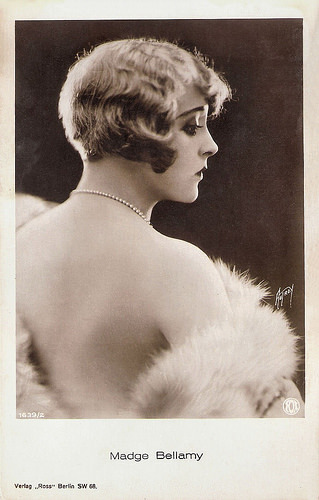
Madge Bellamy. German postcard by Ross Verlag, no. 1639/2, 1927-1928. Photo: Max Munn Autrey / Fox.
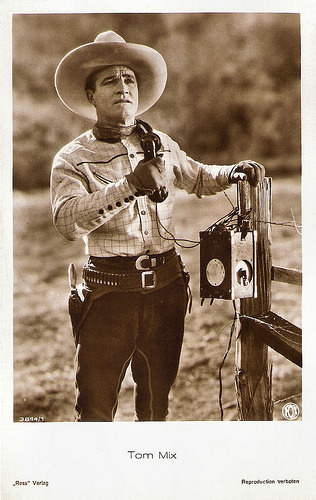
Tom Mix. German postcard by Ross Verlag, Berlin, no. 3844/1, 1928-1929. Photo: Fox.
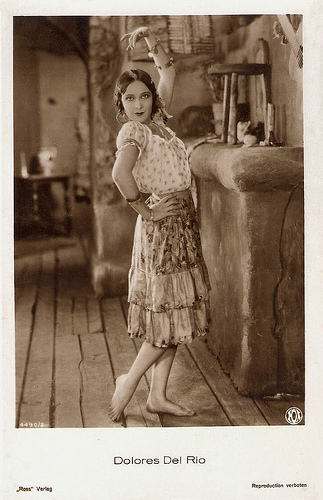
Dolores del Rio . German postcard by Ross Verlag, no. 4490/2, 1929-1930. Photo: Fox. Publicity still for The Loves of Carmen (Raoul Walsh, 1927).
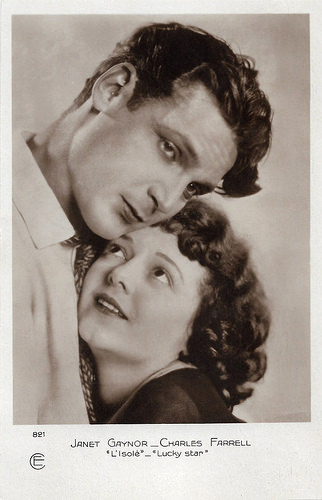
Janet Gaynor and Charles Farrell . French postcard by Cinémagazine Edition (CE), Paris, no. 821. Photo: Fox. Publicity still for Lucky Star (Frank Borzage, 1929).
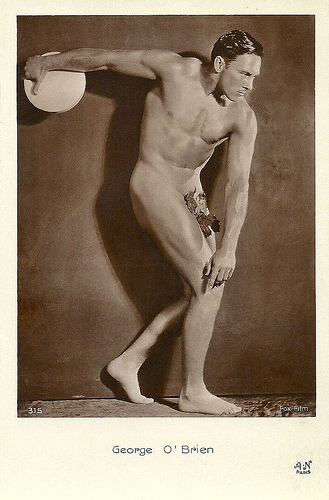
George O'Brien. French postcard by A.N., Paris, no. 315. Photo: Max Munn Autrey / Fox Film. Collection: Didier Hanson.
Sources: (IMDb), Ron Oliver (IMDb), (IMDb), Film Reference, Encyclopaedia Britannica, Wikipedia and .

Victor McLaglen . French postcard by J.R.P.R., Paris, no. 332. Photo: Max Munn Autrey / Fox. Publicity still for What Price Glory (Raoul Walsh, 1926).

Alexander Moissi . German postcard by Verlag Louis Blumenthal, Berlin, no. 2680.

American postcard by Sup. Co., Chicago. Photo: William Fox Productions. Publicity still of William Farnum in The Orphan (J. Gordon Edwards, 1920).

Theda Bara. British postcard in the Lilywhite Photographic series. Photo: William Fox. Collection: Didier Hanson. Bara made more than 40 films between 1914 and 1926, but most were lost in the 1937 Fox vault fire.

Buck Jones. French postcard, no. 5031. Photo: Max Munn Autrey / Fox. With his famed horse Silver, Jones would make more than 160 films credits.
Transforming unknown Theodosia Goodman into film vamp Theda Bara
William Fox was born as Vilmos Fuchs (Fuchs is German for Fox) in 1879 in Tolcsva, Austria-Hungary (now Hungary). His Jewish family immigrated to the United States when William was nine months old and settled in New York City. Wilhelm never finished grammar school and worked as a newsboy and in the fur and garment industry as a youth. In 1900, he started his own fur company, which he sold in 1904 to purchase his first 146-seat nickelodeon in Brooklyn. Always more of an entrepreneur than a showman, he concentrated on acquiring and building cinemas. Fox personally oversaw the construction of many Fox Theatres in American cities including Atlanta, Detroit, Oakland, San Francisco and San Diego. He introduced organ accompaniment to the silent films shown in his cinemas and pioneered in designing theatres for the comfort of the patrons.
Like other industry pioneers, Fox moved into production and distribution to ensure a flow of product for his growing theatre chain. He founded Box Office Attractions, a film production/distribution company active from 1913 till 1914, when it was replaced by the William Fox Vaudeville Co. One of his first releases was the German film Die Augen des Ole Brandis/The Eyes of Ole Brandis (Stellan Rye, 1913) with Alexander Moissi and Paul Wegener . Fox became one of the most powerful of the independent exhibitors and distributors. In 1913, he led their fight against the Motion Picture Patents Company, an attempted monopoly of the industry by Thomas Edison and other film pioneers. The fight ended when the Supreme Court ruled in Fox's favour.
Beginning in 1914, New Jersey-based Fox bought films outright from the Balboa Amusement Producing Company in Long Beach, California, for distribution to his own theatres and then for rental to other theatres across the country. Examples are the short film dramas The Unexpected (1914) and The Rat (1914), both with Belle Bennett and Henry King. He formed the Fox Film Corporation on 1 February 1915 via the merger of his established production and distribution companies. The company's first film studio was leased in Fort Lee, New Jersey, where many other early film studios were based at the beginning of the 20th century.
In 1916, Fox moved his modest production operation to Hollywood, opening a studio on the corner of Sunset and Western. That began a period of tremendous growth for Fox, spurred by its two recent star discoveries, William Farnum and Theda Bara. William Farnum, celebrated on stage as the original Ben-Hur, became one of the highest paid stars in Hollywood. He received from William Fox $10,000 weekly for making such films as the action adventure Samson (Edgar Lewis, 1915). Through an adroit use of publicity, Fox transformed the unknown Theodosia Goodman from Cincinnati into the exotic film vamp Theda Bara. Publicists sent out press releases for her first film, A Fool There Was (Frank Powell, 1915), that Theda was the daughter of an artist and an Arabian princess, and that ‘Theda Bara’ was an anagram for ‘Arab Death’ - a far cry from her humble Jewish upbringing in Cincinnati. The following years, she starred in such exotic pictures as Salome (J. Gordon Edwards, 1918) and The Siren's Song (J. Gordon Edwards, 1919).
Under long-time production chief Winfield Sheehan, the studio turned out a winning combination of A-class star vehicles, like the Farnum and Bara films, alongside popular two-reel (50 minutes long) Westerns starring Tom Mix and Buck Jones. Mix was signed by Fox Films in 1917 and remained with them until 1928, averaging five or so films a year. A series of Westerns starring Mix grossed almost $1 million per film for Fox. His popularity eclipsed all other great cowboy stars of the silent era and he earned - and spent - millions. His early Fox Westerns include Durand of the Bad Lands (Richard Stanton, 1917), with Dustin Farnum – William’s brother, Western Blood (Lynn Reynolds, 1918), and The Coming of the Law (Arthur Rosson, 1919).
In the latter film, Buck Jones had a bit role. Producer William Fox put Jones under contract and decided to use him as a backup to Tom Mix. This led to his first leading role in The Last Straw (Denison Clift, Charles Swickard, 1920). Fox promoted Jones as a new Western star. He quickly climbed to the upper ranks of Western stardom, playing a more dignified, less gaudy hero than Mix in such Westerns as Straight from the Shoulder (Bernard J. Durning, 1921) and Against All Odds (Edmund Mortimer, 1924). With his famed horse Silver, Jones became one of the most successful and popular actors in the genre, and at one point he was receiving more fan mail than any actor in the world.
Fox Film reached a peak in the late silent era when its roster of staff directors included Raoul Walsh, Frank Borzage, John Ford, Howard Hawks, and F.W. Murnau. Winfield Sheehan tended to be a hands-off executive, so these directors enjoyed considerable control of their projects, which included such masterworks as What Price Glory (Raoul Walsh, 1926) with Victor McLaglen and Dolores del Rio , Seventh Heaven (Frank Borzage, 1927) with Janet Gaynor and Charles Farrell , and Sunrise (F.W. Murnau, 1927). Fox also produced solid genre work like Three Bad Men (John Ford, 1926) featuring George O'Brien and Lou Tellegen , Paid to Love (Howard Hawks, 1927) with George O’Brien and Virginia Valli, and A Girl in Every Port (Howard Hawks, 1928) with Victor McLaglen and Louise Brooks . Most of these films contained a musical score and sound effects, as Fox in 1926 and 1927 was vying with Warner Bros. to crack the sound barrier via its Movietone sound-on-film system.

Lou Tellegen . Austrian postcard by Iris Verlag, no. 921. Photo: Fox Film.

Victor McLaglen . Austrian postcard by Iris Verlag, no. 5053. Photo: Max Munn Autrey / Fox. Publicity still for What Price Glory? (Raoul Walsh, 1926).

Charles Farrell and Janet Gaynor . Italian postcard offered by Cioccolata Lurati, no. 124. Photo: Fox. Publicity still for Seventh Heaven (Frank Borzage, 1927).

George O'Brien and Virginia Valli. Italian postcard by G.B. Falci, Milano, no. 126. Photo: Fox Film Corp. Publicity still for Paid to Love (1927).

Charles Farrell and Dolores del Rio . Italian postcard by G.B. Falci, Milano, no. 827. Photo: Max Munn Autrey / Fox Film. Publicity still for The Red Dance (Raoul Walsh, 1928).
William Fox's growing list of woes
In 1925–1926, Fox purchased the rights to the work of Freeman Harrison Owens, the U.S. rights to the Tri-Ergon system invented by three German inventors, and the work of Theodore Case to create the Fox Movietone sound-on-film system, introduced in 1927 with the release of Sunrise (F.W. Murnau, 1927), starring George O'Brien and Janet Gaynor . The 1927 news series Movietone News was in fact the first commercially successful sound film. Sound-on-film systems such as Movietone and RCA Photophone soon became the standard, and competing sound-on-disc technologies, such as Warner Bros.' Vitaphone, fell into disuse. From 1928 to 1963, Fox Movietone News was one of the major newsreel series in the U.S.
In 1928 Fox completed construction on its new studio in Westwood (West Hollywood), dubbed ‘Movietone City’, and also began experimenting with widescreen and 70mm pictures like The Big Trail (Raoul Walsh, 1930), a spectacular Western starring John Wayne in his first significant leading role. The film flopped, weakening the market for A-class Westerns and relegating Wayne to a decade of B-Western roles. Ron Oliver at IMDb : “With very good acting and excellent production values, it lives up to its reputation as the talkies' first epic Western. John Wayne, pulled from obscurity for his first important movie role, looks impossibly young, but he immediately impresses with the natural charm & masculine authority he brings to the hero's role; he quietly dominates the film with the attributes which would someday make him a huge star.”
The flop added to William Fox's growing list of woes. In 1927, Marcus Loew, head of rival studio Metro-Goldwyn-Mayer, died, and control of MGM passed to his long-time associate, Nicholas Schenck. Fox saw an opportunity to expand his empire, and in 1929, with Schenck's assent, bought the Loew family's holdings in MGM. However, MGM studio bosses Louis B. Mayer and Irving Thalberg were outraged, since, despite their high posts in MGM, they were not shareholders. Mayer used his political connections to persuade the Justice Department to sue Fox for violating federal antitrust law. Because of the expense of converting 1,100 theatres to sound equipment, Fox’s empire crumbled. During this time, in the middle of 1929, Fox was badly hurt in an automobile accident. By the time he recovered, the stock market crash in the fall of 1929 had virtually wiped out his fortune, ending any chance of the Loews-Fox merger going through even if the Justice Department had given its blessing.
Fox lost control of the Fox Film Corporation in 1930 during a hostile takeover. A combination of the stock market crash, Fox's car accident injury, and government antitrust action forced him into a protracted seven-year struggle to fight off bankruptcy. At his bankruptcy hearing in 1936, he attempted to bribe judge John Warren Davis and committed perjury, for which he was sentenced to six months in prison. Fox retired from the film business. For many years Fox resented the way that Wall Street had forced him from control of his company. In 1933 he collaborated with the writer Upton Sinclair on a book 'Upton Sinclair Presents William Fox' in which Fox recounted his life his views on what he considered to be a conspiracy against him by Wall Street. For the remainder of his life he lived quietly in Long Island, New York, secure from his many patent holdings. There, he died more or less unnoticed in 1952 at the age of 73. No Hollywood producers came to his funeral. He is interred at Salem Fields Cemetery, Brooklyn. Vanda Krefft wrote the biography ‘The Man Who Made the Movies: The Meteoric Rise and Tragic Fall of William Fox’.
William Fox was replaced as president in 1930 by one of those creditors, Harley Clarke, while Sheehan remained head of production. There were some upbeat developments in the early sound era, especially on the talent front. Janet Gaynor , who burst to stardom in Seventh Heaven (Frank Borzage, 1927), and Sunrise (F.W. Murnau, 1927), enjoyed a successful transition to sound via two musical hits, Happy Days (Benjamin Stoloff, 1929) and Sunny Side Up (David Butler, 1929) opposite Charles Farrell . The recently signed Will Rogers, long-time film and vaudeville personality, suddenly surged to top stardom in the sound era. But these rising stars could not stem the impact of the Depression, and the studio's fortunes faded badly after Fox's ouster. In 1932 Clarke was replaced by Sidney Kent, who proved to be a capable chief executive but could not forestall the inevitable. In 1933 Fox West Coast Theatres, the studio's exhibition arm—and, in effect, its parent company—went into receivership. In 1935, Fox Film Corporation merged in 1935 with the upstart Twentieth Century Pictures to form 20th Century-Fox.
EFSP will do a post on 20th Century Fox next week. So, to be continued.

Madge Bellamy. German postcard by Ross Verlag, no. 1639/2, 1927-1928. Photo: Max Munn Autrey / Fox.

Tom Mix. German postcard by Ross Verlag, Berlin, no. 3844/1, 1928-1929. Photo: Fox.

Dolores del Rio . German postcard by Ross Verlag, no. 4490/2, 1929-1930. Photo: Fox. Publicity still for The Loves of Carmen (Raoul Walsh, 1927).

Janet Gaynor and Charles Farrell . French postcard by Cinémagazine Edition (CE), Paris, no. 821. Photo: Fox. Publicity still for Lucky Star (Frank Borzage, 1929).

George O'Brien. French postcard by A.N., Paris, no. 315. Photo: Max Munn Autrey / Fox Film. Collection: Didier Hanson.
Sources: (IMDb), Ron Oliver (IMDb), (IMDb), Film Reference, Encyclopaedia Britannica, Wikipedia and .
Published on December 21, 2018 22:00
December 20, 2018
The Big Parade (1925)
The melodramatic romance and World War I epic The Big Parade (1925) is one of MGM's all-time biggest hits and one of the classics of the silent film era. John Gilbert plays a young American soldier, who witnesses the horrors of 'the Great War'. French actress Renée Adorée and Danish actor Karl Dane co-starred and King Vidor was the director. The film stills were made by Ruth Harriet Louise.
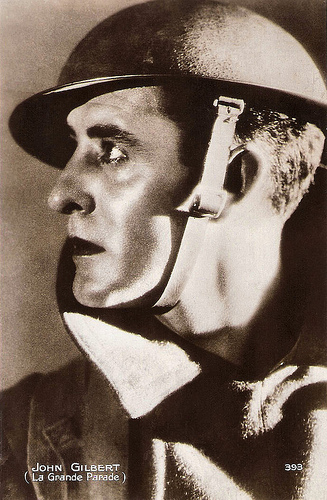
John Gilbert. French postcard by Editions Cinémagazine, no. 393. Photo: Ruth Harriet Louise / MGM. Publicity still for The Big Parade (King Vidor, 1925). Ruth Harriet Louise (1903-1940) was the first woman photographer active in Hollywood. She ran Metro-Goldwyn-Mayer's portrait studio from 1925 to 1930. She was the uncredited still photographer for The Big Parade.
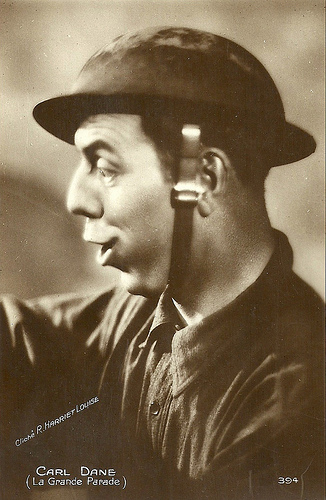
Karl Dane. French postcard by Editions Cinémagazine, no. 394. Photo: Ruth Harriet Louise / MGM. Publicity still for The Big Parade (King Vidor, 1925), starring John Gilbert. The French title of the film was La Grande Parade. Karl Dane was sometimes spelled as Carl Dane.
A new kind of realistic war film
After director King Vidor complained to MGM production chief Irving Thalberg that he was tired of shooting pictures that played in theatres for just one week, he told Thalberg about a new kind of realistic war film he had envisioned. Thalberg was enthusiastic about Vidor's vision, and tried to buy the rights to the hit Broadway play What Price Glory? co-written by Maxwell Anderson and World War I Marine veteran Laurence Stallings. Since the rights to the popular anti-war play had already been acquired, Thalberg hired Stallings to come to Hollywood and write a screenplay for the new, realistic war picture that Vidor had dreamed about making. Stallings came up with The Big Parade, an anti-war story that dispensed with traditional concepts of heroism, focusing instead on a love story between a Yank soldier and a French girl.
The Big Parade (1925) takes place from April 1917 to the Spring of 1919. John Gilbert plays Jim, the idle son of a rich businessman, who joins the US Army's Rainbow Division when the U.S.A. enters World War One. He is sent to France, where he becomes friends with two working-class soldiers, Southern construction worker Slim (Karl Dane) and Bronx bartender Bull (Tom O'Brien). He also falls in love with the French girl Mélisande (Renée Adorée), despite not being able to speak each other's language. He has to leave her to move to the frontline. There, he experiences the horrors of trench warfare in a battle that was based on the WWI Battle of Belleau Wood, which raged for most of the month of June 1918. US forces suffered nearly 10,000 casualties, including 1800 killed. Author Laurence Stallings served as a Marine Captain and lost a leg in this battle.
One of the most famous scenes of The Big Parade (1925) is the romantic scene in which Jim (John Gilbert) teaches Melisande (Renée Adorée) to chew gum. The scene was improvised on the spot during filming. Director King Vidor observed a crew member chewing gum and later recalled, "Here was my inspiration. French girls didn't chew or understand gum; American doughboys did...Gilbert's efforts to explain would endear him to her and she would kiss him...[It was] one of the best love scenes I ever directed." Gilbert also claimed that neither he nor Vidor expected Adorée to swallow the gum, which proved to be the scene's comic highlight.
After Vidor completed principal photography, Irving Thalberg took the rough cut and previewed it before live audiences in Colorado. The audiences responded favourably, and Thalberg decided to expand the scope of the picture, as Vidor had created a war picture without many scenes of war. He had Vidor restage the famous marching army column sequence with 3000 extras, 200 trucks and 100 airplanes. After Vidor moved on to another project, Thalberg had other battle scenes shot by director George W. Hill.
The result was a huge box office hit. The Big Parade (1925) played at New York's Astor Theater for two years and at that one theatre alone grossed $1.5 million during that time - more than three times its production cost of $245,000. Today. it is the highest grossing silent film of all time, making $22 million during its worldwide release. The Big Parade is one of the first films that neither glorified the war nor ignored its human costs. It heavily influenced many subsequent war films, especially All Quiet on the Western Front (Lewis Milestone, 1930). The film boosted John Gilbert's career and made Renée Adorée a major star, although Adorée would soon be diagnosed with tuberculosis and die only a few years later, 35 years old.
When MGM discovered that a clause in director King Vidor's contract entitled him to 20% of the net profits, studio lawyers called a meeting with him. At the meeting, MGM accountants played up the costs of the picture while downgrading the studio forecast of its potential success. Vidor was persuaded to sell his stake in the film for a small sum. The film ran for 96 weeks at the Astor Theater and grossed $5 million (approximately $50 million in 2003 dollars) domestically by 1930, making it the most profitable release in MGM history at that point. Vidor later said "I thus spared myself from becoming a millionaire instead of a struggling young director trying to do something interesting and better with a camera."
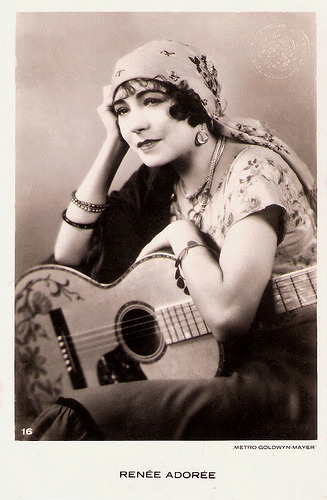
Renée Adorée. Dutch postcard, no. 16. Photo: Ruth Harriet Louise / Metro-Goldwyn-Mayer. Publicity still of The Big Parade (King Vidor, 1925).
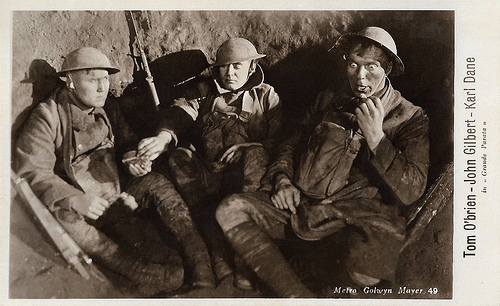
Tom O'Brien, John Gilbert, and Karl Dane. Italian postcard by G.B. Falci, Milano, no. 49. Photo: Ruth Harriet Louise / Metro-Goldwyn-Mayer. Publicity still for The Big Parade (King Vidor, 1925), released in Italy as Grande Parata/La grande parata.
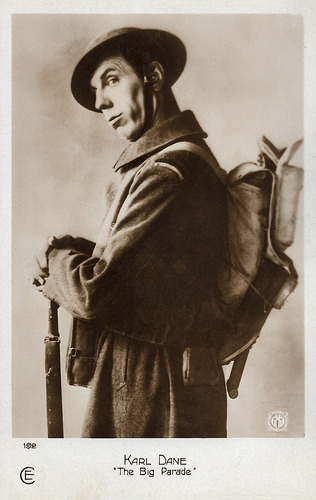
Karl Dane. French postcard by Editions Cinémagazine, no. 192. Photo: Ruth Harriet Louise / Gaumont-Metro-Goldwyn. Publicity still for The Big Parade (King Vidor, 1925).
Sources: Wikipedia and IMDb.

John Gilbert. French postcard by Editions Cinémagazine, no. 393. Photo: Ruth Harriet Louise / MGM. Publicity still for The Big Parade (King Vidor, 1925). Ruth Harriet Louise (1903-1940) was the first woman photographer active in Hollywood. She ran Metro-Goldwyn-Mayer's portrait studio from 1925 to 1930. She was the uncredited still photographer for The Big Parade.

Karl Dane. French postcard by Editions Cinémagazine, no. 394. Photo: Ruth Harriet Louise / MGM. Publicity still for The Big Parade (King Vidor, 1925), starring John Gilbert. The French title of the film was La Grande Parade. Karl Dane was sometimes spelled as Carl Dane.
A new kind of realistic war film
After director King Vidor complained to MGM production chief Irving Thalberg that he was tired of shooting pictures that played in theatres for just one week, he told Thalberg about a new kind of realistic war film he had envisioned. Thalberg was enthusiastic about Vidor's vision, and tried to buy the rights to the hit Broadway play What Price Glory? co-written by Maxwell Anderson and World War I Marine veteran Laurence Stallings. Since the rights to the popular anti-war play had already been acquired, Thalberg hired Stallings to come to Hollywood and write a screenplay for the new, realistic war picture that Vidor had dreamed about making. Stallings came up with The Big Parade, an anti-war story that dispensed with traditional concepts of heroism, focusing instead on a love story between a Yank soldier and a French girl.
The Big Parade (1925) takes place from April 1917 to the Spring of 1919. John Gilbert plays Jim, the idle son of a rich businessman, who joins the US Army's Rainbow Division when the U.S.A. enters World War One. He is sent to France, where he becomes friends with two working-class soldiers, Southern construction worker Slim (Karl Dane) and Bronx bartender Bull (Tom O'Brien). He also falls in love with the French girl Mélisande (Renée Adorée), despite not being able to speak each other's language. He has to leave her to move to the frontline. There, he experiences the horrors of trench warfare in a battle that was based on the WWI Battle of Belleau Wood, which raged for most of the month of June 1918. US forces suffered nearly 10,000 casualties, including 1800 killed. Author Laurence Stallings served as a Marine Captain and lost a leg in this battle.
One of the most famous scenes of The Big Parade (1925) is the romantic scene in which Jim (John Gilbert) teaches Melisande (Renée Adorée) to chew gum. The scene was improvised on the spot during filming. Director King Vidor observed a crew member chewing gum and later recalled, "Here was my inspiration. French girls didn't chew or understand gum; American doughboys did...Gilbert's efforts to explain would endear him to her and she would kiss him...[It was] one of the best love scenes I ever directed." Gilbert also claimed that neither he nor Vidor expected Adorée to swallow the gum, which proved to be the scene's comic highlight.
After Vidor completed principal photography, Irving Thalberg took the rough cut and previewed it before live audiences in Colorado. The audiences responded favourably, and Thalberg decided to expand the scope of the picture, as Vidor had created a war picture without many scenes of war. He had Vidor restage the famous marching army column sequence with 3000 extras, 200 trucks and 100 airplanes. After Vidor moved on to another project, Thalberg had other battle scenes shot by director George W. Hill.
The result was a huge box office hit. The Big Parade (1925) played at New York's Astor Theater for two years and at that one theatre alone grossed $1.5 million during that time - more than three times its production cost of $245,000. Today. it is the highest grossing silent film of all time, making $22 million during its worldwide release. The Big Parade is one of the first films that neither glorified the war nor ignored its human costs. It heavily influenced many subsequent war films, especially All Quiet on the Western Front (Lewis Milestone, 1930). The film boosted John Gilbert's career and made Renée Adorée a major star, although Adorée would soon be diagnosed with tuberculosis and die only a few years later, 35 years old.
When MGM discovered that a clause in director King Vidor's contract entitled him to 20% of the net profits, studio lawyers called a meeting with him. At the meeting, MGM accountants played up the costs of the picture while downgrading the studio forecast of its potential success. Vidor was persuaded to sell his stake in the film for a small sum. The film ran for 96 weeks at the Astor Theater and grossed $5 million (approximately $50 million in 2003 dollars) domestically by 1930, making it the most profitable release in MGM history at that point. Vidor later said "I thus spared myself from becoming a millionaire instead of a struggling young director trying to do something interesting and better with a camera."

Renée Adorée. Dutch postcard, no. 16. Photo: Ruth Harriet Louise / Metro-Goldwyn-Mayer. Publicity still of The Big Parade (King Vidor, 1925).

Tom O'Brien, John Gilbert, and Karl Dane. Italian postcard by G.B. Falci, Milano, no. 49. Photo: Ruth Harriet Louise / Metro-Goldwyn-Mayer. Publicity still for The Big Parade (King Vidor, 1925), released in Italy as Grande Parata/La grande parata.

Karl Dane. French postcard by Editions Cinémagazine, no. 192. Photo: Ruth Harriet Louise / Gaumont-Metro-Goldwyn. Publicity still for The Big Parade (King Vidor, 1925).
Sources: Wikipedia and IMDb.
Published on December 20, 2018 22:00
December 19, 2018
Italian Silent Cinema: A Dive into the Collection of Ivo Blom
Today starts a two-day workshop at EYE Filmmuseum in Amsterdam for international researchers and people from the archives, a workshop on the Italian Silent Cinema. The participants will take a dive into EYE's film and non-film collections. They will discuss the close relationship that Italian cinema has with other arts and will work on a corpus of films, but also on advertising material that will highlight the richness and inventiveness of the decorative arts and graphics of the silent period. For this post we asked one of the workshop organisers, Ivo Blom, to dive into his own postcard collection and to share his comments with us.
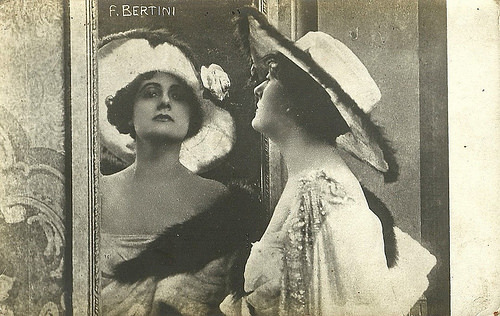
American postcard by monogram K Ltd. Photo: Francesca Bertini in Odette (Giuseppe De Liguoro, 1916). Ivo Blom: "EYE has a rich collection of films with Francesca Bertini , from her early days at Film d'Arte Italiana and short films at the Cines company to her days as a film diva in features at the Celio and Caesar studios. The Bertini films are striking for their highly emotional performances, but also for their sophisticated settings and for the wealth of costume design."
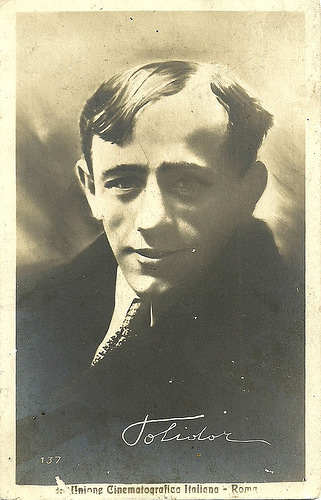
Polidor. Italian postcard by La Rotofotografica / Unione Cinematografica Italiana, no. 137. Ivo: "For a long time, Italian silent comedy was conceived as only slapstick. Research in film collections has proven that the genre was more diverse. In addition to the typical chaser comedies with Cretinetti and Robinet, the Polidor comedies had a strong background in the circus world, which shows in films with lions, bears, elephants and so on."
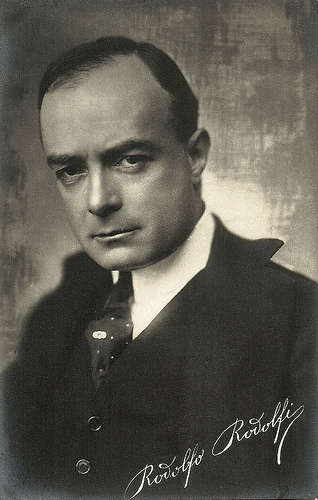
Eleuterio Rodolfi . Italian postcard by Fotocelere. Ivo: "For Ambrosio, Rodolfi acted in some 95 films of which some 80 were directed and scripted by himself. Many of these were comedies interpreted by Rodolfi together with actress Gigetta Morano, known as ‘Gigetta’ and ‘Rodolfi’. The comedies with Gigetta and Rodolfi were true ‘commedie’, situational, boulevardier, and often hinting at forbidden fruits and voyeurism. I like their film Acqua miracolosa very, very much."
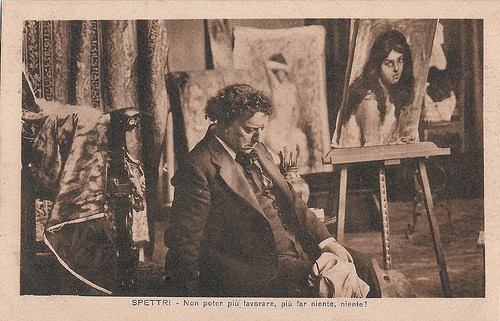
Italian postcard. Photo: Milano Film. Ermete Zacconi in Spettri/Gli spettri (A.G. Caldiera, 1918), adapted from Henrik Ibsen's Ghosts (Gengangere, 1881). Caption: Not being able anymore to paint, to do anything, nothing! Ivo: " Spettri is a good example of the representation of art and artists in Italian silent cinema. An artist feels doomed as he becomes paralysed because of his father's syphilis. It ruins his career as a painter. Finally, he asks his mother to end his sufferings. Ermete Zacconi reached the maximum of realism with his shocking performance."
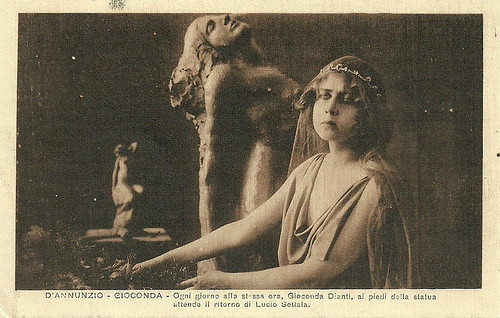
Italian postcard by IPA CT, no. 3662. Photo: Film della Società Ambrosio, Torino. Censura Terni, 18-4-1917. Publicity still from La Gioconda (Eleuterio Rodolfi, 1917) with Helena Makowska as the model Gioconda Dianti. Caption: Every night at the same hour, Gioconda Dianti, at the feet of the statue awaited the return of Lucio Settala. Ivo: "In Italian silent cinema, sculptures often work as catalysts. In La Gioconda , Makowska's artist model wrecks the family of the sculptor Lucio Settala. At the climax of the film, the wife and the mistress fight and Gioconda tries to smash the statue that is her effigy, but the wife saves it at the loss of both her arms. Shocked by so much self-sacrifice, the husband returns to his wife. Sadly, La Gioconda is a lost film."
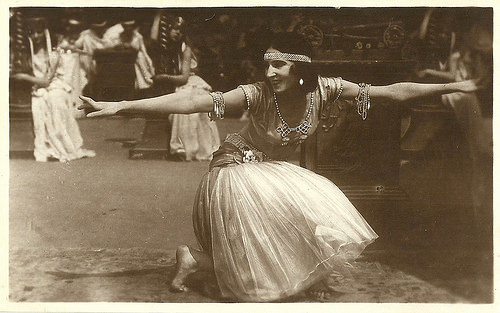
Italian postcard by Unione Cinematografica Italiana. Photo: publicity still for La nave (Gabriellino D'Annunzio, Mario Roncoroni, 1921), based on the homonymous play by Gabriele D'Annunzio. Star of the film was the Russian dancer and actress Ida Rubinstein. Ivo: "Dance is one of the central themes of the workshop. In an extended dance scene in La nave , Rubinstein's character Basiliola seduces Sergio, the lecherous bishop. This scene contains the only moving images of Rubinstein dancing, and owes a great deal to Oscar Wilde's and Richard Strauss's' Salome."
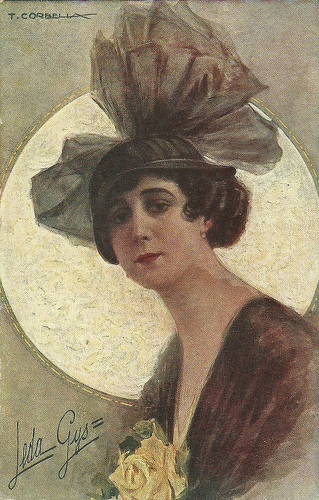
Italian postcard. Image: Leda Gys by Tito Corbella . Ivo: "In the 1910s, Tito Corbella was an acclaimed film poster designer, but he also designed a series of postcards with the most popular Italian divas. Leda Gys is well represented in the workshop, for example in the two-reeler Amore bendato (Ivo Illuminati, 1913), a Celio production."
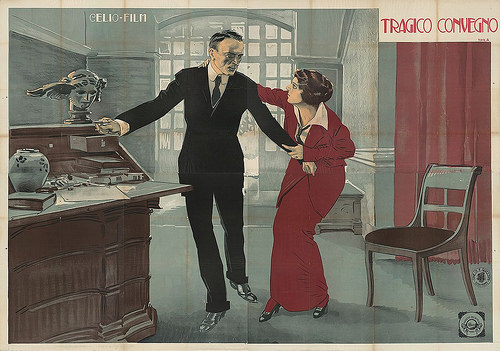
Italian film poster, designed by Tito Corbella for Tragico convegno (Ivo Illuminati, 1915), starring Maria Jacobini . Collection: EYE Filmmuseum. Ivo: "This poster belongs to the Desmet Collection, a Unesco World Heritage Collection. Italian film posters of the 1910s are remarkable for their stylish, modernist design by acclaimed artists such as Leopoldo Metlicovitz, Aleardo Terzi, and Tito Corbella . The film Tragico convegno was long considered lost, but recently resurfaced and was restored by EYE."
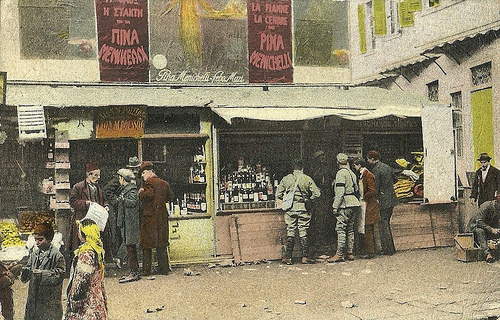
Italian postcard by IPA CT Autocromo. Censured at Terni, 10 October 1917. Photo: Henri Manuel. Caption on the back: "Poor shops still do paying business." Ivo: "Sometimes, old postcards give insight in how film posters were a part of streetlife. Here is a postcard depicting Saloniki in Greece during the First World War. Above the shops, posters are visible for the Itala production Il Fuoco (1915), by and with Febo Mari , and starring Italian diva Pina Menichelli . I was very pleased to find this rare postcard."
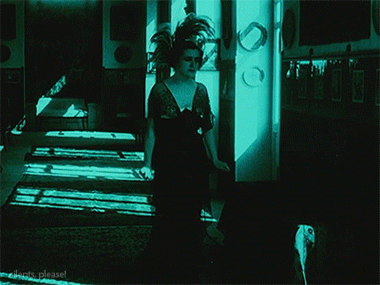
Scene from Sangue bleu (Nino Oxilia, 1914). Source: Silents, Please!
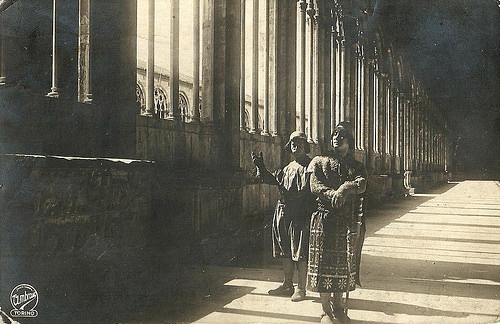
Italian postcard. Photo: Ambrosio Film. Publicity still for La Gorgona (Mario Caserini, 1915), scripted by Arrigo Frusta and starring Annibale Ninchi and Madeleine Céliat . The film was based on a play by Sem Benelli. Ivo: "I always thought that the typical use of light stripes were a feat of the diva films, such as those in Sangue bleu when Francesca Bertini passes a corridor. However, these light effects were apparently also common in Italian historical films such as La Gorgona. I consider lighting in general to be highly inventive in Italian silent cinema."
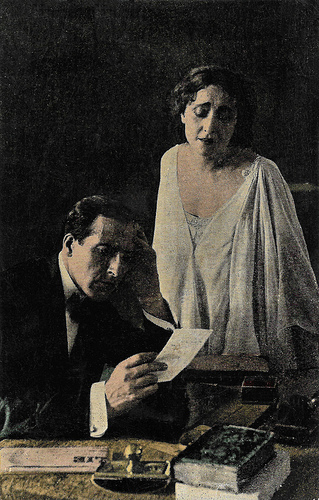
Spanish collectors card by Chocolat Imperiale. Imp. Bayer Hnos. y C.a. Chromophotography. "El drama de una noche" was the Spanish release title of the Italian melodrama Il dramma di una notte/The Drama of One Night (Mario Caserini, 1918), starring Lyda Borelli . The film was distributed in Spain during WWI by the company José Montanola, Barcelona. Ivo: "Borelli's last film was considered lost, but recently a ten-minutes-fragment was found at EYE Filmmuseum. Despite its shortness, the clip shows the whole melodrama as if it were a trailer. Borelli's character's dark past haunts her at the brink of her marriage. A former client of her life in Calcutta proves to be the brother of her future husband and he threatens to expose her. Only an Indian poison can save her reputation. It's an excellent example of a 1910s melodrama, one of the themes of the workshop."
Admission to the workshop is closed, but all the debates will be recorded and published online.
Thank you, Ivo!

American postcard by monogram K Ltd. Photo: Francesca Bertini in Odette (Giuseppe De Liguoro, 1916). Ivo Blom: "EYE has a rich collection of films with Francesca Bertini , from her early days at Film d'Arte Italiana and short films at the Cines company to her days as a film diva in features at the Celio and Caesar studios. The Bertini films are striking for their highly emotional performances, but also for their sophisticated settings and for the wealth of costume design."

Polidor. Italian postcard by La Rotofotografica / Unione Cinematografica Italiana, no. 137. Ivo: "For a long time, Italian silent comedy was conceived as only slapstick. Research in film collections has proven that the genre was more diverse. In addition to the typical chaser comedies with Cretinetti and Robinet, the Polidor comedies had a strong background in the circus world, which shows in films with lions, bears, elephants and so on."

Eleuterio Rodolfi . Italian postcard by Fotocelere. Ivo: "For Ambrosio, Rodolfi acted in some 95 films of which some 80 were directed and scripted by himself. Many of these were comedies interpreted by Rodolfi together with actress Gigetta Morano, known as ‘Gigetta’ and ‘Rodolfi’. The comedies with Gigetta and Rodolfi were true ‘commedie’, situational, boulevardier, and often hinting at forbidden fruits and voyeurism. I like their film Acqua miracolosa very, very much."

Italian postcard. Photo: Milano Film. Ermete Zacconi in Spettri/Gli spettri (A.G. Caldiera, 1918), adapted from Henrik Ibsen's Ghosts (Gengangere, 1881). Caption: Not being able anymore to paint, to do anything, nothing! Ivo: " Spettri is a good example of the representation of art and artists in Italian silent cinema. An artist feels doomed as he becomes paralysed because of his father's syphilis. It ruins his career as a painter. Finally, he asks his mother to end his sufferings. Ermete Zacconi reached the maximum of realism with his shocking performance."

Italian postcard by IPA CT, no. 3662. Photo: Film della Società Ambrosio, Torino. Censura Terni, 18-4-1917. Publicity still from La Gioconda (Eleuterio Rodolfi, 1917) with Helena Makowska as the model Gioconda Dianti. Caption: Every night at the same hour, Gioconda Dianti, at the feet of the statue awaited the return of Lucio Settala. Ivo: "In Italian silent cinema, sculptures often work as catalysts. In La Gioconda , Makowska's artist model wrecks the family of the sculptor Lucio Settala. At the climax of the film, the wife and the mistress fight and Gioconda tries to smash the statue that is her effigy, but the wife saves it at the loss of both her arms. Shocked by so much self-sacrifice, the husband returns to his wife. Sadly, La Gioconda is a lost film."

Italian postcard by Unione Cinematografica Italiana. Photo: publicity still for La nave (Gabriellino D'Annunzio, Mario Roncoroni, 1921), based on the homonymous play by Gabriele D'Annunzio. Star of the film was the Russian dancer and actress Ida Rubinstein. Ivo: "Dance is one of the central themes of the workshop. In an extended dance scene in La nave , Rubinstein's character Basiliola seduces Sergio, the lecherous bishop. This scene contains the only moving images of Rubinstein dancing, and owes a great deal to Oscar Wilde's and Richard Strauss's' Salome."

Italian postcard. Image: Leda Gys by Tito Corbella . Ivo: "In the 1910s, Tito Corbella was an acclaimed film poster designer, but he also designed a series of postcards with the most popular Italian divas. Leda Gys is well represented in the workshop, for example in the two-reeler Amore bendato (Ivo Illuminati, 1913), a Celio production."

Italian film poster, designed by Tito Corbella for Tragico convegno (Ivo Illuminati, 1915), starring Maria Jacobini . Collection: EYE Filmmuseum. Ivo: "This poster belongs to the Desmet Collection, a Unesco World Heritage Collection. Italian film posters of the 1910s are remarkable for their stylish, modernist design by acclaimed artists such as Leopoldo Metlicovitz, Aleardo Terzi, and Tito Corbella . The film Tragico convegno was long considered lost, but recently resurfaced and was restored by EYE."

Italian postcard by IPA CT Autocromo. Censured at Terni, 10 October 1917. Photo: Henri Manuel. Caption on the back: "Poor shops still do paying business." Ivo: "Sometimes, old postcards give insight in how film posters were a part of streetlife. Here is a postcard depicting Saloniki in Greece during the First World War. Above the shops, posters are visible for the Itala production Il Fuoco (1915), by and with Febo Mari , and starring Italian diva Pina Menichelli . I was very pleased to find this rare postcard."

Scene from Sangue bleu (Nino Oxilia, 1914). Source: Silents, Please!

Italian postcard. Photo: Ambrosio Film. Publicity still for La Gorgona (Mario Caserini, 1915), scripted by Arrigo Frusta and starring Annibale Ninchi and Madeleine Céliat . The film was based on a play by Sem Benelli. Ivo: "I always thought that the typical use of light stripes were a feat of the diva films, such as those in Sangue bleu when Francesca Bertini passes a corridor. However, these light effects were apparently also common in Italian historical films such as La Gorgona. I consider lighting in general to be highly inventive in Italian silent cinema."

Spanish collectors card by Chocolat Imperiale. Imp. Bayer Hnos. y C.a. Chromophotography. "El drama de una noche" was the Spanish release title of the Italian melodrama Il dramma di una notte/The Drama of One Night (Mario Caserini, 1918), starring Lyda Borelli . The film was distributed in Spain during WWI by the company José Montanola, Barcelona. Ivo: "Borelli's last film was considered lost, but recently a ten-minutes-fragment was found at EYE Filmmuseum. Despite its shortness, the clip shows the whole melodrama as if it were a trailer. Borelli's character's dark past haunts her at the brink of her marriage. A former client of her life in Calcutta proves to be the brother of her future husband and he threatens to expose her. Only an Indian poison can save her reputation. It's an excellent example of a 1910s melodrama, one of the themes of the workshop."
Admission to the workshop is closed, but all the debates will be recorded and published online.
Thank you, Ivo!
Published on December 19, 2018 22:00
December 18, 2018
William Haines
William 'Billy' Haines (1900–1973) was an American film actor and interior designer. By the end of the silent era he was regularly named as the no. 1 male box-office draw of Hollywood. His career was cut short by the 1930s due to his refusal to deny his homosexuality. Haines quit acting in 1935 and started a successful interior design business with his life partner Jimmie Shields.
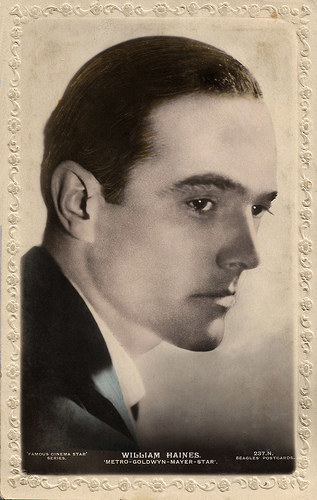
British postcard in the 'Famous Cinema Stars' series by Beagles Postcards, no. 237. N. Photo: Metro-Goldwyn-Mayer (MGM).
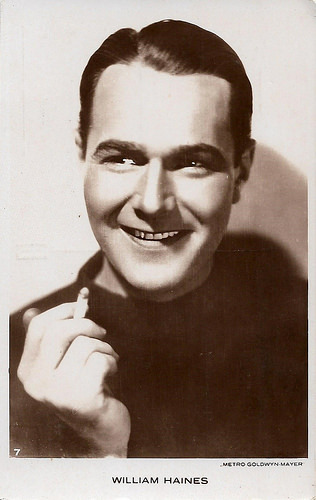
Dutch postcard by Jospe, Arnhem, no. 7. Photo: Metro-Goldwyn-Mayer.
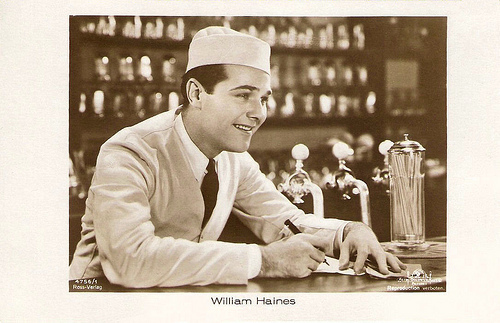
German postcard by Ross-Verlag, no. 4756/1, 1929-1930. Photo: Metro-Goldwyn-Mayer Pictures.
The New Face of 1922
Charles William Haines was born in 1900 in Staunton, Virginia. 'Billy' was the third child of George Adam Haines, a cigar maker, and Laura Virginia Haines (née Matthews). At an early age, he became fascinated with stage performance and motion pictures, spending hours watching early silent films in the local theatres.
At the age of 14, he ran off, accompanied by an unidentified young man to whom Haines referred as his 'boyfriend'. The pair went first to Richmond and then to Hopewell. His parents, frantic over his disappearance, tracked him through the police to Hopewell. Haines did not return home with them, remaining instead in Hopewell and sending money back home to help support the family. He remained in Hopewell until most of the town was destroyed by fire in 1915.
Following the bankruptcy of the family business and the mental breakdown of George, Sr., the family moved to Richmond in 1916. Haines returned home in 1917 to help support them. With his father recovered and employed, Haines moved to New York City in 1919, settling into the burgeoning gay community of Greenwich Village. He became friends with such later Hollywood luminaries as designer Orry-Kelly and Cary Grant. He worked a variety of jobs and was for a time the kept man of an older woman before becoming a model.
William Haines was an assistant bookkeeper at a New York bond house when he sent in his photograph to the 'New Faces of 1922' contest sponsored by the Samuel Goldwyn Company. He won the contest and the studio signed him to a $40 a week contract. The other winner of the contest was another future film star, Eleanor Boardman. Haines arrived in Hollywood for his first meeting with Goldwyn Co. studio brass, reportedly waltzed in and announced, "I'm your new prize beauty". His contract shifted to MGM upon the company merger.
Haines' career began slowly, as he appeared in extra and bit parts, mostly uncredited. His first significant role was in Three Wise Fools (King Vidor, 1923) with Eleanor Boardman. His performance received positive notices in contemporary reviews, and Haines was offered a choice of four new film roles after the film's success. Although the studio began building him up as a new star, he continued to play unimportant parts at Goldwyn. His career gained more momentum when he was loaned out to Columbia Pictures where he received favourable reviews for his role in The Midnight Express (George W. Hill, 1924).
Haines then was cast in Little Annie Rooney (William Beaudine, 1925) with Mary Pickford, and Brown of Harvard (Jack Conway, 1926). The latter role solidified his screen persona as a wisecracking, arrogant leading man who was forced to eat humble pie sometime before the fadeout. Other popular films with a sports setting were Slide Kelly Slide (Edward Sedgwick, 1927) and Spring Fever (Edward Sedgwick, 1927) with the young Joan Crawford.
On a trip to New York in 1926, Haines met James 'Jimmie' Shields, possibly as a pick-up on the street. Haines convinced Shields to move to Los Angeles, promising to get him work as an extra. The pair soon began living together and viewed themselves as a committed couple.
William Haines' string of hits continued with Show People (King Vidor, 1928), costarring Marion Davies . The film is a lighthearted but fast-paced look at Hollywood at the end of the silent film era and both Davies and Haines are simply wonderful. Till 1932, Haines was a top-five box-office star.
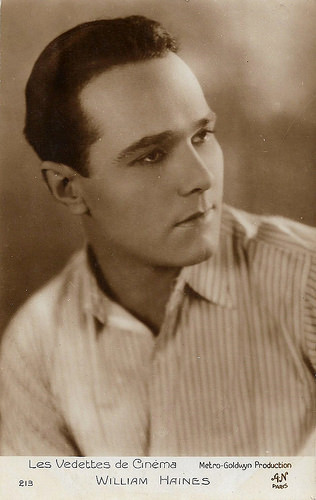
French postcard in the Les Vedettes de Cinéma series by A.N., Paris, no. 213. Photo: Metro-Goldwyn production.
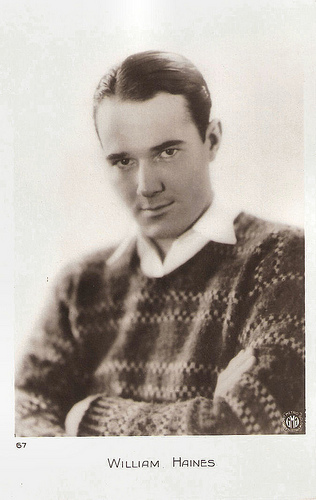
French postcard by Cinemagazine-Édition, Paris, no. 67. Photo: GMG (Gaumont-Metro-Goldwyn).
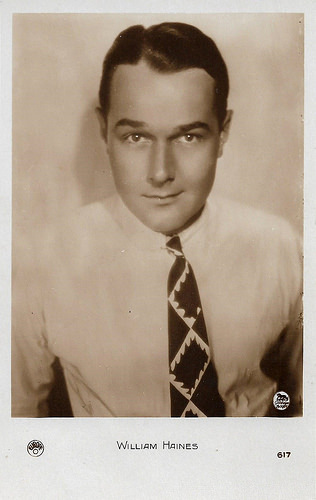
French postcard by Europe, no. 617. Photo: Metro-Goldwyn-Mayer.
Arrested in a YMCA with a sailor
When sound film arrived, many Hollywood stars could not make the transition, but William Haines continued to thrive. In fact Haines was the first MGM star to star in a talkie, the part-sound film Alias Jimmy Valentine (Jack Conway, 1928). His first all-sound film, Navy Blues (Clarence Brown, 1929), was released the following year. He starred in the comedy Way Out West (Fred Niblo, 1930). All of his sound films were successful and studio boss Irving J. Thalberg regarded him as the new model of the male romantic lead for the talking age. Haines was the biggest box-office attraction of 1929 and 1930.
In 1933, Haines was arrested in a YMCA with a sailor he had picked up in Los Angeles' Pershing Square. Louis B. Mayer, the studio head at MGM, allegedly delivered an ultimatum to Haines: Choose between a sham marriage (also known as a 'lavender marriage') or his relationship with his life partner Jimmie Shields, who he had met in New York in 1926 during a promotional tour. Haines chose Shields and they remained together for almost 50 years.
Mayer subsequently fired Haines and terminated his contract. Haines made a few minor films at Poverty Row studios and quit acting in 1935. His final film was The Marines Are Coming (David Howard, 1934) for Mascot Pictures.
Haines and Jimmie Shields started a successful dual career as interior designers and antique dealers. Their first clients were actress Leila Hyams and her husband Phil Berg, Haines' agent. 'Billie' was supported by his friends in Hollywood, like Joan Crawford and Marion Davies . He also did work for Carole Lombard, Claudette Colbert, William Powell, Mr. and Mrs. Fredric March, Joan Bennett, Constance Bennett, and Jack L. Warner.
Haines'and Shields's lives were disrupted in June 1936 when about 100 members of a white supremacist group dragged the two men from their El Porto, Manhattan Beach home and beat them, because a neighbour had accused the two of propositioning his son. The incident was widely reported at the time, but Manhattan Beach police never brought charges against the couple's attackers. The child-molestation accusations against Haines and Shields were unfounded and the case was dismissed due to a lack of evidence.
In 1939, paintings were borrowed from Haines’ personal collection to grace the grand plantation home in Gone with the Wind (Victor Fleming, 1939). Haines and Shields refurbished the American ambassador's residence in London, and created an interior decoration at the 1939-1940 Golden Gate International Exposition in San Francisco, which boasted a painting by up-and-coming artist Georgia O'Keeffe. The couple finally settled in the Hollywood community of Brentwood and their business prospered until their retirement in the early 1970s, except for a brief interruption when Haines served in World War II. Their clients included Betsy Bloomingdale and Ronald and Nancy Reagan when Reagan was governor of California.
Maintaining a home in Palm Springs, California, Haines never returned to acting, but continued to receive offers for film roles. According to IMDb , Haines was approached, along with fellow silent-screen veterans Buster Keaton and Anna Q. Nilsson, to play one of Gloria Swanson 's bridge partners in Sunset Blvd. (Billy Wilder, 1950). Swanson herself reportedly asked him to do it. Haines declined and fellow screen veteran H.B. Warner took the part.
In 1973, William Haines died of lung cancer, at the age of 73. Almost three months after his death, his lifelong partner Jimmie Shields, broken-hearted, committed suicide with an overdose of sleeping pills. Joan Crawford once called them "the happiest married couple in Hollywood." They are interred side by side in Woodlawn Memorial Cemetery in Santa Monica. Haines' story is told in the 1998 biography Wisecracker: The Life and Times of William Haines, Hollywood's First Openly Gay Star by William J. Mann. William Haines Designs, located in Los Angeles, is carrying on the Haines legacy by faithfully reissuing the original Haines furniture designs.
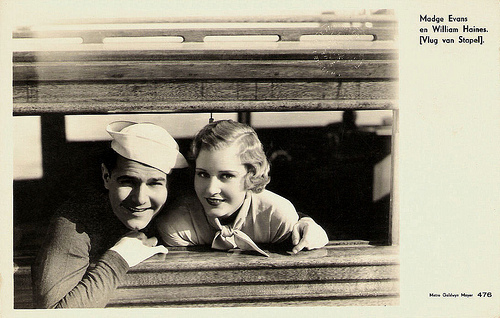
Dutch postcard, Editor unknown, no. 476. Photo: Metro-Goldwyn-Mayer. Publicity still of William Haines and Madge Evans in Fast Life (Harry A. Pollard, Sam Wood, both uncredited, 1932), released in the Netherlands as Vlug van Stapel.
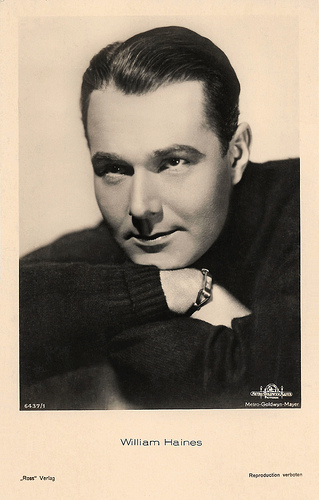
German postcard by Ross Verlag, no. 6437/1, 1931-1932. Photo: Metro-Goldwyn-Mayer (MGM).
Sources: Hal Erickson (AllMovie), (IMDb), William Haines.com, Wikipedia and .

British postcard in the 'Famous Cinema Stars' series by Beagles Postcards, no. 237. N. Photo: Metro-Goldwyn-Mayer (MGM).

Dutch postcard by Jospe, Arnhem, no. 7. Photo: Metro-Goldwyn-Mayer.

German postcard by Ross-Verlag, no. 4756/1, 1929-1930. Photo: Metro-Goldwyn-Mayer Pictures.
The New Face of 1922
Charles William Haines was born in 1900 in Staunton, Virginia. 'Billy' was the third child of George Adam Haines, a cigar maker, and Laura Virginia Haines (née Matthews). At an early age, he became fascinated with stage performance and motion pictures, spending hours watching early silent films in the local theatres.
At the age of 14, he ran off, accompanied by an unidentified young man to whom Haines referred as his 'boyfriend'. The pair went first to Richmond and then to Hopewell. His parents, frantic over his disappearance, tracked him through the police to Hopewell. Haines did not return home with them, remaining instead in Hopewell and sending money back home to help support the family. He remained in Hopewell until most of the town was destroyed by fire in 1915.
Following the bankruptcy of the family business and the mental breakdown of George, Sr., the family moved to Richmond in 1916. Haines returned home in 1917 to help support them. With his father recovered and employed, Haines moved to New York City in 1919, settling into the burgeoning gay community of Greenwich Village. He became friends with such later Hollywood luminaries as designer Orry-Kelly and Cary Grant. He worked a variety of jobs and was for a time the kept man of an older woman before becoming a model.
William Haines was an assistant bookkeeper at a New York bond house when he sent in his photograph to the 'New Faces of 1922' contest sponsored by the Samuel Goldwyn Company. He won the contest and the studio signed him to a $40 a week contract. The other winner of the contest was another future film star, Eleanor Boardman. Haines arrived in Hollywood for his first meeting with Goldwyn Co. studio brass, reportedly waltzed in and announced, "I'm your new prize beauty". His contract shifted to MGM upon the company merger.
Haines' career began slowly, as he appeared in extra and bit parts, mostly uncredited. His first significant role was in Three Wise Fools (King Vidor, 1923) with Eleanor Boardman. His performance received positive notices in contemporary reviews, and Haines was offered a choice of four new film roles after the film's success. Although the studio began building him up as a new star, he continued to play unimportant parts at Goldwyn. His career gained more momentum when he was loaned out to Columbia Pictures where he received favourable reviews for his role in The Midnight Express (George W. Hill, 1924).
Haines then was cast in Little Annie Rooney (William Beaudine, 1925) with Mary Pickford, and Brown of Harvard (Jack Conway, 1926). The latter role solidified his screen persona as a wisecracking, arrogant leading man who was forced to eat humble pie sometime before the fadeout. Other popular films with a sports setting were Slide Kelly Slide (Edward Sedgwick, 1927) and Spring Fever (Edward Sedgwick, 1927) with the young Joan Crawford.
On a trip to New York in 1926, Haines met James 'Jimmie' Shields, possibly as a pick-up on the street. Haines convinced Shields to move to Los Angeles, promising to get him work as an extra. The pair soon began living together and viewed themselves as a committed couple.
William Haines' string of hits continued with Show People (King Vidor, 1928), costarring Marion Davies . The film is a lighthearted but fast-paced look at Hollywood at the end of the silent film era and both Davies and Haines are simply wonderful. Till 1932, Haines was a top-five box-office star.

French postcard in the Les Vedettes de Cinéma series by A.N., Paris, no. 213. Photo: Metro-Goldwyn production.

French postcard by Cinemagazine-Édition, Paris, no. 67. Photo: GMG (Gaumont-Metro-Goldwyn).

French postcard by Europe, no. 617. Photo: Metro-Goldwyn-Mayer.
Arrested in a YMCA with a sailor
When sound film arrived, many Hollywood stars could not make the transition, but William Haines continued to thrive. In fact Haines was the first MGM star to star in a talkie, the part-sound film Alias Jimmy Valentine (Jack Conway, 1928). His first all-sound film, Navy Blues (Clarence Brown, 1929), was released the following year. He starred in the comedy Way Out West (Fred Niblo, 1930). All of his sound films were successful and studio boss Irving J. Thalberg regarded him as the new model of the male romantic lead for the talking age. Haines was the biggest box-office attraction of 1929 and 1930.
In 1933, Haines was arrested in a YMCA with a sailor he had picked up in Los Angeles' Pershing Square. Louis B. Mayer, the studio head at MGM, allegedly delivered an ultimatum to Haines: Choose between a sham marriage (also known as a 'lavender marriage') or his relationship with his life partner Jimmie Shields, who he had met in New York in 1926 during a promotional tour. Haines chose Shields and they remained together for almost 50 years.
Mayer subsequently fired Haines and terminated his contract. Haines made a few minor films at Poverty Row studios and quit acting in 1935. His final film was The Marines Are Coming (David Howard, 1934) for Mascot Pictures.
Haines and Jimmie Shields started a successful dual career as interior designers and antique dealers. Their first clients were actress Leila Hyams and her husband Phil Berg, Haines' agent. 'Billie' was supported by his friends in Hollywood, like Joan Crawford and Marion Davies . He also did work for Carole Lombard, Claudette Colbert, William Powell, Mr. and Mrs. Fredric March, Joan Bennett, Constance Bennett, and Jack L. Warner.
Haines'and Shields's lives were disrupted in June 1936 when about 100 members of a white supremacist group dragged the two men from their El Porto, Manhattan Beach home and beat them, because a neighbour had accused the two of propositioning his son. The incident was widely reported at the time, but Manhattan Beach police never brought charges against the couple's attackers. The child-molestation accusations against Haines and Shields were unfounded and the case was dismissed due to a lack of evidence.
In 1939, paintings were borrowed from Haines’ personal collection to grace the grand plantation home in Gone with the Wind (Victor Fleming, 1939). Haines and Shields refurbished the American ambassador's residence in London, and created an interior decoration at the 1939-1940 Golden Gate International Exposition in San Francisco, which boasted a painting by up-and-coming artist Georgia O'Keeffe. The couple finally settled in the Hollywood community of Brentwood and their business prospered until their retirement in the early 1970s, except for a brief interruption when Haines served in World War II. Their clients included Betsy Bloomingdale and Ronald and Nancy Reagan when Reagan was governor of California.
Maintaining a home in Palm Springs, California, Haines never returned to acting, but continued to receive offers for film roles. According to IMDb , Haines was approached, along with fellow silent-screen veterans Buster Keaton and Anna Q. Nilsson, to play one of Gloria Swanson 's bridge partners in Sunset Blvd. (Billy Wilder, 1950). Swanson herself reportedly asked him to do it. Haines declined and fellow screen veteran H.B. Warner took the part.
In 1973, William Haines died of lung cancer, at the age of 73. Almost three months after his death, his lifelong partner Jimmie Shields, broken-hearted, committed suicide with an overdose of sleeping pills. Joan Crawford once called them "the happiest married couple in Hollywood." They are interred side by side in Woodlawn Memorial Cemetery in Santa Monica. Haines' story is told in the 1998 biography Wisecracker: The Life and Times of William Haines, Hollywood's First Openly Gay Star by William J. Mann. William Haines Designs, located in Los Angeles, is carrying on the Haines legacy by faithfully reissuing the original Haines furniture designs.

Dutch postcard, Editor unknown, no. 476. Photo: Metro-Goldwyn-Mayer. Publicity still of William Haines and Madge Evans in Fast Life (Harry A. Pollard, Sam Wood, both uncredited, 1932), released in the Netherlands as Vlug van Stapel.

German postcard by Ross Verlag, no. 6437/1, 1931-1932. Photo: Metro-Goldwyn-Mayer (MGM).
Sources: Hal Erickson (AllMovie), (IMDb), William Haines.com, Wikipedia and .
Published on December 18, 2018 22:00
December 17, 2018
Victor Mature
Hunky American leading man Victor Mature (1913-1999) starred in Biblical Epics like Samson and Delilah (1949), and The Robe (1953). He was known for his dark good looks and mega-watt smile. Mature also appeared in the classics One Million B.C. (1940), My Darling Clementine (1946), Kiss of Death (1947), and in a large number of musicals opposite such stars as Rita Hayworth and Betty Grable.
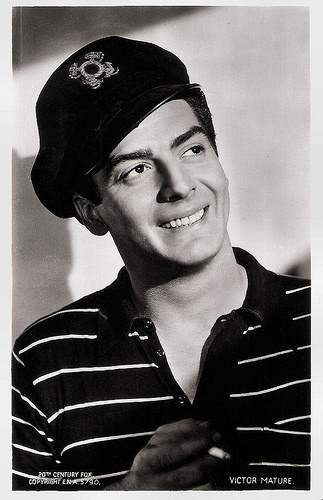
British Real Photograph postcard, no. 5790. Photo: 20th Century Fox. Publicity still for Song of the Islands (Walter Lang, 1942).
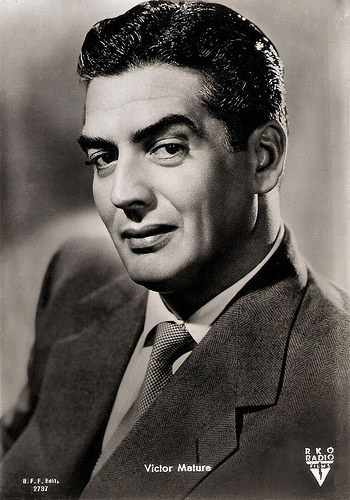
Italian postcard by B.F.F. Edit, no. 2787. Photo: RKO Radio Films.
What a beautiful hunk of man!
Victor John Mature was born in Louisville, Kentucky, in 1913. His father, cutlery sharpener Marcellus George (Gelindo) Mature, was Italian (from Pinzolo, Trentino), and his mother, Clara P. (Ackley) was of Swiss-German and German descent.
Mature worked as a teenager with his father as a salesman for butcher supplies. He briefly sold candy and operated a restaurant before moving to California. Hoping to become an actor, he studied at the Pasadena Playhouse in California. For three years, he lived in a tent in the backyard of the mother of a fellow student, Catherine Lewis.
He was spotted by an agent for Hal Roach while acting in a production of To Quito and Back by Ben Hecht at the Pasadena Playhouse, Mature signed a seven-year contract with Roach in September 1939. He auditioned for Gone with the Wind (Victor Fleming, 1939) for the role ultimately played by his fellow Playhouse student, George Reeves.
Roach cast Mature in a small role in the comedy The Housekeeper's Daughter (Hal Roach, 1939), then gave him his first leading role, as a fur-clad caveman in One Million B.C. (Hal Roach Jr., Hal Roach, 1940) opposite Carole Landis. The film was highly publicised and it raised Mature's profile. Hedda Hopper called him "a sort of miniature Johnny Weissmuller ".
Roach then put him in a Swashbuckler set during the War of 1812, Captain Caution (Richard Wallace, 1940). As Hal Roach only made a handful of films every year, he loaned out Mature's services to RKO, who used him as a leading man in the Anna Neagle musical, No, No, Nanette (Herbert Wilcox, 1940). The studio people were so pleased with his performance, they bought an option to take over half of Mature's contract with Hal Roach, enabling them to draw on his services for two films a year over three years.
Mature also appeared in the Broadway musical Lady in the Dark (1941) with a book by Moss Hart and songs from Ira Gershwin and Kurt Weill. He played Randy Curtis, a film star boyfriend of the show's protagonist, magazine editor Liza Elliott (Gertrude Lawrence). In the musical his character was described as 'What a beautiful hunk of man!' The musical was a smash hit, making a star of Danny Kaye and Macdonald Carey, and causing fresh appreciation for Mature's talents.
His performance was well received and the description 'Beautiful Hunk of Man' would be frequently used to describe Mature throughout his career. Fox bought out the four years remaining on Mature's contract with Hal Roach and he appeared in such popular musicals as My Gal Sal (Irving Cummings, 1942) with Rita Hayworth , and Footlight Serenade (Gregory Ratoff, 1942) with Betty Grable. After achieving acclaim with these films, he served in the Coast Guard in World War II. This meant that when Paramount filmed Lady in the Dark, Mature was unable to reprise his stage role.
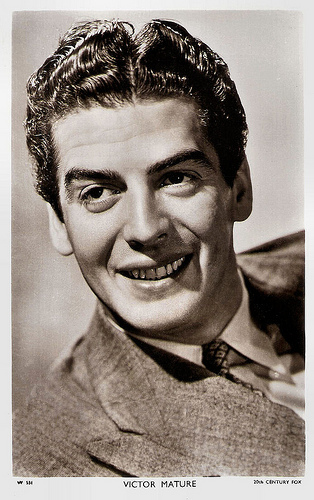
British postcard in the Picturegoer Series, London, no. W 531. Photo: 20th Century Fox.
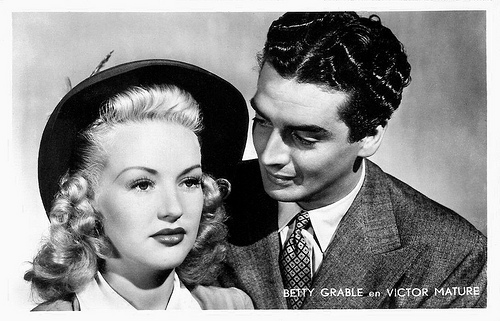
Dutch postcard by Uitg. J. Sleding N.V., Amsterdam, no. 33. Photo: 20th Century Fox. Publicity still for I Wake Up Screaming (H. Bruce Humberstone, 1941) with Betty Grable.
A man who was 100 percent yellow
Victor Mature was honourably discharged from the Coast Guard in November 1945 and he resumed his acting career. Soon, he became one of Hollywood's busiest and most popular actors, though he was rarely given the critical respect he often deserved. His roles in John Ford's My Darling Clementine (1946) playing Doc Holliday opposite Henry Fonda's Wyatt Earp, and in Henry Hathaway's Kiss of Death (1947) were among his finest work.
Mature's career received a massive lift when he was borrowed by Cecil B. DeMille at Paramount to play the lead in the $3.5 million biblical spectacular Samson and Delilah (1949) opposite Hedy Lamarr . Despite his physique and his tough guy persona, Mature was a man of many fears and phobias. During filming, Mature was frightened by a number of the animals and mechanical props used in the production, including the lions, the wind machine, the swords and even the water.
This infuriated director Cecil DeMille, who bellowed through his megaphone at the assembled cast and crew: "I have met a few men in my time. Some have been afraid of heights, some have been afraid of water, some have been afraid of fire, some have been afraid of closed spaces. Some have even been afraid of open spaces - or themselves. But in all my 35 years of picture-making experience, Mr. Mature, I have not until now met a man who was 100 percent yellow."
Groucho Marx famously said he would not go to see the film because "the leading man's tits are bigger than the leading lady's". However, Samson and Delilah earned over $12 million during its original run, making it the most popular Hollywood movie of the 1940s. It ushered in a cycle of spectacles set in the Ancient World.
Mature starred in such epics as Androcles and the Lion (Chester Erskine, 1952) opposite Jean Simmons , Demetrius and the Gladiators (Delmer Daves, 1954) with Susan Hayward, and The Egyptian (Michael Curtiz, 1954) with Jean Simmons and Gene Tierney . Jim Beaver at IMDb : "Never an energetic actor nor one of great artistic pretensions, he nevertheless continued as a Hollywood stalwart both in programme and in more prominent films like The Robe (1953)."
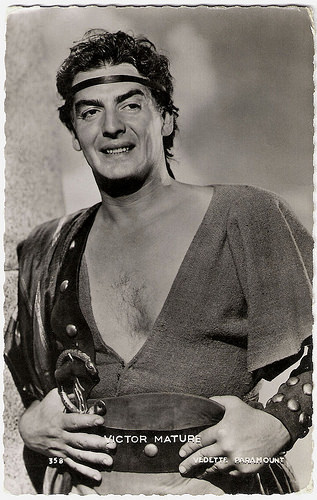
French postcard by Editions P.I., Paris, no. 358, 1954. Photo: Paramount Pictures Inc.. Publicity still for Samson and Delilah (Cecil B. DeMille, 1949).
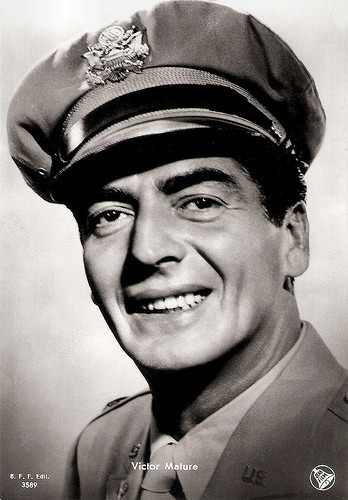
Italian postcard by B.F.F. Edit, no. 3589. Photo: Dear Film. Publicity still for China Doll (Frank Borzage, 1958).
I'm not an actor - and I've got 64 films to prove it!
More interested in golf than acting, Victor Mature's appearances diminished through the late 1950s and 1960s. Applying for membership in the swank Los Angeles Country Club at the height of his fame, Mature was turned down and told that the golfing facility did not accept actors as members. His response: "I'm not an actor - and I've got 64 films to prove it!"
Mature was reunited with producer Irwin Allen for The Big Circus (Joseph M. Newman, 1959) with Red Buttons. In Italy, he starred in the Peplum Annibale/Hannibal (Carlo Ludovico Bragaglia, Edgar G. Ulmer, 1959), with Gabriele Ferzetti and Rita Gam . In Italy, he also appeared in I tartari/The Tartars (Richard Thorpe, 1961) with Orson Welles .
Mature then retired from acting. Five years later, he made a stunning comeback in the hilarious Italian-British comedy Caccia alla volpe/After the Fox (Vittorio de Sica, 1966), based on a play by Neil Simon. He starred opposite Peter Sellers and Britt Ekland as Tony Powell, an ageing American actor who is living off his reputation from his earlier body of work.
In a similar vein, he played a giant, The Big Victor, in The Monkees film Head (Bob Rafelson, 1968). Golf eventually took over his activities. Wikipedia quotes him saying: "Actually, I am a golfer. That is my real occupation. I never was an actor. Ask anybody, particularly the critics."
His last feature film appearance was a cameo as a millionaire in Firepower (Michael Winner, 1979), starring Sophia Loren and James Coburn, and, after a cameo as Samson's father in the TV remake Samson and Delilah (Lee Philips, 1984), he retired for good. Rumours occasionally surfaced of another comeback, but none came to fruition.
Victor Mature died of cancer at his Rancho Santa Fe, California, home in 1999. Mature was married five times. His wives were actress Frances Charles (1938–1940), Martha Stephenson Kemp (1941–1943), Dorothy Stanford Berry (1948–1955), Adrienne Urwick (1959–1969) and Loretta Sebena (1974 until his death). With Sebena, he had his only child, daughter Victoria, who is now an opera singer as was her mother.
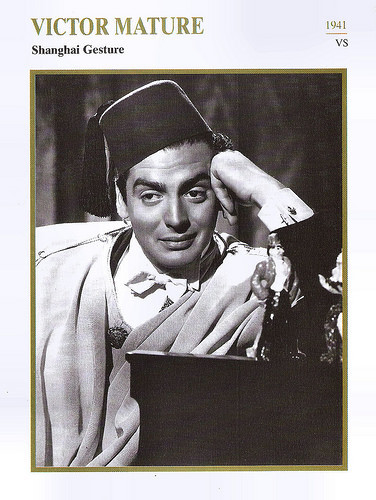
Dutch collectors card in the Filmsterren: een Portret series by Edito Service S.A., 1996. Photo: United Artists / The Kobal Collection. Publicity still for Shanghai Gesture (Josef von Sternberg, 1941).
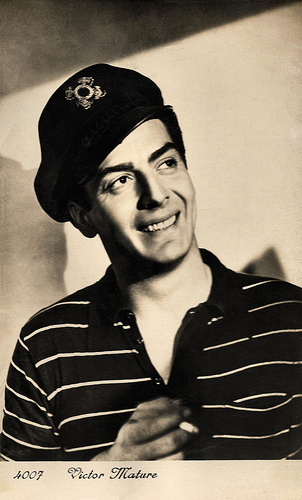
French postcard, no. 4007. Photo: 20th Century Fox. Publicity still for Song of the Islands (Walter Lang, 1942).
Sources: (IMDb), Wikipedia and .

British Real Photograph postcard, no. 5790. Photo: 20th Century Fox. Publicity still for Song of the Islands (Walter Lang, 1942).

Italian postcard by B.F.F. Edit, no. 2787. Photo: RKO Radio Films.
What a beautiful hunk of man!
Victor John Mature was born in Louisville, Kentucky, in 1913. His father, cutlery sharpener Marcellus George (Gelindo) Mature, was Italian (from Pinzolo, Trentino), and his mother, Clara P. (Ackley) was of Swiss-German and German descent.
Mature worked as a teenager with his father as a salesman for butcher supplies. He briefly sold candy and operated a restaurant before moving to California. Hoping to become an actor, he studied at the Pasadena Playhouse in California. For three years, he lived in a tent in the backyard of the mother of a fellow student, Catherine Lewis.
He was spotted by an agent for Hal Roach while acting in a production of To Quito and Back by Ben Hecht at the Pasadena Playhouse, Mature signed a seven-year contract with Roach in September 1939. He auditioned for Gone with the Wind (Victor Fleming, 1939) for the role ultimately played by his fellow Playhouse student, George Reeves.
Roach cast Mature in a small role in the comedy The Housekeeper's Daughter (Hal Roach, 1939), then gave him his first leading role, as a fur-clad caveman in One Million B.C. (Hal Roach Jr., Hal Roach, 1940) opposite Carole Landis. The film was highly publicised and it raised Mature's profile. Hedda Hopper called him "a sort of miniature Johnny Weissmuller ".
Roach then put him in a Swashbuckler set during the War of 1812, Captain Caution (Richard Wallace, 1940). As Hal Roach only made a handful of films every year, he loaned out Mature's services to RKO, who used him as a leading man in the Anna Neagle musical, No, No, Nanette (Herbert Wilcox, 1940). The studio people were so pleased with his performance, they bought an option to take over half of Mature's contract with Hal Roach, enabling them to draw on his services for two films a year over three years.
Mature also appeared in the Broadway musical Lady in the Dark (1941) with a book by Moss Hart and songs from Ira Gershwin and Kurt Weill. He played Randy Curtis, a film star boyfriend of the show's protagonist, magazine editor Liza Elliott (Gertrude Lawrence). In the musical his character was described as 'What a beautiful hunk of man!' The musical was a smash hit, making a star of Danny Kaye and Macdonald Carey, and causing fresh appreciation for Mature's talents.
His performance was well received and the description 'Beautiful Hunk of Man' would be frequently used to describe Mature throughout his career. Fox bought out the four years remaining on Mature's contract with Hal Roach and he appeared in such popular musicals as My Gal Sal (Irving Cummings, 1942) with Rita Hayworth , and Footlight Serenade (Gregory Ratoff, 1942) with Betty Grable. After achieving acclaim with these films, he served in the Coast Guard in World War II. This meant that when Paramount filmed Lady in the Dark, Mature was unable to reprise his stage role.

British postcard in the Picturegoer Series, London, no. W 531. Photo: 20th Century Fox.

Dutch postcard by Uitg. J. Sleding N.V., Amsterdam, no. 33. Photo: 20th Century Fox. Publicity still for I Wake Up Screaming (H. Bruce Humberstone, 1941) with Betty Grable.
A man who was 100 percent yellow
Victor Mature was honourably discharged from the Coast Guard in November 1945 and he resumed his acting career. Soon, he became one of Hollywood's busiest and most popular actors, though he was rarely given the critical respect he often deserved. His roles in John Ford's My Darling Clementine (1946) playing Doc Holliday opposite Henry Fonda's Wyatt Earp, and in Henry Hathaway's Kiss of Death (1947) were among his finest work.
Mature's career received a massive lift when he was borrowed by Cecil B. DeMille at Paramount to play the lead in the $3.5 million biblical spectacular Samson and Delilah (1949) opposite Hedy Lamarr . Despite his physique and his tough guy persona, Mature was a man of many fears and phobias. During filming, Mature was frightened by a number of the animals and mechanical props used in the production, including the lions, the wind machine, the swords and even the water.
This infuriated director Cecil DeMille, who bellowed through his megaphone at the assembled cast and crew: "I have met a few men in my time. Some have been afraid of heights, some have been afraid of water, some have been afraid of fire, some have been afraid of closed spaces. Some have even been afraid of open spaces - or themselves. But in all my 35 years of picture-making experience, Mr. Mature, I have not until now met a man who was 100 percent yellow."
Groucho Marx famously said he would not go to see the film because "the leading man's tits are bigger than the leading lady's". However, Samson and Delilah earned over $12 million during its original run, making it the most popular Hollywood movie of the 1940s. It ushered in a cycle of spectacles set in the Ancient World.
Mature starred in such epics as Androcles and the Lion (Chester Erskine, 1952) opposite Jean Simmons , Demetrius and the Gladiators (Delmer Daves, 1954) with Susan Hayward, and The Egyptian (Michael Curtiz, 1954) with Jean Simmons and Gene Tierney . Jim Beaver at IMDb : "Never an energetic actor nor one of great artistic pretensions, he nevertheless continued as a Hollywood stalwart both in programme and in more prominent films like The Robe (1953)."

French postcard by Editions P.I., Paris, no. 358, 1954. Photo: Paramount Pictures Inc.. Publicity still for Samson and Delilah (Cecil B. DeMille, 1949).

Italian postcard by B.F.F. Edit, no. 3589. Photo: Dear Film. Publicity still for China Doll (Frank Borzage, 1958).
I'm not an actor - and I've got 64 films to prove it!
More interested in golf than acting, Victor Mature's appearances diminished through the late 1950s and 1960s. Applying for membership in the swank Los Angeles Country Club at the height of his fame, Mature was turned down and told that the golfing facility did not accept actors as members. His response: "I'm not an actor - and I've got 64 films to prove it!"
Mature was reunited with producer Irwin Allen for The Big Circus (Joseph M. Newman, 1959) with Red Buttons. In Italy, he starred in the Peplum Annibale/Hannibal (Carlo Ludovico Bragaglia, Edgar G. Ulmer, 1959), with Gabriele Ferzetti and Rita Gam . In Italy, he also appeared in I tartari/The Tartars (Richard Thorpe, 1961) with Orson Welles .
Mature then retired from acting. Five years later, he made a stunning comeback in the hilarious Italian-British comedy Caccia alla volpe/After the Fox (Vittorio de Sica, 1966), based on a play by Neil Simon. He starred opposite Peter Sellers and Britt Ekland as Tony Powell, an ageing American actor who is living off his reputation from his earlier body of work.
In a similar vein, he played a giant, The Big Victor, in The Monkees film Head (Bob Rafelson, 1968). Golf eventually took over his activities. Wikipedia quotes him saying: "Actually, I am a golfer. That is my real occupation. I never was an actor. Ask anybody, particularly the critics."
His last feature film appearance was a cameo as a millionaire in Firepower (Michael Winner, 1979), starring Sophia Loren and James Coburn, and, after a cameo as Samson's father in the TV remake Samson and Delilah (Lee Philips, 1984), he retired for good. Rumours occasionally surfaced of another comeback, but none came to fruition.
Victor Mature died of cancer at his Rancho Santa Fe, California, home in 1999. Mature was married five times. His wives were actress Frances Charles (1938–1940), Martha Stephenson Kemp (1941–1943), Dorothy Stanford Berry (1948–1955), Adrienne Urwick (1959–1969) and Loretta Sebena (1974 until his death). With Sebena, he had his only child, daughter Victoria, who is now an opera singer as was her mother.

Dutch collectors card in the Filmsterren: een Portret series by Edito Service S.A., 1996. Photo: United Artists / The Kobal Collection. Publicity still for Shanghai Gesture (Josef von Sternberg, 1941).

French postcard, no. 4007. Photo: 20th Century Fox. Publicity still for Song of the Islands (Walter Lang, 1942).
Sources: (IMDb), Wikipedia and .
Published on December 17, 2018 22:00
December 16, 2018
Norma Talmadge
Norma Talmadge (1894-1957) was an American actress and film producer of the silent era. A major box-office draw for more than a decade, her career reached a peak in the early 1920s, when she ranked among the most popular idols of the American screen.
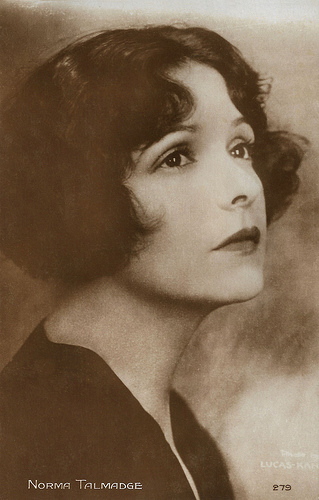
French postcard by Editions Cinémagazine, no. 279. Photo: Lucas Kanarian.
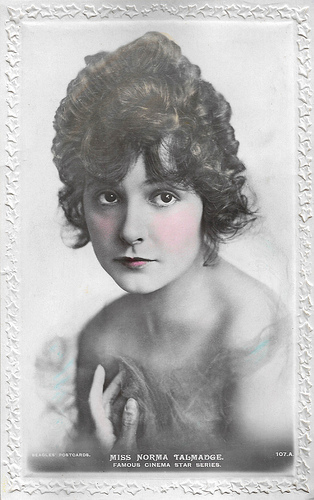
British postcard in the Famous Cinema Star series by J. Beagles & Co. Ltd., no. 107.A.
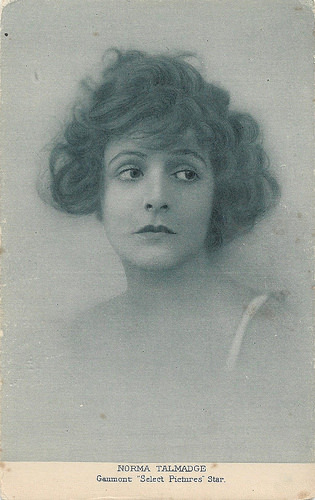
British postcard. Caption: Norma Talmadge, Gaumont "Select Pictures" Star. Gaumont must refer to the distribution and not the production company, as Talmadge did not act in films produced by Gaumont. Select Pictures was an American company run by Lewis J. Selznick and Adolph Zukor and was active between 1917 and 1923. Select Pictures Corporation was formed when Adolph Zukor acquired 50 percent ownership in Selznick Pictures Corporation. Selznick later bought back the company and changed the name back to Selznick Pictures Corporation. The company went bankrupt in 1923.
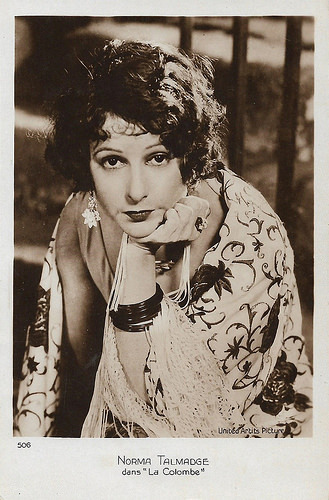
French postcard, no. 506. Photo: United Artists. Publicity still for The Dove (Roland West, 1927). The French title is La Colombe.
Abandoned by her alcoholic and jobless father on Christmas Day
Norma Marie Talmadge was born in 1894 in Jersey City, New Jersey. She was the daughter of one of the most famous 'mothers of artists' in film history: Margaret 'Peg' Talmadge, the prototypical Hollywood stage mother.
Norma, her mother Peggy and her sisters Natalie and Constance were abandoned by their alcoholic and jobless father Fred Talmadge right on Christmas Day. Her mother took in laundry to help make ends meet, and the three teenagers had to start earning money as vaudeville models and actresses.
In 1909, Norma began working in the cinema thanks to her discoverer, Vitagraph editor Breta Breuill. She landed a small role in The Household Pest (1910).
With her mother's prodding, she landed more small roles in numerous Vitagraph shorts, a.o. Uncle Tom's Cabin (J. Stuart Blackton, 1910) with Florence Turner, Love of Chrysanthemum (Van Dyke Brooke, 1910) with Maurice Costello, and A Tale of Two Cities (William Humphrey, 1911).
Helped by Vitagraph leading actor Maurice Costello, her career blossomed. By 1913, she was the major star of Vitagraph Studios, and had played in hundreds of shorts there. Her co-actors from the Vitagraph 'stable' were a.o. Van Dyke Brooke, Lilian Walker, Hughie Mack, Leo Delaney and Clara Kimball Young.
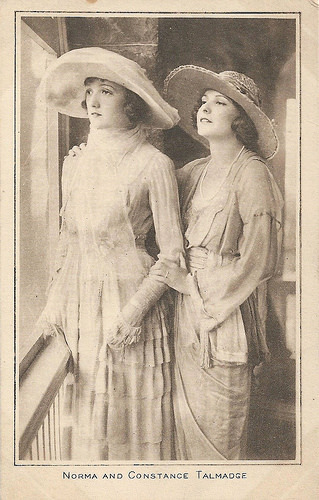
With sister Constance Talmadge. British postcard in the 'Pictures' Portrait Gallery, no. 195. Photo: Pictures Ltd., London.
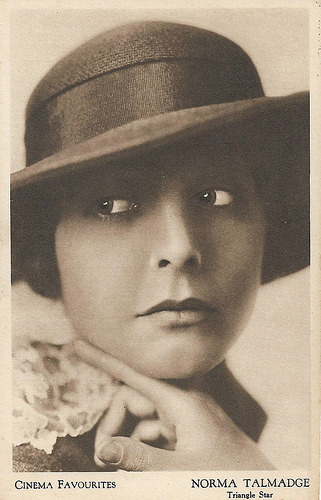
British postcard. Cinema Favourites was a series of Photochrom Co. Ltd. of London, in collaboration with the American film company Triangle Pictures.
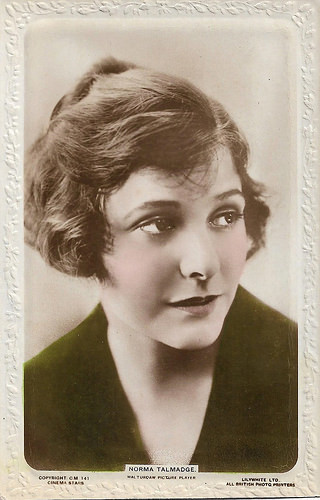
British postcard in the Cinema Stars series by Lilywhite Ltd., no. CM 141. Photo: Walturdaw Pictures. Walturdaw was an early British film production company which stopped filming in 1911, continuing as film distributor until 1924. So this card refers to the years 1911-1924.
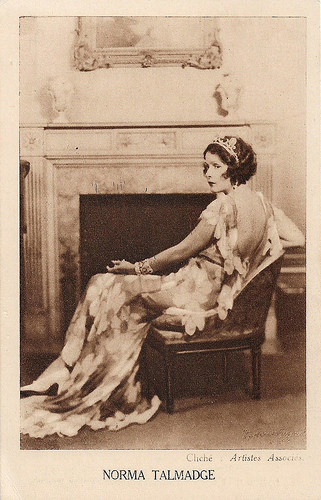
Dutch postcard by De Faam, P.A. De Bont's Fabriek van Chocolade en Suikerwerken, Breda. Photo: Artistes Associés (United Artists).
Smitten by her, Schenck proposed a marriage and a studio
In 1915, Norma Talmadge had her breakthrough when she acted in Vitagraph's anti-German propaganda-film, the feature The Battlecry for Peace. But, mother Talmadge was unsatisfied with Vitagraph and arranged a two-year contract at National Pictures. In August of 1915, Norma and her mother left for California and the promise of success in the fledgling film industry there.
Yet, Norma's first film there, Captivating Mary Carstairs (1915) flopped, and National Pictures went bankrupt. During this time her sister, Constance Talmadge, was working for legendary director D.W. Griffith. Constance managed to get Norma a contract with Griffith's film studio Triangle. Over the following eight months Norma made seven feature films and a few shorts for Triangle. After the contract ran out, the family returned to the East Coast.
In 1916, Talmadge met and married Joseph M. Schenck, a wealthy exhibitor who wanted to make films himself. Smitten by her, Schenck proposed a marriage and a studio. They founded the Norma Talmadge Film Corporation.
In Schenck's New York based studio, Norma would act in her dramas on the ground floor, while her sister Constance Talmadge would do comedies on the first floor, and the comic unit with Fatty Arbuckle played on the top floor, while sister Natalie Talmadge worked as a secretary and occasionally had small parts as well.
Fatty Arbuckle brought along his colleagues Buster Keaton and Al St. John. When Arbuckle was lent to Paramount to do features, Keaton took over the comic unit and married Natalie.
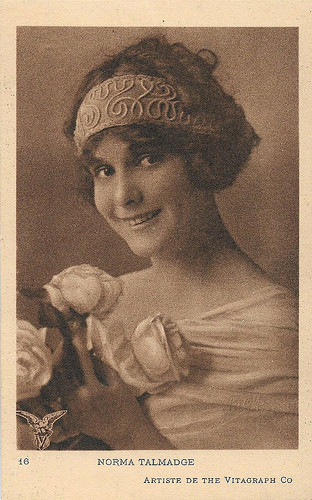
French postcard. Caprion: Norma Talmadge, artist of The Vitagraph Co., no. 16. In contrast to most American film companies, who had London as their hub for the European film distribution market, Vitagraph had opened an office in Paris, and arranged its European publicity from there, including the astonishing film posters (de)signed by Harry Bedos. Between 1909 and 1915 Norma Talmadge was one of the regular actors at Vitagraph, acting in hundreds of shorts, but also in the feature The Battlecry for Peace (J. Stuart Blackton, Wilfrid North, 1915).
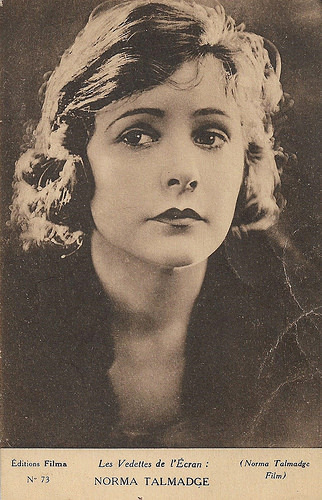
French postcard in the Les Vedettes de l'Ecran series by Editions Filma, no. 73. Photo: Norma Talmadge Film.
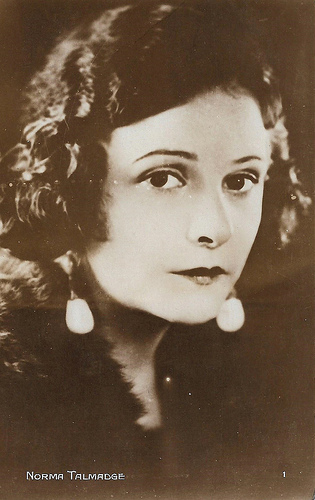
French postcard by Editions Cinémagazine, no. 1. This is the first postcard of the vast series of film star postcards issued by the French film journal Cinémagazine.
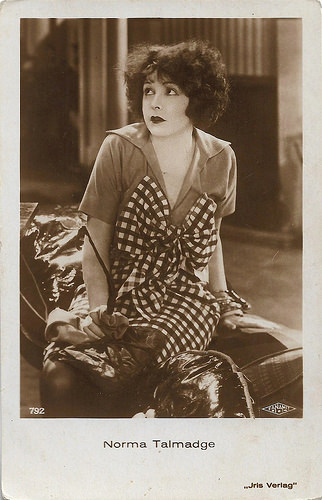
Austrian postcard by Iris Verlag, no. 792. Photo: Fanamet.
She fell in love with her co-star, and asked Schenck for a divorce
Norma Talmadge's first film at her own studio, Panthea (Allan Dwan, 1917) was a straight hit. Between 1917 and 1921, Norma made four to six films per year, under Joseph Schenck's supervision.
After her greatest success, the drama Smilin' Through (Sydney Franklin, 1922), Schenck closed the New York studio. The family continued in Hollywood, where Norma's films became bigger and glossier.
She worked with top directors, cinematographers and costume designers and by 1923 she was the best paid film actress in Hollywood, earning 10.000 dollar a week. In 1924 under Frank Borzage's direction she did her best film - artistically and at the box office - Secrets (Frank Borzage, 1924).
While Schenck became head of United Artists in 1924, Norma was still tied to distributor First National by contract, and continued to make films for them in the mid-1920s, including Camille (Fred Niblo, 1926).
During filming of Camille, she fell in love with her co-actor Gilbert Roland, and asked Schenck for a divorce. Schenck refused the divorce but saw Talmadge and Roland were a winning couple and matched them in several films. After that, she made films with United Artists, but the first two were flops.
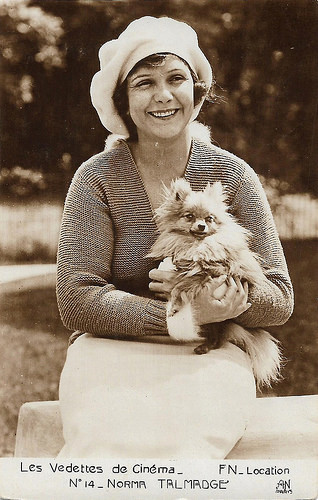
French postcard in the Les Vedettes de Cinéma series by A.N., Paris, no. 14.
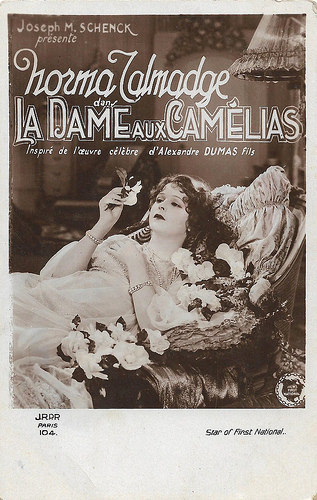
French postcard by J.R.P.R., Paris, no. 104. Photo: First National. Publicity still for Camille (Fred Niblo, 1926). Produced by Joseph Schenck, the later producer of United Artists, and based on the famous novel by Alexandre Dumas fils.
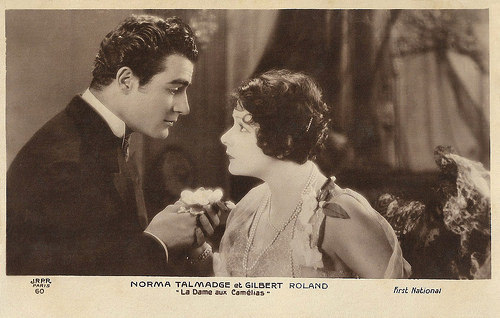
French postcard by J.R.P.R., Paris, no. 60. Photo: First National. Publicity still for Camille (Fred Niblo, 1926) with Gilbert Roland.
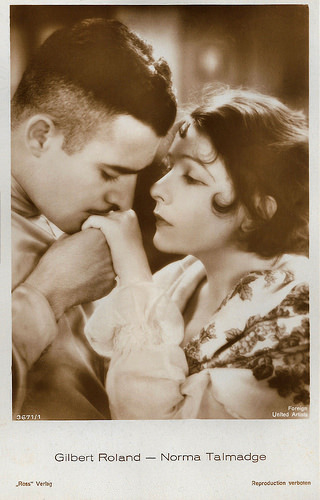
German postcard by Ross Verlag Foreign, no. 3671/1, 1928-1929. Photo: United Artists. Publicity still for The Woman Disputed (Henry King, Sam Taylor, 1928) with Gilbert Roland.
Falling on wet cement in front of the Grauman's Chinese Theatre
By 1928, Norma Talmadge's popularity had begun to fade. Her final silent film, The Woman Disputed (Henry King, Sam Taylor, 1928), was a flop at the box-office. By that time sound film was all the rage. Norma took voice lessons for a year, and despite expectations, produced a perfectly non-dialectical voice.
Her first two sound films, New York Nights (Lewis Milestone, 1929) with Gilbert Roland, and Du Barry, Woman of Passion (Sam Taylor, 1930) with William Farnum and Conrad Nagel, simply weren't so good. So she called it a day and left the film world
As Talmadge was very rich by now, she could permit herself to do so. In 1927, Norma and her sisters had opened the Talmadge Park real estate development in San Diego, California, USA. Now known as the Talmadge district, the development contains streets named for each of the sisters.
Norma Talmadge and Joseph M. Schenck divorced in 1934, but Schenck continued to act as her financial adviser and guided her business affairs. In 1934, she married her second husband, George Jessel, who eagerly brought her on his ailing radio shows. She thought this might be the vehicle by which she would revive her stalled film career, but the show continued its decline and was ultimately cancelled, and with it the hopes of rebuilding her shattered career. She divorced Jessel in 1939.
Norma married for the third time in 1946, with Dr. Carvel Musser James. She remained with him until she died of a stroke or pneumonia (the sources differ) on Christmas Eve of 1957 in Las Vegas, Nevada. She was 64.
It is said that we owe to Norma Talmadge the tradition of stamping the handprints of the stars in front of the Grauman's Chinese Theatre, when in 1927, accidentally, she left her own when falling on wet cement in the same place.
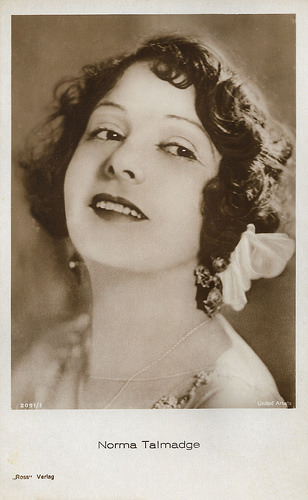
German postcard by Ross Verlag, no. 2091/1, 1927-1928. Photo: United Artists. Publicity still for The Dove (Roland West, 1927).
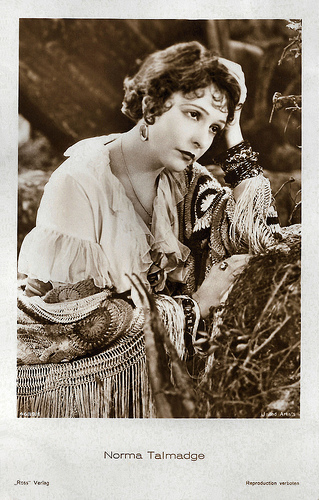
German postcard by Ross Verlag, no. 4639/1, 1929-1930. Photo: United Artists. Publicity still for The Dove (Roland West, 1927).
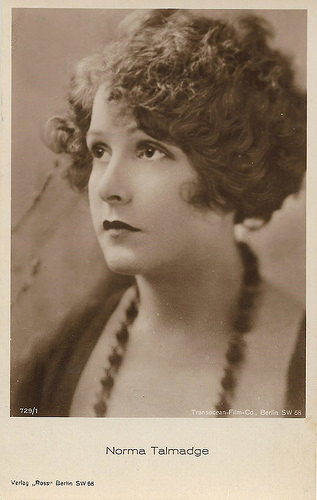
German postcard by Ross Verlag, no. 729/1, 1925-1926. Photo: Transocean-Film-Company, Berlin.
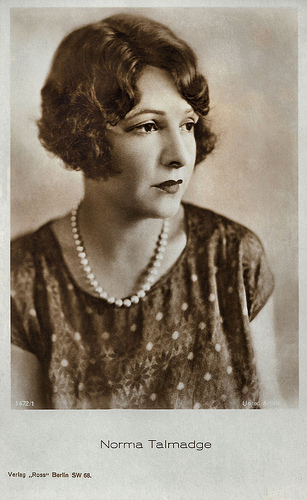
German postcard by Ross Verlag, no. 1472/1, 1927-1928. Photo: United Artists.
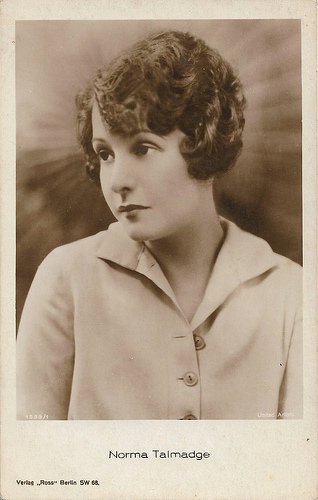
German postcard by Ross Verlag, no. 1539/1. Photo: United Artists.
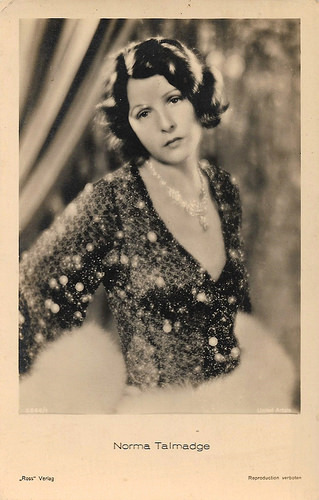
German postcard by Ross Verlag, no. 5866/1, 1930-1931. Photo: United Artists.
Sources: (IMDb), Wikipedia (English, Dutch and Spanish) and .

French postcard by Editions Cinémagazine, no. 279. Photo: Lucas Kanarian.

British postcard in the Famous Cinema Star series by J. Beagles & Co. Ltd., no. 107.A.

British postcard. Caption: Norma Talmadge, Gaumont "Select Pictures" Star. Gaumont must refer to the distribution and not the production company, as Talmadge did not act in films produced by Gaumont. Select Pictures was an American company run by Lewis J. Selznick and Adolph Zukor and was active between 1917 and 1923. Select Pictures Corporation was formed when Adolph Zukor acquired 50 percent ownership in Selznick Pictures Corporation. Selznick later bought back the company and changed the name back to Selznick Pictures Corporation. The company went bankrupt in 1923.

French postcard, no. 506. Photo: United Artists. Publicity still for The Dove (Roland West, 1927). The French title is La Colombe.
Abandoned by her alcoholic and jobless father on Christmas Day
Norma Marie Talmadge was born in 1894 in Jersey City, New Jersey. She was the daughter of one of the most famous 'mothers of artists' in film history: Margaret 'Peg' Talmadge, the prototypical Hollywood stage mother.
Norma, her mother Peggy and her sisters Natalie and Constance were abandoned by their alcoholic and jobless father Fred Talmadge right on Christmas Day. Her mother took in laundry to help make ends meet, and the three teenagers had to start earning money as vaudeville models and actresses.
In 1909, Norma began working in the cinema thanks to her discoverer, Vitagraph editor Breta Breuill. She landed a small role in The Household Pest (1910).
With her mother's prodding, she landed more small roles in numerous Vitagraph shorts, a.o. Uncle Tom's Cabin (J. Stuart Blackton, 1910) with Florence Turner, Love of Chrysanthemum (Van Dyke Brooke, 1910) with Maurice Costello, and A Tale of Two Cities (William Humphrey, 1911).
Helped by Vitagraph leading actor Maurice Costello, her career blossomed. By 1913, she was the major star of Vitagraph Studios, and had played in hundreds of shorts there. Her co-actors from the Vitagraph 'stable' were a.o. Van Dyke Brooke, Lilian Walker, Hughie Mack, Leo Delaney and Clara Kimball Young.

With sister Constance Talmadge. British postcard in the 'Pictures' Portrait Gallery, no. 195. Photo: Pictures Ltd., London.

British postcard. Cinema Favourites was a series of Photochrom Co. Ltd. of London, in collaboration with the American film company Triangle Pictures.

British postcard in the Cinema Stars series by Lilywhite Ltd., no. CM 141. Photo: Walturdaw Pictures. Walturdaw was an early British film production company which stopped filming in 1911, continuing as film distributor until 1924. So this card refers to the years 1911-1924.

Dutch postcard by De Faam, P.A. De Bont's Fabriek van Chocolade en Suikerwerken, Breda. Photo: Artistes Associés (United Artists).
Smitten by her, Schenck proposed a marriage and a studio
In 1915, Norma Talmadge had her breakthrough when she acted in Vitagraph's anti-German propaganda-film, the feature The Battlecry for Peace. But, mother Talmadge was unsatisfied with Vitagraph and arranged a two-year contract at National Pictures. In August of 1915, Norma and her mother left for California and the promise of success in the fledgling film industry there.
Yet, Norma's first film there, Captivating Mary Carstairs (1915) flopped, and National Pictures went bankrupt. During this time her sister, Constance Talmadge, was working for legendary director D.W. Griffith. Constance managed to get Norma a contract with Griffith's film studio Triangle. Over the following eight months Norma made seven feature films and a few shorts for Triangle. After the contract ran out, the family returned to the East Coast.
In 1916, Talmadge met and married Joseph M. Schenck, a wealthy exhibitor who wanted to make films himself. Smitten by her, Schenck proposed a marriage and a studio. They founded the Norma Talmadge Film Corporation.
In Schenck's New York based studio, Norma would act in her dramas on the ground floor, while her sister Constance Talmadge would do comedies on the first floor, and the comic unit with Fatty Arbuckle played on the top floor, while sister Natalie Talmadge worked as a secretary and occasionally had small parts as well.
Fatty Arbuckle brought along his colleagues Buster Keaton and Al St. John. When Arbuckle was lent to Paramount to do features, Keaton took over the comic unit and married Natalie.

French postcard. Caprion: Norma Talmadge, artist of The Vitagraph Co., no. 16. In contrast to most American film companies, who had London as their hub for the European film distribution market, Vitagraph had opened an office in Paris, and arranged its European publicity from there, including the astonishing film posters (de)signed by Harry Bedos. Between 1909 and 1915 Norma Talmadge was one of the regular actors at Vitagraph, acting in hundreds of shorts, but also in the feature The Battlecry for Peace (J. Stuart Blackton, Wilfrid North, 1915).

French postcard in the Les Vedettes de l'Ecran series by Editions Filma, no. 73. Photo: Norma Talmadge Film.

French postcard by Editions Cinémagazine, no. 1. This is the first postcard of the vast series of film star postcards issued by the French film journal Cinémagazine.

Austrian postcard by Iris Verlag, no. 792. Photo: Fanamet.
She fell in love with her co-star, and asked Schenck for a divorce
Norma Talmadge's first film at her own studio, Panthea (Allan Dwan, 1917) was a straight hit. Between 1917 and 1921, Norma made four to six films per year, under Joseph Schenck's supervision.
After her greatest success, the drama Smilin' Through (Sydney Franklin, 1922), Schenck closed the New York studio. The family continued in Hollywood, where Norma's films became bigger and glossier.
She worked with top directors, cinematographers and costume designers and by 1923 she was the best paid film actress in Hollywood, earning 10.000 dollar a week. In 1924 under Frank Borzage's direction she did her best film - artistically and at the box office - Secrets (Frank Borzage, 1924).
While Schenck became head of United Artists in 1924, Norma was still tied to distributor First National by contract, and continued to make films for them in the mid-1920s, including Camille (Fred Niblo, 1926).
During filming of Camille, she fell in love with her co-actor Gilbert Roland, and asked Schenck for a divorce. Schenck refused the divorce but saw Talmadge and Roland were a winning couple and matched them in several films. After that, she made films with United Artists, but the first two were flops.

French postcard in the Les Vedettes de Cinéma series by A.N., Paris, no. 14.

French postcard by J.R.P.R., Paris, no. 104. Photo: First National. Publicity still for Camille (Fred Niblo, 1926). Produced by Joseph Schenck, the later producer of United Artists, and based on the famous novel by Alexandre Dumas fils.

French postcard by J.R.P.R., Paris, no. 60. Photo: First National. Publicity still for Camille (Fred Niblo, 1926) with Gilbert Roland.

German postcard by Ross Verlag Foreign, no. 3671/1, 1928-1929. Photo: United Artists. Publicity still for The Woman Disputed (Henry King, Sam Taylor, 1928) with Gilbert Roland.
Falling on wet cement in front of the Grauman's Chinese Theatre
By 1928, Norma Talmadge's popularity had begun to fade. Her final silent film, The Woman Disputed (Henry King, Sam Taylor, 1928), was a flop at the box-office. By that time sound film was all the rage. Norma took voice lessons for a year, and despite expectations, produced a perfectly non-dialectical voice.
Her first two sound films, New York Nights (Lewis Milestone, 1929) with Gilbert Roland, and Du Barry, Woman of Passion (Sam Taylor, 1930) with William Farnum and Conrad Nagel, simply weren't so good. So she called it a day and left the film world
As Talmadge was very rich by now, she could permit herself to do so. In 1927, Norma and her sisters had opened the Talmadge Park real estate development in San Diego, California, USA. Now known as the Talmadge district, the development contains streets named for each of the sisters.
Norma Talmadge and Joseph M. Schenck divorced in 1934, but Schenck continued to act as her financial adviser and guided her business affairs. In 1934, she married her second husband, George Jessel, who eagerly brought her on his ailing radio shows. She thought this might be the vehicle by which she would revive her stalled film career, but the show continued its decline and was ultimately cancelled, and with it the hopes of rebuilding her shattered career. She divorced Jessel in 1939.
Norma married for the third time in 1946, with Dr. Carvel Musser James. She remained with him until she died of a stroke or pneumonia (the sources differ) on Christmas Eve of 1957 in Las Vegas, Nevada. She was 64.
It is said that we owe to Norma Talmadge the tradition of stamping the handprints of the stars in front of the Grauman's Chinese Theatre, when in 1927, accidentally, she left her own when falling on wet cement in the same place.

German postcard by Ross Verlag, no. 2091/1, 1927-1928. Photo: United Artists. Publicity still for The Dove (Roland West, 1927).

German postcard by Ross Verlag, no. 4639/1, 1929-1930. Photo: United Artists. Publicity still for The Dove (Roland West, 1927).

German postcard by Ross Verlag, no. 729/1, 1925-1926. Photo: Transocean-Film-Company, Berlin.

German postcard by Ross Verlag, no. 1472/1, 1927-1928. Photo: United Artists.

German postcard by Ross Verlag, no. 1539/1. Photo: United Artists.

German postcard by Ross Verlag, no. 5866/1, 1930-1931. Photo: United Artists.
Sources: (IMDb), Wikipedia (English, Dutch and Spanish) and .
Published on December 16, 2018 22:00
December 15, 2018
Madge Bellamy
Madge Bellamy (1899-1990) was a beautiful and temperamental leading lady of the silent era, known for such classics as John Ford's first Western The Iron Horse (1924). She appeared in about fifty silent films and also in a dozen sound films, including the cult favourite White Zombie (1932). By the late 1930s, her film career had virtually ended, but in 1943 she became again fodder for the press when she was arrested for shooting her former lover.
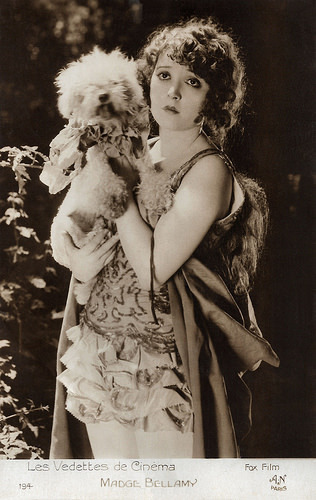
French postcard in the Les Vedettes de Cinéma serie by A.N., Paris, no. 194. Photo: Fox Film.
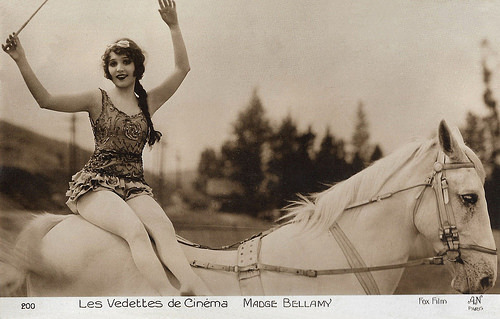
French postcard in the Les Vedettes de Cinéma serie by A.N., Paris, no. 200. Photo: Fox Film.
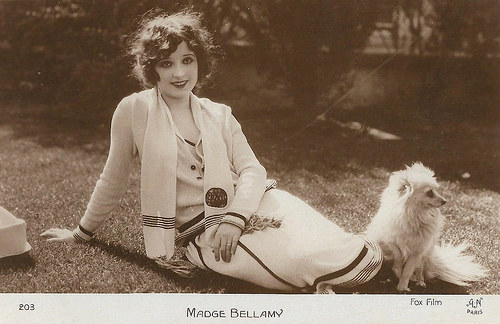
French postcard by A.N., Paris, no. 203. Photo: Fox Film.
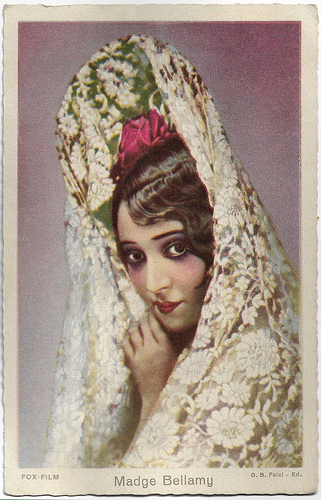
Italian postcard by G.B. Falci Ed. for Cioccolato Talmone al Latte Unica. Photo: Fox.
The Most Beautiful Girl On Broadway
Madge Bellamy was born Margaret Derden Philpott in Hillsboro, Texas, in 1899. She was the daughter of William Bledsoe Philpott, a professor of English, and Annie Margaret Derden. She was the cousin of the actor Tom Forman.
Raised in Texas, she lived in San Antonio until she was 6 years old. Then the family moved to Brownwood, also in Texas, where her father was teaching at Texas A&M University. Madge took dancing lessons and soon began to aspire to become a stage performer. She made her stage debut dancing in a local production of Aida, at the age of 9. When she turned 10, the Philpotts went to live in Denver, Colorado.
Shortly before she was to graduate from high school, Bellamy left home for New York City. She immediately found work on Broadway as a dancer. After appearing in the chorus of the Earl Carroll show The Love Mill (1917), she decided to try acting. In 1918, she was the protagonist of Pollyanna, a production that also took her on tour. Critics took notice and Madge was billed 'The Most Beautiful Girl On Broadway'.
In 1919, Madge met and married Carlos Bellamy in Colorado, but they divorced when she decided to leave Colorado to pursue her acting career. Her big break came when she replaced Helen Hayes in the Broadway production of Dear Brutus (1919) opposite William Gillette. Bellamy also appeared in the touring production of Dear Brutus.
While appearing in Dear Brutus, Bellamy was cast in a supporting role in her first film The Riddle: Woman (Edward José, 1920), starring Geraldine Farrar . In November 1920, she signed an exclusive contract with Thomas H. Ince, who wanted her for his new production company Triangle. Her first film for Triangle was The Cup of Life (Rowland V. Lee, 1921), starring Hobart Bosworth.
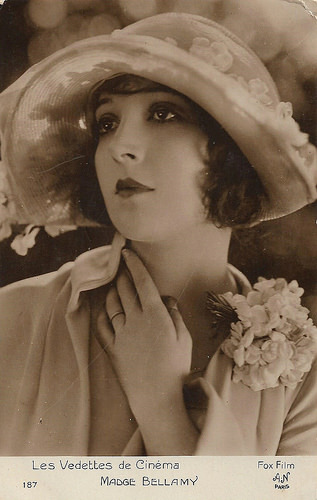
French postcard in the Les Vedettes de Cinéma series by A.N., Paris, no. 187. Photo: Fox Film.

German postcard by Ross Verlag, no. 1639/2, 1927-1928. Photo: Max Munn Autrey / Fox.
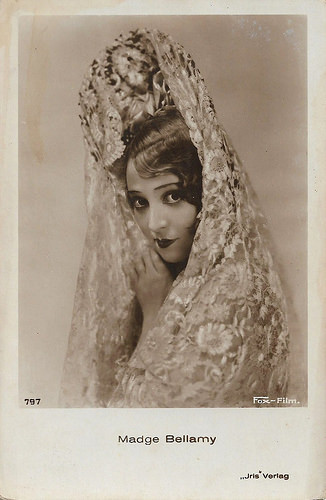
Austrian postcard by Iris Verlag, no. 797. Photo: Fox Film.
Arrested for Having Shot Three Times at her Former Lover
Madge Bellamy's breakthrough came in Lorna Doone (Maurice Tourneur, 1922) - hence she was 'the exquisite Madge'. For Triangle she appeared in several melodramas. When her contract with Ince ended she moved over to Fox, where she acted for John Ford in his first Western The Iron Horse (John Ford, 1924) with George O'Brien, and in the comedy Lightnin' (John Ford, 1925), with Jay Hunt.
As Bellamy favoured light comedy only, she got into trouble with the studios, as she refused a role in the mega-epic Ben-Hur (Fred Niblo, 1925), starring Ramon Novarro . Because of her off-set temperament, she was nicknamed 'Miss Firecracker' in the fan magazines. Her 1928 marriage to stockbroker Logan Metcalf lasted only four days. Metcalf filed for divorce claiming that while the two were on honeymoon, Bellamy had refused to speak to him because of his fondness for eating ham and eggs, which she considered 'plebeian'. Despite her poor behaviour off-set, she was still a fairly popular performer and was named an 'American Beauty' by the Hollywood Association of Foreign Correspondents
Madge did not encounter problems when switching from silent to sound. In 1928, Bellamy was cast in Fox's first part-talking film, Mother Knows Best (John G. Blystone, 1928), fictionalising the life of Vaudeville star Elsie Janis. However, in 1929, she left Fox. She walked out on her contract after refusing to star in the planned film adaptation of The Trial of Mary Dugan, a 1927 hit Broadway play that the studio had bought especially for Bellamy. The role was later given to Norma Shearer and The Trial of Mary Dugan (Bayard Veiller, 1929) became one of Shearer's biggest early successes.
Bellamy tried to find work as a freelance actress but did not work until 1932. Then she returned to the set to play in B-films for Poverty Row studios. Her best known film from this period is White Zombie (Victor Halperin, 1932) starring Bela Lugosi . The film got negative reviews, but was a great financial success for an independent film at the time. Today, White Zombie is a cult favourite and is described as the first feature length zombie film and as the archetype and model of all zombie movies.
Despite the relative success of White Zombie, the film career of Madge Bellamy went nowhere. By the mid 1930s she was reduced to bit parts and walk-on parts, and by the early 1940s, her career had virtually ended. In 1943, Bellamy was arrested for having shot three times at her at her former lover, wealthy lumber executive Albert Stanwood Murphy, after he deserted her to marry another woman. She was given a suspended six-month sentence and one year of probation. Bellamy made her last screen appearance in Northwest Trail (Derwin Abraham, 1945). She returned to the stage in 1946 in the Los Angeles production of Holiday Lady, after which she retired.
She had some holdings in real estate and owned a retail shop in which she worked to support herself. In her spare time, she wrote screenplays and novels which were never purchased. In the 1980s, Madge Bellamy was rediscovered by film historians and silent film fans. She sold the retail shop and lived in relative financial comfort for the rest of her life in Ontario, California. She died in 1990 in a hospital in Upland, California, at the age of 90. Her biography, A Darling of the Twenties, was published shortly after her death.
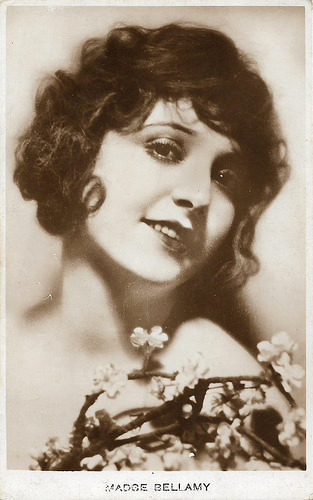
British Real Photograph postcard.
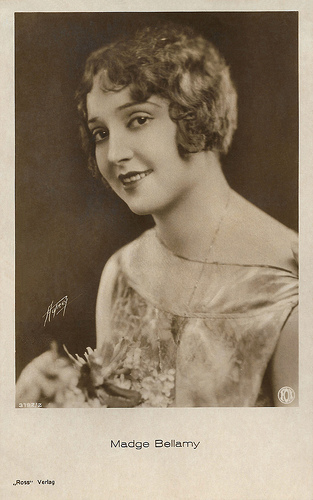
German postcard by Ross Verlag, no. 3192/2, 1928-1929. Photo: Max Munn Autrey / Fox Film.
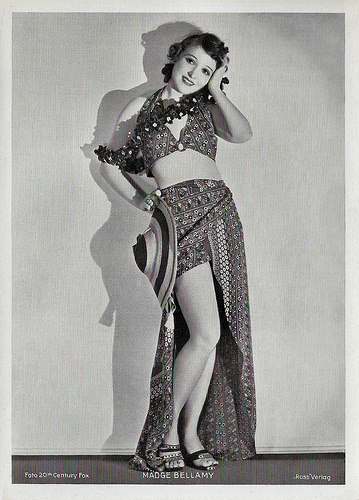
Big German card by Ross Verlag. Photo: 20th Century Fox.
Sources: (IMDb), Golden Silents, Wikipedia (English and Italian), and .

French postcard in the Les Vedettes de Cinéma serie by A.N., Paris, no. 194. Photo: Fox Film.

French postcard in the Les Vedettes de Cinéma serie by A.N., Paris, no. 200. Photo: Fox Film.

French postcard by A.N., Paris, no. 203. Photo: Fox Film.

Italian postcard by G.B. Falci Ed. for Cioccolato Talmone al Latte Unica. Photo: Fox.
The Most Beautiful Girl On Broadway
Madge Bellamy was born Margaret Derden Philpott in Hillsboro, Texas, in 1899. She was the daughter of William Bledsoe Philpott, a professor of English, and Annie Margaret Derden. She was the cousin of the actor Tom Forman.
Raised in Texas, she lived in San Antonio until she was 6 years old. Then the family moved to Brownwood, also in Texas, where her father was teaching at Texas A&M University. Madge took dancing lessons and soon began to aspire to become a stage performer. She made her stage debut dancing in a local production of Aida, at the age of 9. When she turned 10, the Philpotts went to live in Denver, Colorado.
Shortly before she was to graduate from high school, Bellamy left home for New York City. She immediately found work on Broadway as a dancer. After appearing in the chorus of the Earl Carroll show The Love Mill (1917), she decided to try acting. In 1918, she was the protagonist of Pollyanna, a production that also took her on tour. Critics took notice and Madge was billed 'The Most Beautiful Girl On Broadway'.
In 1919, Madge met and married Carlos Bellamy in Colorado, but they divorced when she decided to leave Colorado to pursue her acting career. Her big break came when she replaced Helen Hayes in the Broadway production of Dear Brutus (1919) opposite William Gillette. Bellamy also appeared in the touring production of Dear Brutus.
While appearing in Dear Brutus, Bellamy was cast in a supporting role in her first film The Riddle: Woman (Edward José, 1920), starring Geraldine Farrar . In November 1920, she signed an exclusive contract with Thomas H. Ince, who wanted her for his new production company Triangle. Her first film for Triangle was The Cup of Life (Rowland V. Lee, 1921), starring Hobart Bosworth.

French postcard in the Les Vedettes de Cinéma series by A.N., Paris, no. 187. Photo: Fox Film.

German postcard by Ross Verlag, no. 1639/2, 1927-1928. Photo: Max Munn Autrey / Fox.

Austrian postcard by Iris Verlag, no. 797. Photo: Fox Film.
Arrested for Having Shot Three Times at her Former Lover
Madge Bellamy's breakthrough came in Lorna Doone (Maurice Tourneur, 1922) - hence she was 'the exquisite Madge'. For Triangle she appeared in several melodramas. When her contract with Ince ended she moved over to Fox, where she acted for John Ford in his first Western The Iron Horse (John Ford, 1924) with George O'Brien, and in the comedy Lightnin' (John Ford, 1925), with Jay Hunt.
As Bellamy favoured light comedy only, she got into trouble with the studios, as she refused a role in the mega-epic Ben-Hur (Fred Niblo, 1925), starring Ramon Novarro . Because of her off-set temperament, she was nicknamed 'Miss Firecracker' in the fan magazines. Her 1928 marriage to stockbroker Logan Metcalf lasted only four days. Metcalf filed for divorce claiming that while the two were on honeymoon, Bellamy had refused to speak to him because of his fondness for eating ham and eggs, which she considered 'plebeian'. Despite her poor behaviour off-set, she was still a fairly popular performer and was named an 'American Beauty' by the Hollywood Association of Foreign Correspondents
Madge did not encounter problems when switching from silent to sound. In 1928, Bellamy was cast in Fox's first part-talking film, Mother Knows Best (John G. Blystone, 1928), fictionalising the life of Vaudeville star Elsie Janis. However, in 1929, she left Fox. She walked out on her contract after refusing to star in the planned film adaptation of The Trial of Mary Dugan, a 1927 hit Broadway play that the studio had bought especially for Bellamy. The role was later given to Norma Shearer and The Trial of Mary Dugan (Bayard Veiller, 1929) became one of Shearer's biggest early successes.
Bellamy tried to find work as a freelance actress but did not work until 1932. Then she returned to the set to play in B-films for Poverty Row studios. Her best known film from this period is White Zombie (Victor Halperin, 1932) starring Bela Lugosi . The film got negative reviews, but was a great financial success for an independent film at the time. Today, White Zombie is a cult favourite and is described as the first feature length zombie film and as the archetype and model of all zombie movies.
Despite the relative success of White Zombie, the film career of Madge Bellamy went nowhere. By the mid 1930s she was reduced to bit parts and walk-on parts, and by the early 1940s, her career had virtually ended. In 1943, Bellamy was arrested for having shot three times at her at her former lover, wealthy lumber executive Albert Stanwood Murphy, after he deserted her to marry another woman. She was given a suspended six-month sentence and one year of probation. Bellamy made her last screen appearance in Northwest Trail (Derwin Abraham, 1945). She returned to the stage in 1946 in the Los Angeles production of Holiday Lady, after which she retired.
She had some holdings in real estate and owned a retail shop in which she worked to support herself. In her spare time, she wrote screenplays and novels which were never purchased. In the 1980s, Madge Bellamy was rediscovered by film historians and silent film fans. She sold the retail shop and lived in relative financial comfort for the rest of her life in Ontario, California. She died in 1990 in a hospital in Upland, California, at the age of 90. Her biography, A Darling of the Twenties, was published shortly after her death.

British Real Photograph postcard.

German postcard by Ross Verlag, no. 3192/2, 1928-1929. Photo: Max Munn Autrey / Fox Film.

Big German card by Ross Verlag. Photo: 20th Century Fox.
Sources: (IMDb), Golden Silents, Wikipedia (English and Italian), and .
Published on December 15, 2018 22:00
December 14, 2018
Photo by First National Pictures
First National Pictures was an American film production and distribution company. It was founded in 1917 as First National Exhibitors' Circuit, Inc., an association of independent theatre owners in the United States, and became the country's largest theatre chain. Expanding from exhibiting films to distributing them, the company reincorporated in 1919 as Associated First National Theatres, Inc., and Associated First National Pictures, Inc. Approaching stars' and directors' production companies as a direct buyer, First National eventually signed Charlie Chaplin, Jackie Coogan, Mary Pickford, Norma and Constance Talmadge. In 1924 it expanded to become a film production company as First National Pictures, Inc., and became an important studio in the film industry. Among the major players the studio had under contract by then were Richard Barthelmess, Barbara La Marr, Harry Langdon, Colleen Moore, and Alla Nazimova. In September 1928, control of First National passed to Warner Bros., into which it was completely absorbed in November 1929.
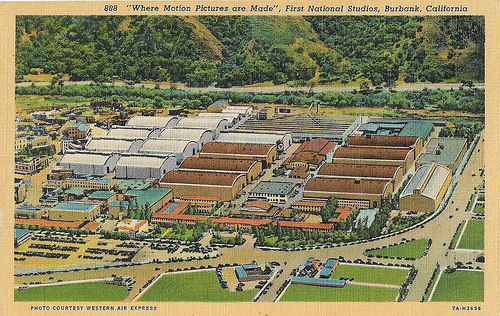
American postcard by Western Air Express, no. 888. Caption: 'Where Motion Pictures Are Made' An overview of the First National Pictures studio complex in the mid-/late 1920s.
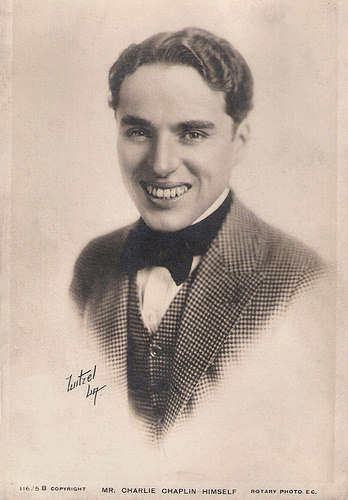
Charlie Chaplin . British postcard by Rotary Photo, no. 11575B. Photo: Albert Witzel.
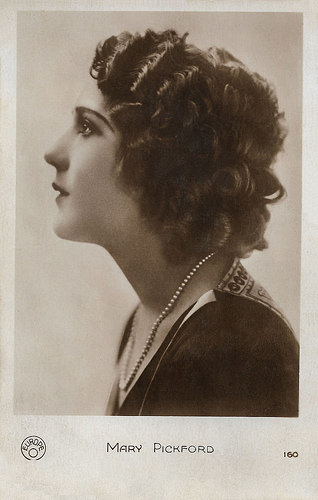
Mary Pickford. French postcard by Europe, no. 160.
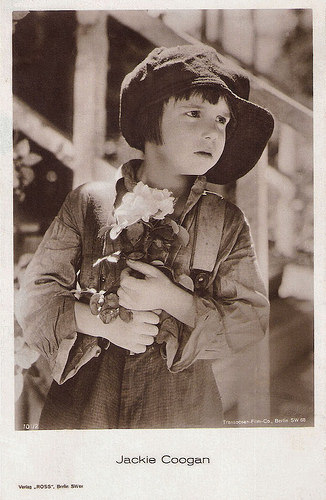
Jackie Coogan. German postcard by Ross Verlag, no. 701/2, 1925-1926. Photo: Transocean-Film-Company, Berlin.
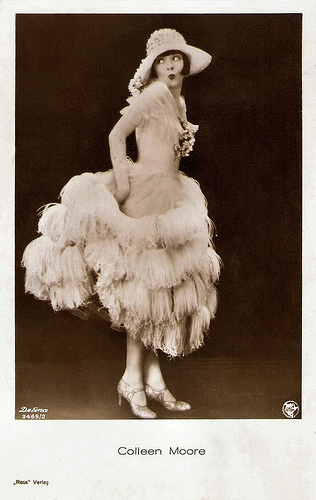
Colleen Moore. German postcard by Ross Verlag, no. 3469/2, 1928-1929. Photo: DeFina / First National Pictures.
Against high cost rentals, block-booking, and inferior prints
The First National Exhibitors' Circuit was founded in 1917 by the merger of 26 of the biggest first-run cinema chains in the United States. It eventually controlled over 600 cinemas, more than 200 of them first-run houses as opposed to the less lucrative second-run or neighbourhood theatres to which films moved when their initial box office receipts dwindled.
First National was the brainchild of Thomas L. Tally, who was reacting to the many problems exhibitors had experienced with established distributors, such as the high cost of rentals, block-booking, and the inferior quality of some prints. The exhibitors also wanted to bypass distributors such as Adolph Zukor's Paramount, which had begun to try to control all aspects of the film industry.
In 1912, Tally thought that a conglomerate of theatres throughout the nation could buy or produce and distribute its own films. In 1917 Tally and J. D. Williams formed First National Exhibitors' Circuit. The first film released through First National was the British film, The Mother of Dartmoor (George Loane Tucker, 1916).
A success was Tarzan of the Apes (Scott Sidney, 1918) starring Elmo Lincoln as the first screen Tarzan and based on Edgar Rice Burroughs' original novel Tarzan of the Apes. The film adapts only the first part of the novel, the remainder becoming the basis for the sequel, The Romance of Tarzan (Wilfred Lucas, 1918) starring Elmo Lincoln and Enid Markey.
Between 1917 and 1918, the company made contracts with Mary Pickford and Charlie Chaplin , the first million-dollar deals in the history of film. Daddy-Long-Legs (Marshall Neilan, 1919) was produced by Mary Pickford, and based on Jean Webster's novel Daddy-Long-Legs. A Dog's Life (Charles Chaplin, 1918) was Chaplin's first film for First National Films. Chaplin's contract allowed him to produce his films without a set release schedule.
However, the production of the feature film The Kid (Charles Chaplin, 1921) ran so long that the company started to complain. To address their concerns Chaplin invited the exhibitors to the studio, and they were so impressed by the project and charmed by the players, especially co-star Jackie Coogan, that they agreed to be patient. That patience was ultimately rewarded when The Kid became a major critical and box office success.
First National's distribution of films by independent producers is credited with launching careers including that of Louis B. Mayer. Mayer produced the Western In Old Kentucky (Marshall Neilan, 1919) starring Anita Stewart. Neilan and Mayer worked often together, but after Mayer became head of MGM in 1924, the two had a falling out.
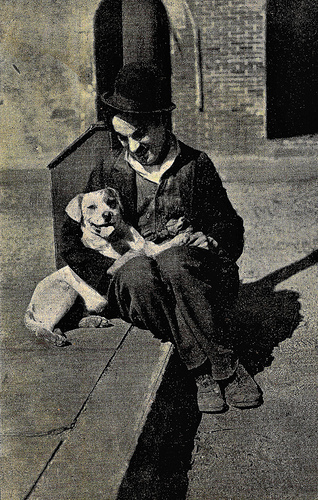
Charlie Chaplin . Spanish postcard by Chocolate Amatller, serie 9, no. 11. Photo: publicity still for A Dog's Life (Charles Chaplin, 1918).
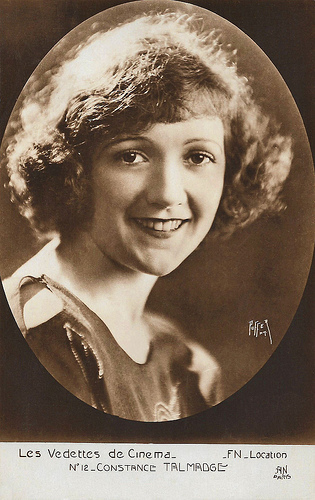
Constance Talmadge. French postcard by A.N., Paris in the Les Vedettes de Cinéma series, no. 12. Photo: B. Frank Puffer / First National Location.

Norma Talmadge. French postcard by J.R.D.R., Paris, no. 104. Photo: First National. Publicity still for Camille (Fred Niblo, 1926), produced by Joseph Schenck, the later producer of United Artists, and based on the famous novel by Alexandre Dumas fils.
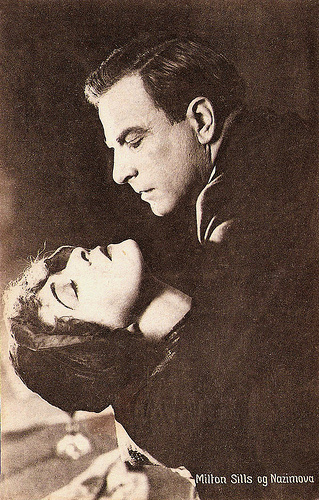
Nazimova and Milton Sills. Danish postcard by Stenders Kunstforlag, no. 39. Photo: First National Pictures. Publicity still for Madonna of the Streets (Edwin Carewe, 1924).
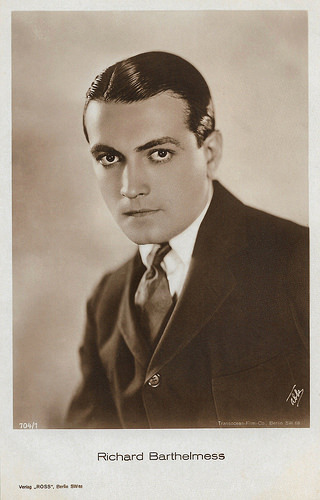
Richard Barthelmess. German postcard by Ross Verlag, no. 704/1, 1925-1926. Photo: James Abbe / Transocean-Film-Co., Berlin.
A rustic tale of violence set in the mountains of West Virginia
Adolph Zukor of Paramount Pictures was threatened by First National's financial power and its control over the lucrative first-run theatres, and decided to enter the cinema business as well. With a $10 million investment, Paramount built its own chain of first-run movie theatres after a secret plan to merge with First National failed.
First National Exhibitors' Circuit was reincorporated in 1919 as Associated First National Pictures, Inc., and its subsidiary, Associated First National Theatres, Inc., with 5,000 independent theatre owners as members. First National had new successes with Constance Talmadge in the comedy A Virtuous Vamp (David Kirkland, Sidney Franklin, 1919). It was produced by Talmadge and written by Anita Loos and John Emerson based on the 1909 play The Bachelor by Clyde Fitch. Anita Loos also wrote Two Weeks (Sidney Franklin, 1920), starring Constance Talmadge and Conway Tearle.
Sister Norma Talmadge starred in such dramas as A Daughter of Two Worlds (James Young, 1920), The Branded Woman (Albert Parker, 1920). The latter was also produced by Talmadge with her husband Joseph Schenck through their production company, Norma Talmadge Productions. Later followed such hits as Camille (Fred Niblo, 1926).
Director King Vidor also worked for First National, such as on the drama The Family Honor (King Vidor, 1920) with Florence Vidor. A major box office success was Tol'able David (Henry King, 1921) starring Richard Barthelmess. It was a rustic tale of violence set in the Allegheny Mountains of eastern West Virginia. The acclaimed film was voted the 1921 Photoplay Magazine Medal of Honor and is seen by now as one of the classics of silent film.
Associated First National Pictures expanded from only distributing films to producing them in 1924 and changed its corporate name to First National Pictures, Inc. It built its 62-acre (25 ha) studio lot in Burbank in 1926. The Motion Picture Theatre Owners of America and the Independent Producers' Association declared war in 1925 on what they termed a common enemy — the ‘film trust’ of Metro-Goldwyn-Mayer, Paramount, and First National, which they claimed dominated the industry not only by producing and distributing films but also by entering into exhibition as well.
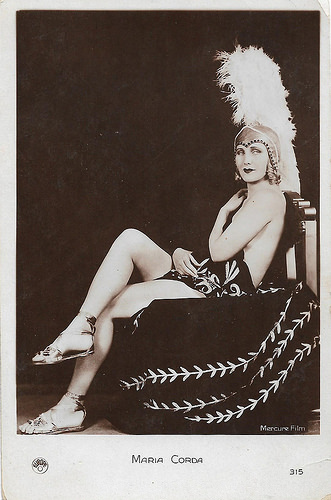
French postcard by Europe, no. 315. Photo: Mercure Film. Maria Corda as Helen of Troy in The Private Life of Helen of Troy (Alexander Korda, 1927).
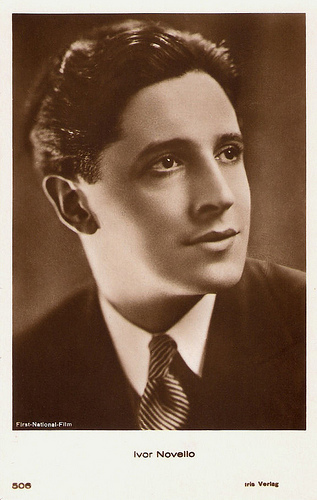
Ivor Novello . Austrian postcard by Iris Verlag, nr. 506. Photo: First National Film.
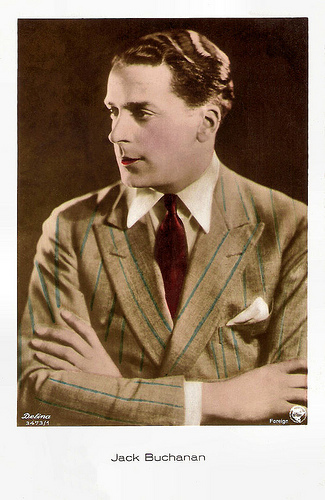
Jack Buchanan . British postcard in the real hand-coloured photograph series, no. 136. Photo: Defina / First National.
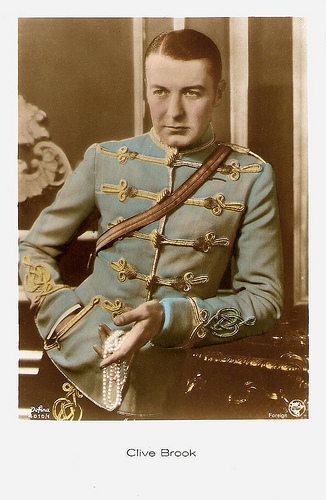
Clive Brook . British postcard, no. 4010/1. Photo: Defina / First National Pictures. Publicity still for Yellow Lily (Alexander Korda, 1928).
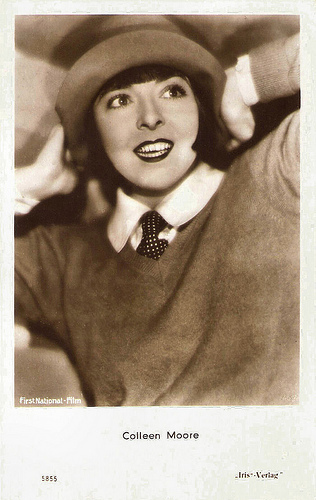
Colleen Moore. Austrian postcard by Iris-Verlag, no. 5855. Photo: First National-Film.
The Flapper - a new kind of female behaviour
Madge Bellamy became a star with Lorna Doone (Maurice Tourneur, 1922) a film version of Richard Doddridge Blackmore's often filmed novel. Another success was Oliver Twist (Frank Lloyd, 1922), a silent film adaptation of Charles Dickens' classic novel, featuring Lon Chaney as Fagin and Jackie Coogan at the height of his success as Oliver.
One of the major directors at First National was John M. Stahl who made such dramas The Dangerous Age (John M. Stahl, 1923) starring Lewis Stone. Another interesting director was Frank Borzage who directed the drama The Age of Desire (Frank Borzage, 1923) starring Josef Swickard, William Collier Jr., and Mary Philbin.
A popular success was Potash and Perlmutter (Clarence G. Badger, 1923), based on an ethnic Jewish comedy with characters created by Montague Glass and Charles Klein. This film was the first production of Samuel Goldwyn's independent production company. Stage stars Alexander Carr and Barney Bernard reprise their famous roles in this film. The film's success would inspire two Goldwyn sequels, In Hollywood with Potash and Perlmutter (Alfred E. Green, 1924) and Partners Again (Henry King, 1926), but the latter was distributed by United Artists.
Associated First National both distributed and produced the drama Flaming Youth (John Francis Dillon, 1923) starring vivid Colleen Moore and Milton Sills. The reaction to the film was enthusiastic, and it firmly fixed in the public's imagination a new kind of female behaviour. There had been several films prior to Flaming Youth which used the flapper as subject matter, such as The Flapper (Alan Crosland, 1920) with Olive Thomas, but the financial success of Flaming Youth made it the film credited with launching a cycle of pictures about flappers and helping Colleen Moore be seen as the original film flapper.
Blanche Sweet was the star of the silent film version of Anna Christie (John Griffith Wray, 1923) based on the 1921 play by Eugene O'Neill. Producer Thomas H. Ince paid a then-astronomical $35,000 for the screen rights to the play. Another success was the fantasy monster adventure film The Lost World (Harry O. Hoyt, 1925) adapted from Arthur Conan Doyle's 1912 novel of the same name. The film stars Wallace Beery as Professor Challenger and featured pioneering stop motion special effects by Willis O'Brien, a forerunner of his work on the original King Kong (1933).
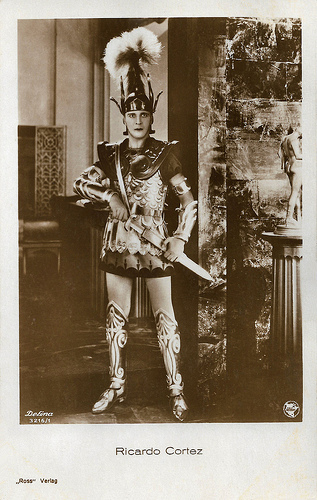
German postcard by Ross Verlag, no. 3216/1, 1928-1929. Photo: Defina / First national. Publicity still for The Private Life of Helen of Troy (Alexander Korda, 1927), in which Ricardo Cortez co-starred as Paris opposite Maria Corda as Helen of Troy.
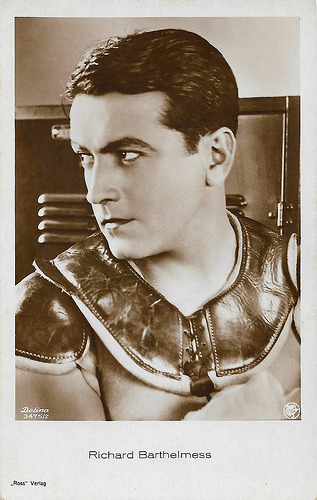
Richard Barthelmess. German postcard by Ross Verlag, no. 3475/2, 1928-1929. Photo: Defina / First National. Publicity still for The Drop-Kick (Millard Webb, 1927).
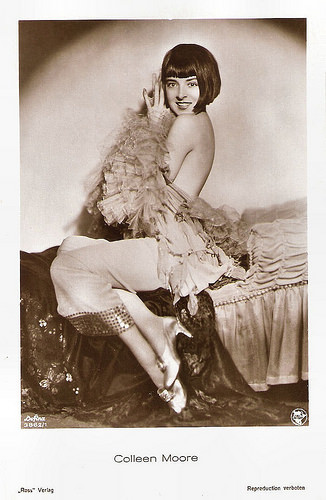
Colleen Moore. German postcard by Ross Verlag, no. 3862/1, 1928-1929. Photo: Defina / First-National-Film.
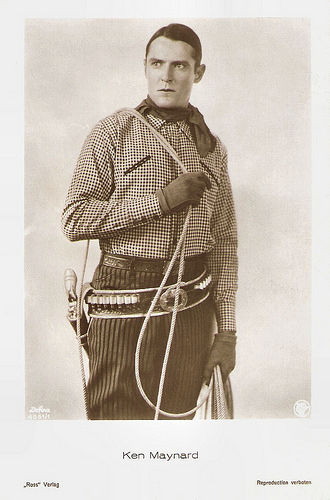
Ken Maynard. German postcard by Ross Verlag, no. 4561/1, 1929-1930. Photo: Defina / First National Pictures.
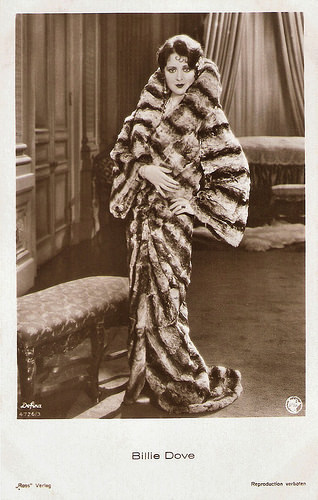
Billie Dove . German postcard by Ross Verlag, no. 4726/3, 1929-1930. Photo: Defina / First National.
The First National studio as the official home of Warner Bros
The financial success of The Jazz Singer (Alan Crosland, 1927) and The Singing Fool (Lloyd Bacon, 1928), both with Al Jolson, enabled Warner Bros. to purchase a majority interest in First National in September 1928. Warner Bros. held 42,000 shares of common stock out of 72,000 outstanding shares while Fox Pictures held 21,000 shares; 12,000 shares were publicly held.
Warner Bros. acquired access to First National's affiliated chain of theatres, while First National acquired access to Vitaphone sound equipment. Warner Bros. and First National continued to operate as separate entities. On November 4, 1929, Fox sold its interest in First National to Warner Bros. for $10 million.
The First National studio in Burbank became the official home of Warner Bros.–First National Pictures. Thereafter, First National Pictures became a trade name for the distribution of a designated segment of Warner Bros. product. Forty-five of the 86 Warner Bros. feature films released in 1929 were branded as First National Pictures. Half of the 60 feature films Warner Bros. announced for release in 1933–1934 were to be First National Pictures.
Although both studios produced A and B budget pictures, generally the prestige productions, costume dramas, and musicals were made by Warner Bros., while First National specialised in modern comedies, dramas, and crime stories. Short subjects were made by yet another affiliated company, The Vitaphone Corporation, which took its name from the sound process.
In July 1936, stockholders of First National Pictures, Inc. (primarily Warner Bros.) voted to dissolve the corporation and distribute its assets among the stockholders in line with a new tax law which provided for tax-free consolidations between corporations. From 1929 to 1958, most Warner Bros. films and promotional posters bore the combined trademark and copyright credits in the opening and closing sequences ‘A Warner Bros.–First National Picture’.
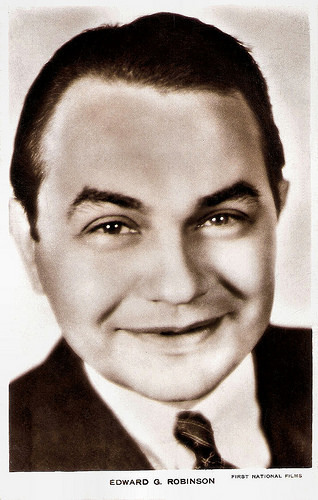
Edward G. Robinson . British postcard. Photo: First National Films.
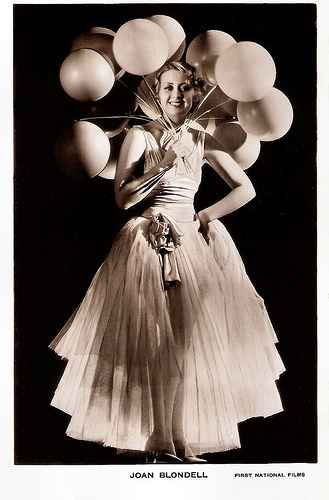
Joan Blondell. British postcard. Photo: First National Films.
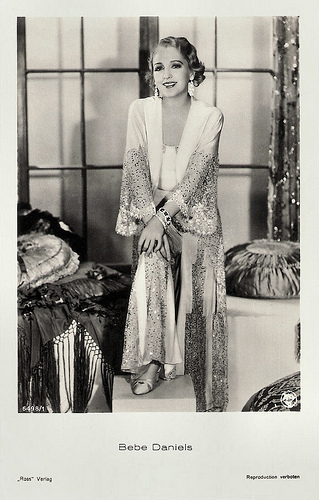
Bebe Daniels . German postcard by Ross Verlag, no. 6498/1, 1931-1932. Photo: First National Pictures. Publicity still for Honor of the Family (Lloyd Bacon, 1931).
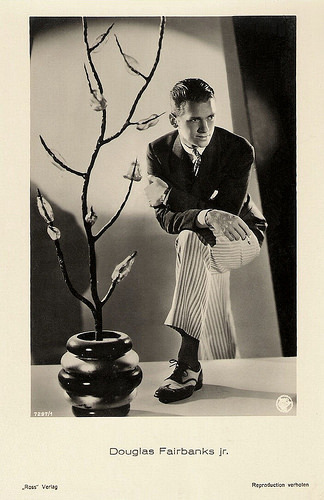
Douglas Fairbanks Jr . German postcard by Ross Verlag, no. 7297/1, 1932-1933. Photo: First National Pictures.
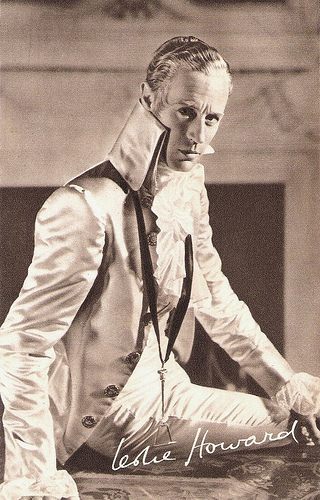
Leslie Howard . British postcard by Real Photogravure, London, no. 64. Photo: Warner Brothers / First National. Publicity still for The Scarlet Pimpernel (Harold Young, 1934).
Sources: Encyclopaedia Britannica, Oscars.org, and Wikipedia.

American postcard by Western Air Express, no. 888. Caption: 'Where Motion Pictures Are Made' An overview of the First National Pictures studio complex in the mid-/late 1920s.

Charlie Chaplin . British postcard by Rotary Photo, no. 11575B. Photo: Albert Witzel.

Mary Pickford. French postcard by Europe, no. 160.

Jackie Coogan. German postcard by Ross Verlag, no. 701/2, 1925-1926. Photo: Transocean-Film-Company, Berlin.

Colleen Moore. German postcard by Ross Verlag, no. 3469/2, 1928-1929. Photo: DeFina / First National Pictures.
Against high cost rentals, block-booking, and inferior prints
The First National Exhibitors' Circuit was founded in 1917 by the merger of 26 of the biggest first-run cinema chains in the United States. It eventually controlled over 600 cinemas, more than 200 of them first-run houses as opposed to the less lucrative second-run or neighbourhood theatres to which films moved when their initial box office receipts dwindled.
First National was the brainchild of Thomas L. Tally, who was reacting to the many problems exhibitors had experienced with established distributors, such as the high cost of rentals, block-booking, and the inferior quality of some prints. The exhibitors also wanted to bypass distributors such as Adolph Zukor's Paramount, which had begun to try to control all aspects of the film industry.
In 1912, Tally thought that a conglomerate of theatres throughout the nation could buy or produce and distribute its own films. In 1917 Tally and J. D. Williams formed First National Exhibitors' Circuit. The first film released through First National was the British film, The Mother of Dartmoor (George Loane Tucker, 1916).
A success was Tarzan of the Apes (Scott Sidney, 1918) starring Elmo Lincoln as the first screen Tarzan and based on Edgar Rice Burroughs' original novel Tarzan of the Apes. The film adapts only the first part of the novel, the remainder becoming the basis for the sequel, The Romance of Tarzan (Wilfred Lucas, 1918) starring Elmo Lincoln and Enid Markey.
Between 1917 and 1918, the company made contracts with Mary Pickford and Charlie Chaplin , the first million-dollar deals in the history of film. Daddy-Long-Legs (Marshall Neilan, 1919) was produced by Mary Pickford, and based on Jean Webster's novel Daddy-Long-Legs. A Dog's Life (Charles Chaplin, 1918) was Chaplin's first film for First National Films. Chaplin's contract allowed him to produce his films without a set release schedule.
However, the production of the feature film The Kid (Charles Chaplin, 1921) ran so long that the company started to complain. To address their concerns Chaplin invited the exhibitors to the studio, and they were so impressed by the project and charmed by the players, especially co-star Jackie Coogan, that they agreed to be patient. That patience was ultimately rewarded when The Kid became a major critical and box office success.
First National's distribution of films by independent producers is credited with launching careers including that of Louis B. Mayer. Mayer produced the Western In Old Kentucky (Marshall Neilan, 1919) starring Anita Stewart. Neilan and Mayer worked often together, but after Mayer became head of MGM in 1924, the two had a falling out.

Charlie Chaplin . Spanish postcard by Chocolate Amatller, serie 9, no. 11. Photo: publicity still for A Dog's Life (Charles Chaplin, 1918).

Constance Talmadge. French postcard by A.N., Paris in the Les Vedettes de Cinéma series, no. 12. Photo: B. Frank Puffer / First National Location.

Norma Talmadge. French postcard by J.R.D.R., Paris, no. 104. Photo: First National. Publicity still for Camille (Fred Niblo, 1926), produced by Joseph Schenck, the later producer of United Artists, and based on the famous novel by Alexandre Dumas fils.

Nazimova and Milton Sills. Danish postcard by Stenders Kunstforlag, no. 39. Photo: First National Pictures. Publicity still for Madonna of the Streets (Edwin Carewe, 1924).

Richard Barthelmess. German postcard by Ross Verlag, no. 704/1, 1925-1926. Photo: James Abbe / Transocean-Film-Co., Berlin.
A rustic tale of violence set in the mountains of West Virginia
Adolph Zukor of Paramount Pictures was threatened by First National's financial power and its control over the lucrative first-run theatres, and decided to enter the cinema business as well. With a $10 million investment, Paramount built its own chain of first-run movie theatres after a secret plan to merge with First National failed.
First National Exhibitors' Circuit was reincorporated in 1919 as Associated First National Pictures, Inc., and its subsidiary, Associated First National Theatres, Inc., with 5,000 independent theatre owners as members. First National had new successes with Constance Talmadge in the comedy A Virtuous Vamp (David Kirkland, Sidney Franklin, 1919). It was produced by Talmadge and written by Anita Loos and John Emerson based on the 1909 play The Bachelor by Clyde Fitch. Anita Loos also wrote Two Weeks (Sidney Franklin, 1920), starring Constance Talmadge and Conway Tearle.
Sister Norma Talmadge starred in such dramas as A Daughter of Two Worlds (James Young, 1920), The Branded Woman (Albert Parker, 1920). The latter was also produced by Talmadge with her husband Joseph Schenck through their production company, Norma Talmadge Productions. Later followed such hits as Camille (Fred Niblo, 1926).
Director King Vidor also worked for First National, such as on the drama The Family Honor (King Vidor, 1920) with Florence Vidor. A major box office success was Tol'able David (Henry King, 1921) starring Richard Barthelmess. It was a rustic tale of violence set in the Allegheny Mountains of eastern West Virginia. The acclaimed film was voted the 1921 Photoplay Magazine Medal of Honor and is seen by now as one of the classics of silent film.
Associated First National Pictures expanded from only distributing films to producing them in 1924 and changed its corporate name to First National Pictures, Inc. It built its 62-acre (25 ha) studio lot in Burbank in 1926. The Motion Picture Theatre Owners of America and the Independent Producers' Association declared war in 1925 on what they termed a common enemy — the ‘film trust’ of Metro-Goldwyn-Mayer, Paramount, and First National, which they claimed dominated the industry not only by producing and distributing films but also by entering into exhibition as well.

French postcard by Europe, no. 315. Photo: Mercure Film. Maria Corda as Helen of Troy in The Private Life of Helen of Troy (Alexander Korda, 1927).

Ivor Novello . Austrian postcard by Iris Verlag, nr. 506. Photo: First National Film.

Jack Buchanan . British postcard in the real hand-coloured photograph series, no. 136. Photo: Defina / First National.

Clive Brook . British postcard, no. 4010/1. Photo: Defina / First National Pictures. Publicity still for Yellow Lily (Alexander Korda, 1928).

Colleen Moore. Austrian postcard by Iris-Verlag, no. 5855. Photo: First National-Film.
The Flapper - a new kind of female behaviour
Madge Bellamy became a star with Lorna Doone (Maurice Tourneur, 1922) a film version of Richard Doddridge Blackmore's often filmed novel. Another success was Oliver Twist (Frank Lloyd, 1922), a silent film adaptation of Charles Dickens' classic novel, featuring Lon Chaney as Fagin and Jackie Coogan at the height of his success as Oliver.
One of the major directors at First National was John M. Stahl who made such dramas The Dangerous Age (John M. Stahl, 1923) starring Lewis Stone. Another interesting director was Frank Borzage who directed the drama The Age of Desire (Frank Borzage, 1923) starring Josef Swickard, William Collier Jr., and Mary Philbin.
A popular success was Potash and Perlmutter (Clarence G. Badger, 1923), based on an ethnic Jewish comedy with characters created by Montague Glass and Charles Klein. This film was the first production of Samuel Goldwyn's independent production company. Stage stars Alexander Carr and Barney Bernard reprise their famous roles in this film. The film's success would inspire two Goldwyn sequels, In Hollywood with Potash and Perlmutter (Alfred E. Green, 1924) and Partners Again (Henry King, 1926), but the latter was distributed by United Artists.
Associated First National both distributed and produced the drama Flaming Youth (John Francis Dillon, 1923) starring vivid Colleen Moore and Milton Sills. The reaction to the film was enthusiastic, and it firmly fixed in the public's imagination a new kind of female behaviour. There had been several films prior to Flaming Youth which used the flapper as subject matter, such as The Flapper (Alan Crosland, 1920) with Olive Thomas, but the financial success of Flaming Youth made it the film credited with launching a cycle of pictures about flappers and helping Colleen Moore be seen as the original film flapper.
Blanche Sweet was the star of the silent film version of Anna Christie (John Griffith Wray, 1923) based on the 1921 play by Eugene O'Neill. Producer Thomas H. Ince paid a then-astronomical $35,000 for the screen rights to the play. Another success was the fantasy monster adventure film The Lost World (Harry O. Hoyt, 1925) adapted from Arthur Conan Doyle's 1912 novel of the same name. The film stars Wallace Beery as Professor Challenger and featured pioneering stop motion special effects by Willis O'Brien, a forerunner of his work on the original King Kong (1933).

German postcard by Ross Verlag, no. 3216/1, 1928-1929. Photo: Defina / First national. Publicity still for The Private Life of Helen of Troy (Alexander Korda, 1927), in which Ricardo Cortez co-starred as Paris opposite Maria Corda as Helen of Troy.

Richard Barthelmess. German postcard by Ross Verlag, no. 3475/2, 1928-1929. Photo: Defina / First National. Publicity still for The Drop-Kick (Millard Webb, 1927).

Colleen Moore. German postcard by Ross Verlag, no. 3862/1, 1928-1929. Photo: Defina / First-National-Film.

Ken Maynard. German postcard by Ross Verlag, no. 4561/1, 1929-1930. Photo: Defina / First National Pictures.

Billie Dove . German postcard by Ross Verlag, no. 4726/3, 1929-1930. Photo: Defina / First National.
The First National studio as the official home of Warner Bros
The financial success of The Jazz Singer (Alan Crosland, 1927) and The Singing Fool (Lloyd Bacon, 1928), both with Al Jolson, enabled Warner Bros. to purchase a majority interest in First National in September 1928. Warner Bros. held 42,000 shares of common stock out of 72,000 outstanding shares while Fox Pictures held 21,000 shares; 12,000 shares were publicly held.
Warner Bros. acquired access to First National's affiliated chain of theatres, while First National acquired access to Vitaphone sound equipment. Warner Bros. and First National continued to operate as separate entities. On November 4, 1929, Fox sold its interest in First National to Warner Bros. for $10 million.
The First National studio in Burbank became the official home of Warner Bros.–First National Pictures. Thereafter, First National Pictures became a trade name for the distribution of a designated segment of Warner Bros. product. Forty-five of the 86 Warner Bros. feature films released in 1929 were branded as First National Pictures. Half of the 60 feature films Warner Bros. announced for release in 1933–1934 were to be First National Pictures.
Although both studios produced A and B budget pictures, generally the prestige productions, costume dramas, and musicals were made by Warner Bros., while First National specialised in modern comedies, dramas, and crime stories. Short subjects were made by yet another affiliated company, The Vitaphone Corporation, which took its name from the sound process.
In July 1936, stockholders of First National Pictures, Inc. (primarily Warner Bros.) voted to dissolve the corporation and distribute its assets among the stockholders in line with a new tax law which provided for tax-free consolidations between corporations. From 1929 to 1958, most Warner Bros. films and promotional posters bore the combined trademark and copyright credits in the opening and closing sequences ‘A Warner Bros.–First National Picture’.

Edward G. Robinson . British postcard. Photo: First National Films.

Joan Blondell. British postcard. Photo: First National Films.

Bebe Daniels . German postcard by Ross Verlag, no. 6498/1, 1931-1932. Photo: First National Pictures. Publicity still for Honor of the Family (Lloyd Bacon, 1931).

Douglas Fairbanks Jr . German postcard by Ross Verlag, no. 7297/1, 1932-1933. Photo: First National Pictures.

Leslie Howard . British postcard by Real Photogravure, London, no. 64. Photo: Warner Brothers / First National. Publicity still for The Scarlet Pimpernel (Harold Young, 1934).
Sources: Encyclopaedia Britannica, Oscars.org, and Wikipedia.
Published on December 14, 2018 22:00
Paul van Yperen's Blog
- Paul van Yperen's profile
- 13 followers
Paul van Yperen isn't a Goodreads Author
(yet),
but they
do have a blog,
so here are some recent posts imported from
their feed.



